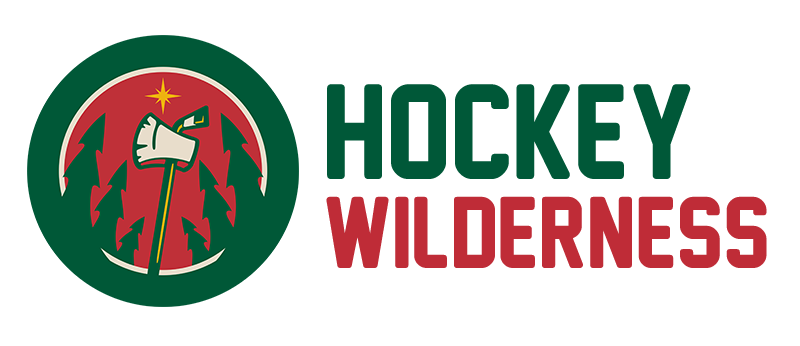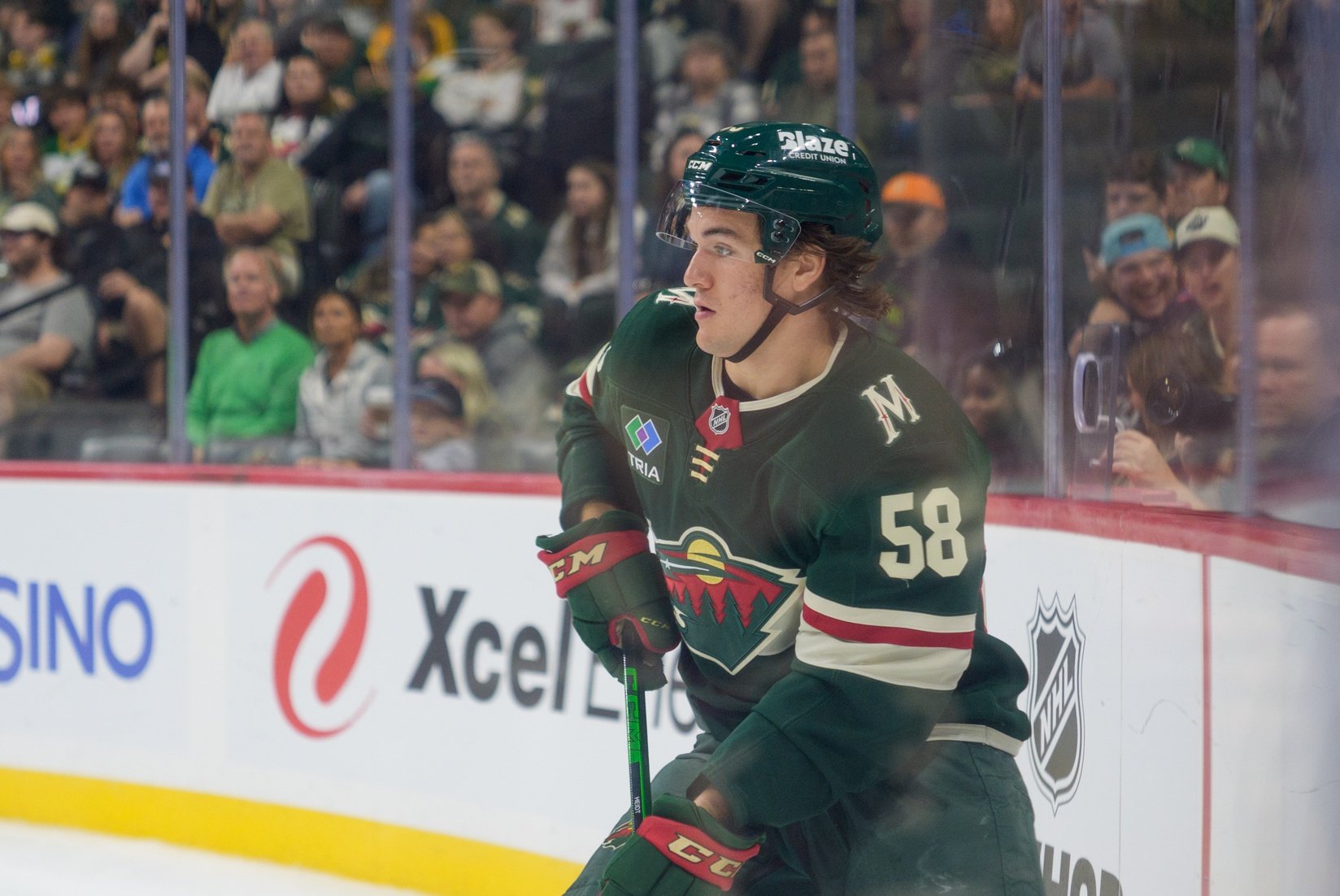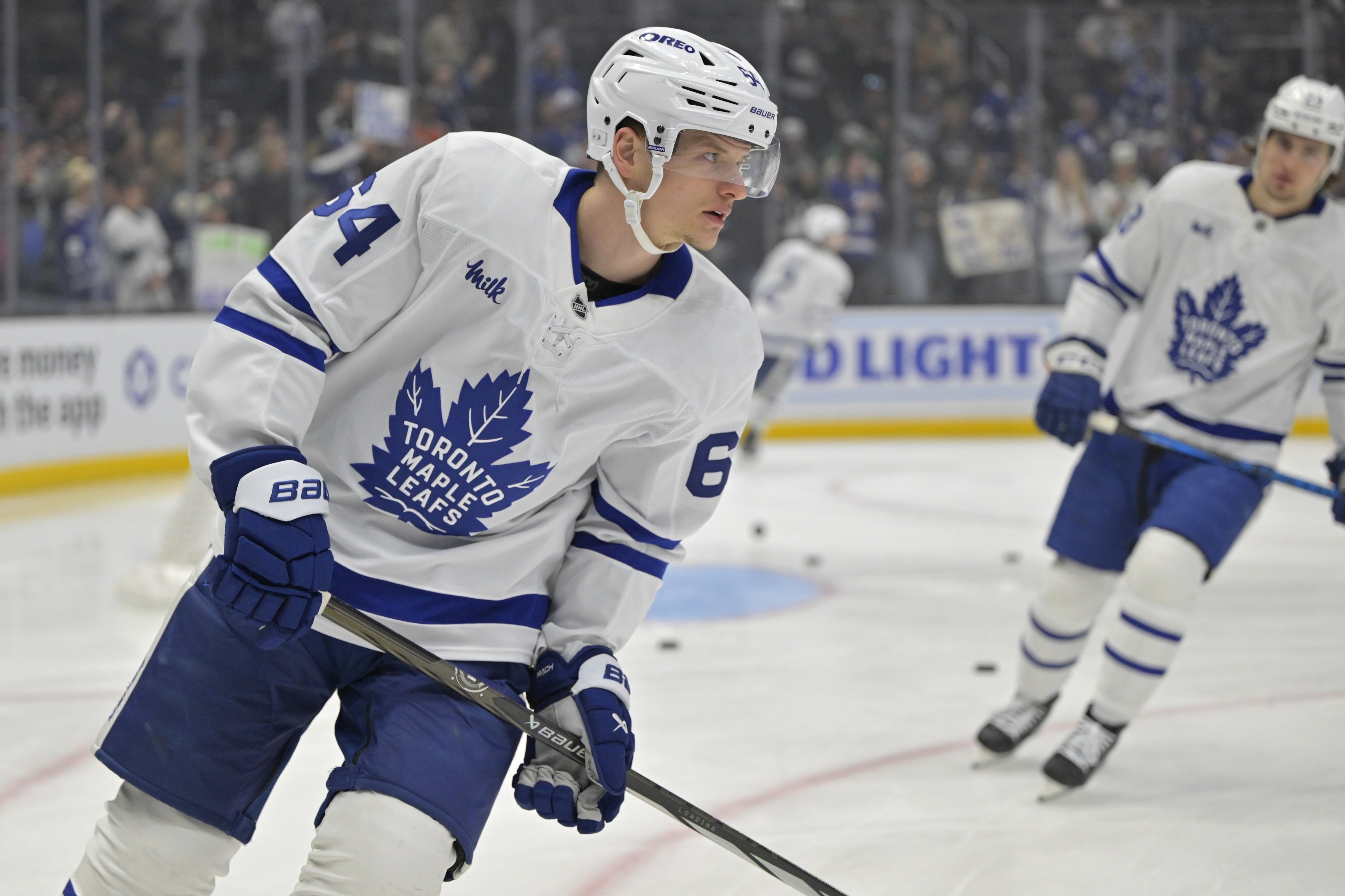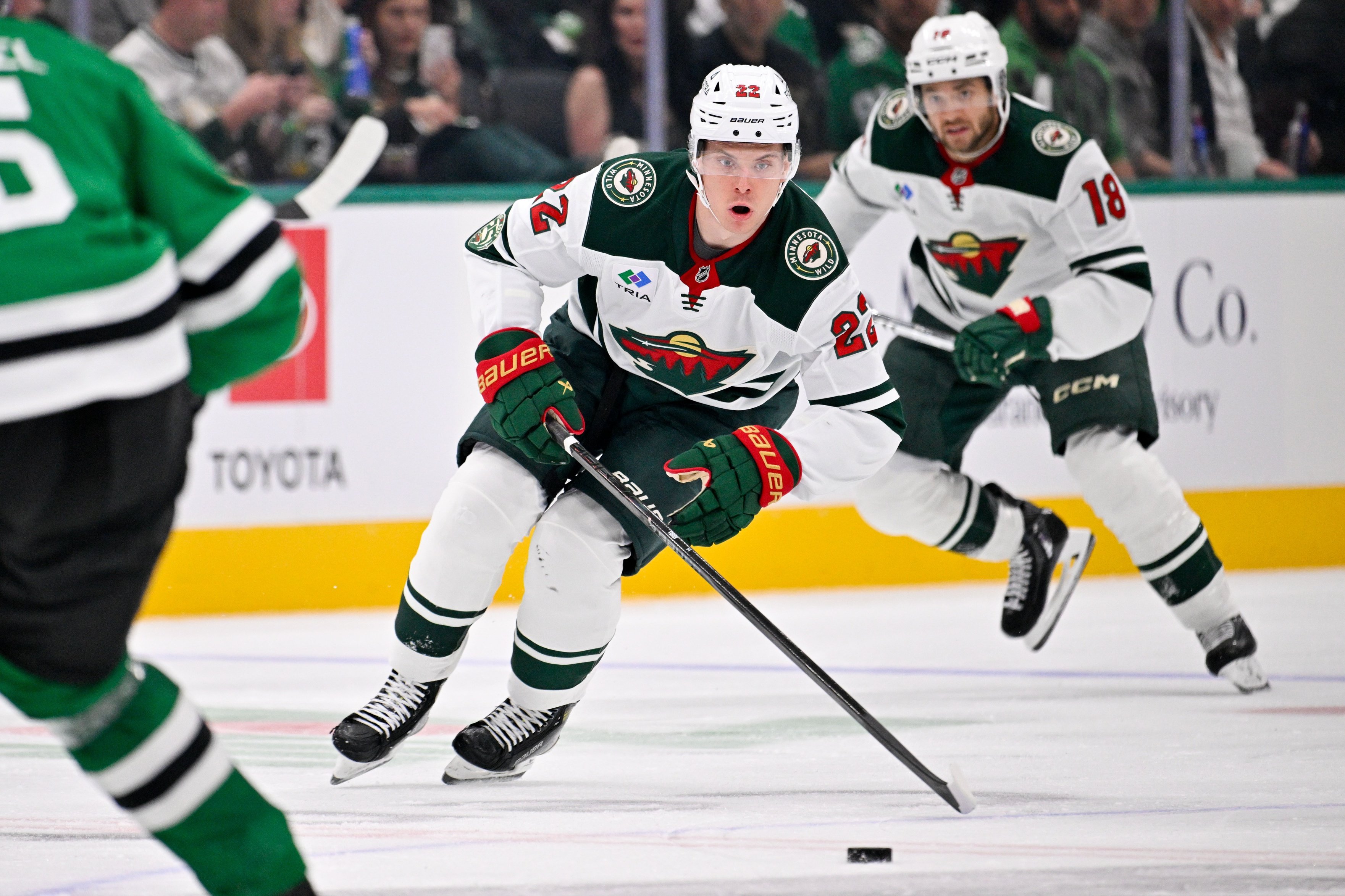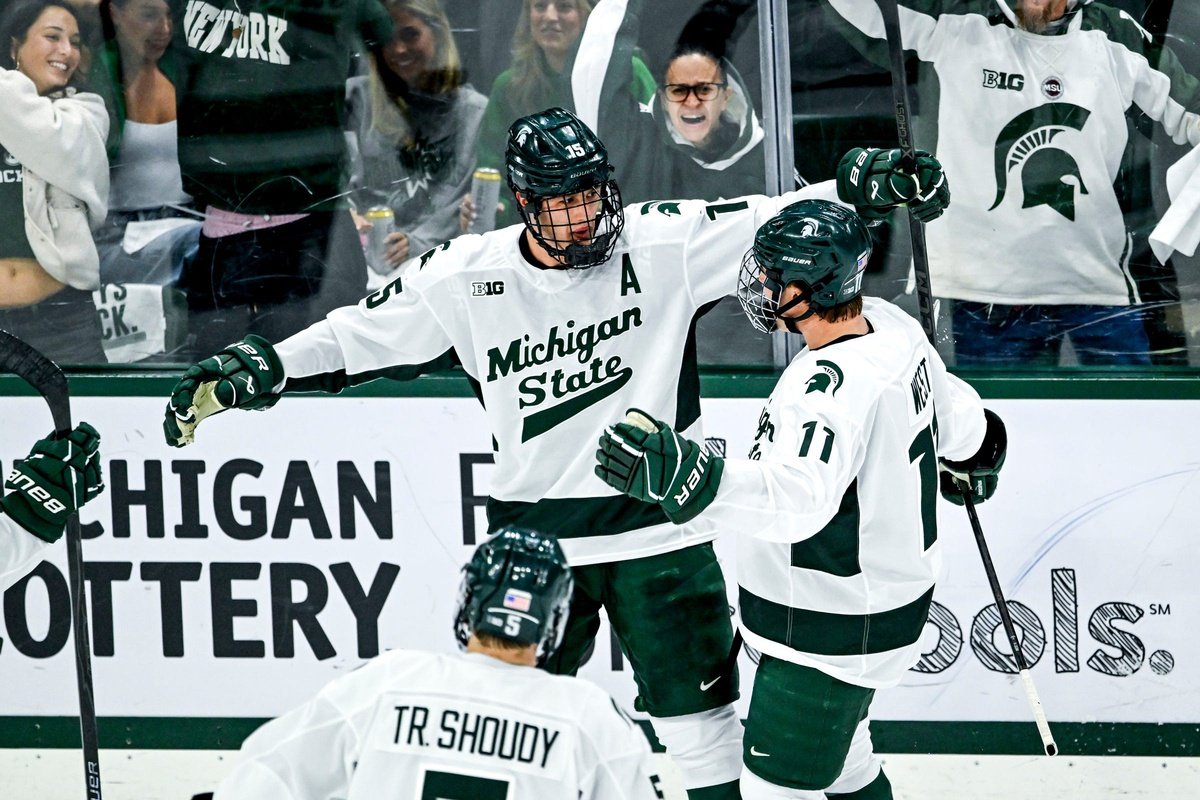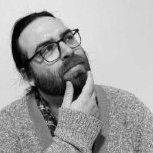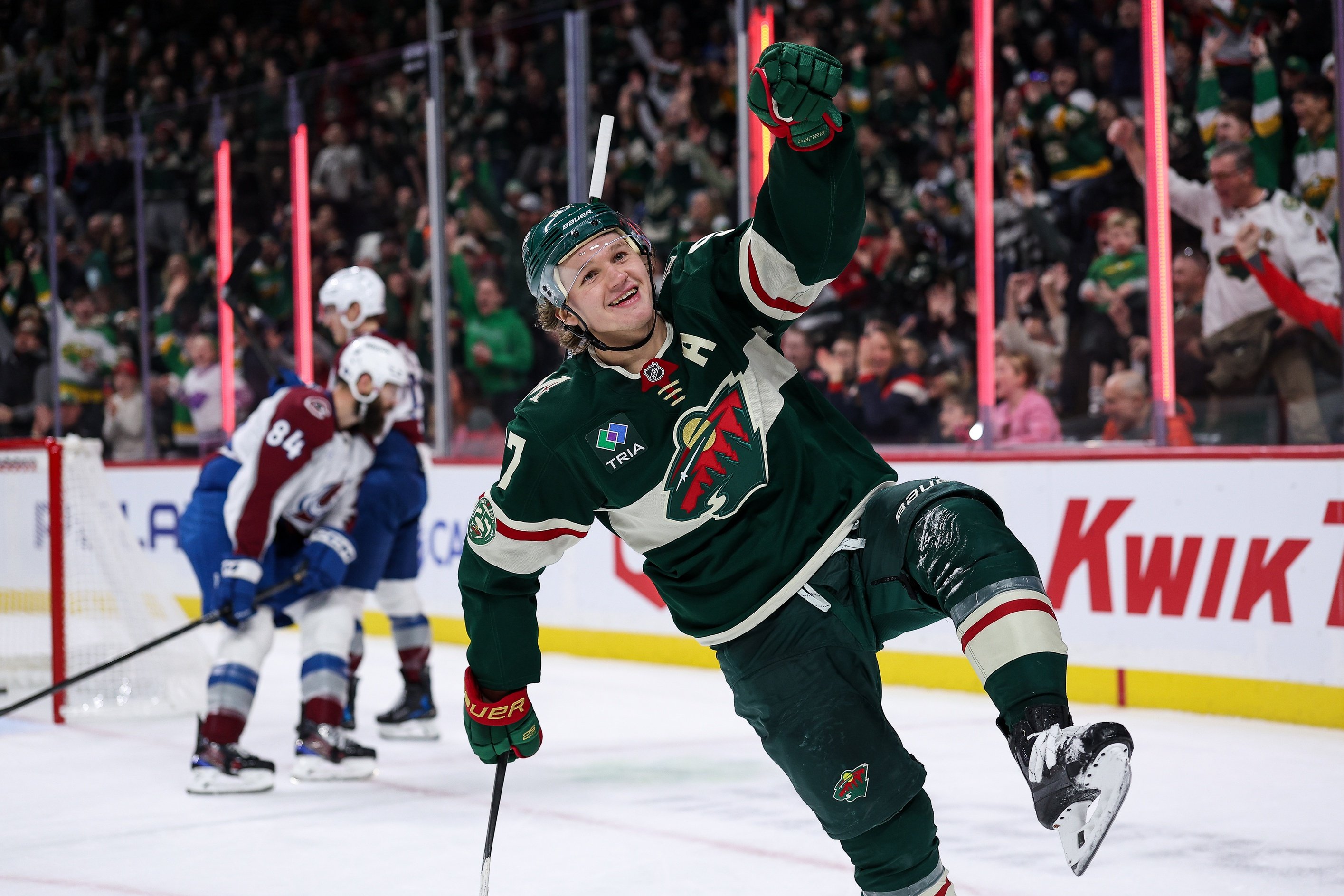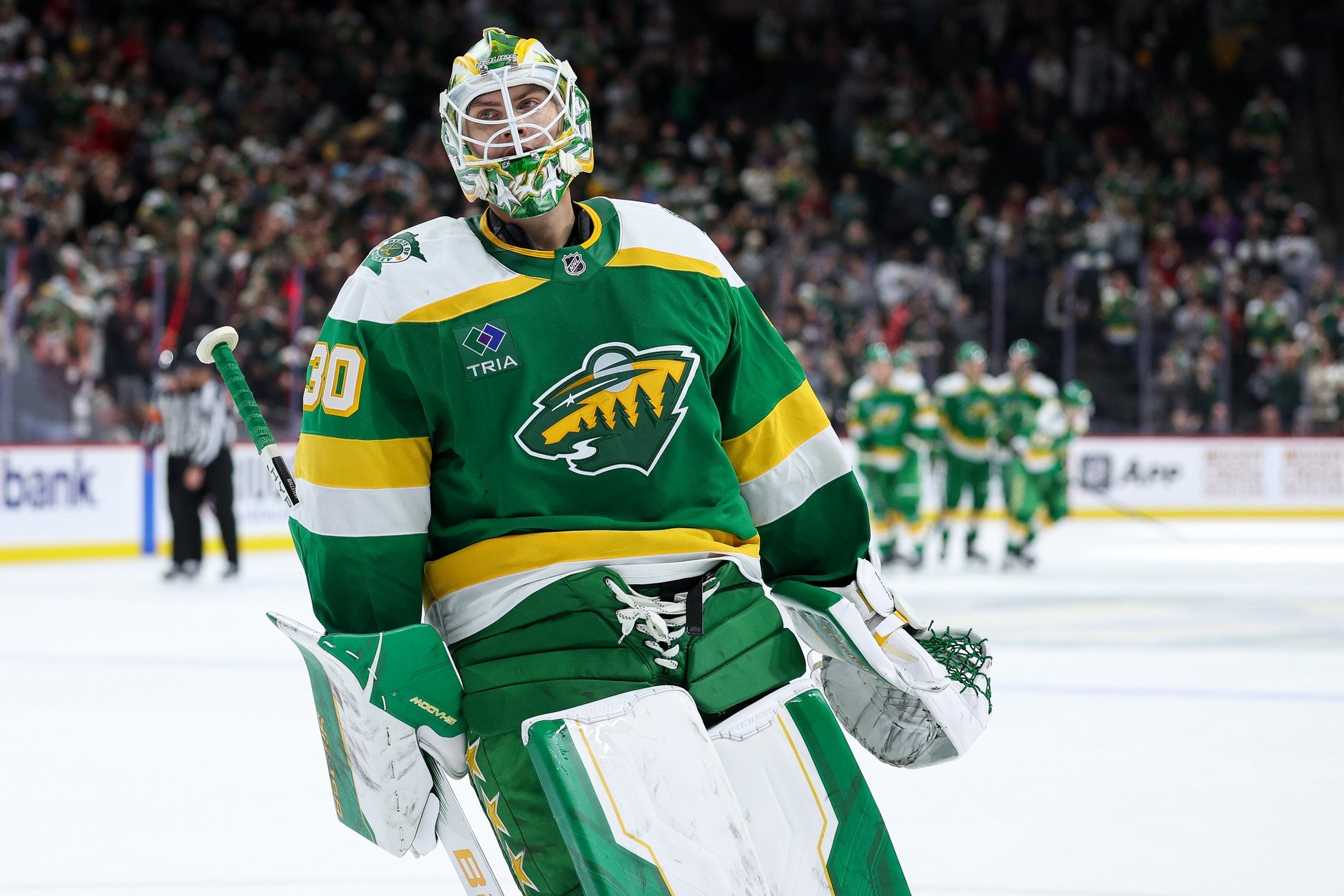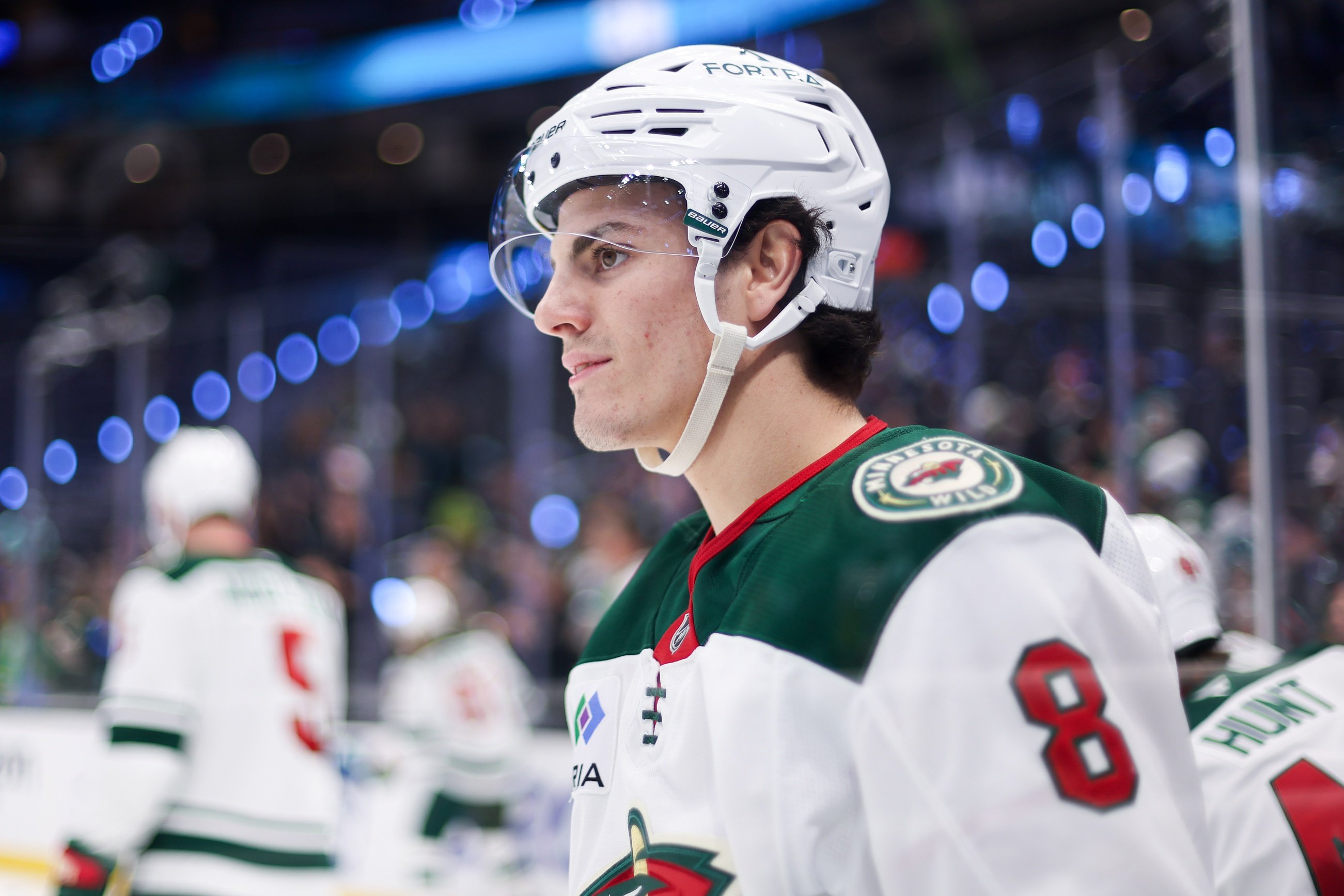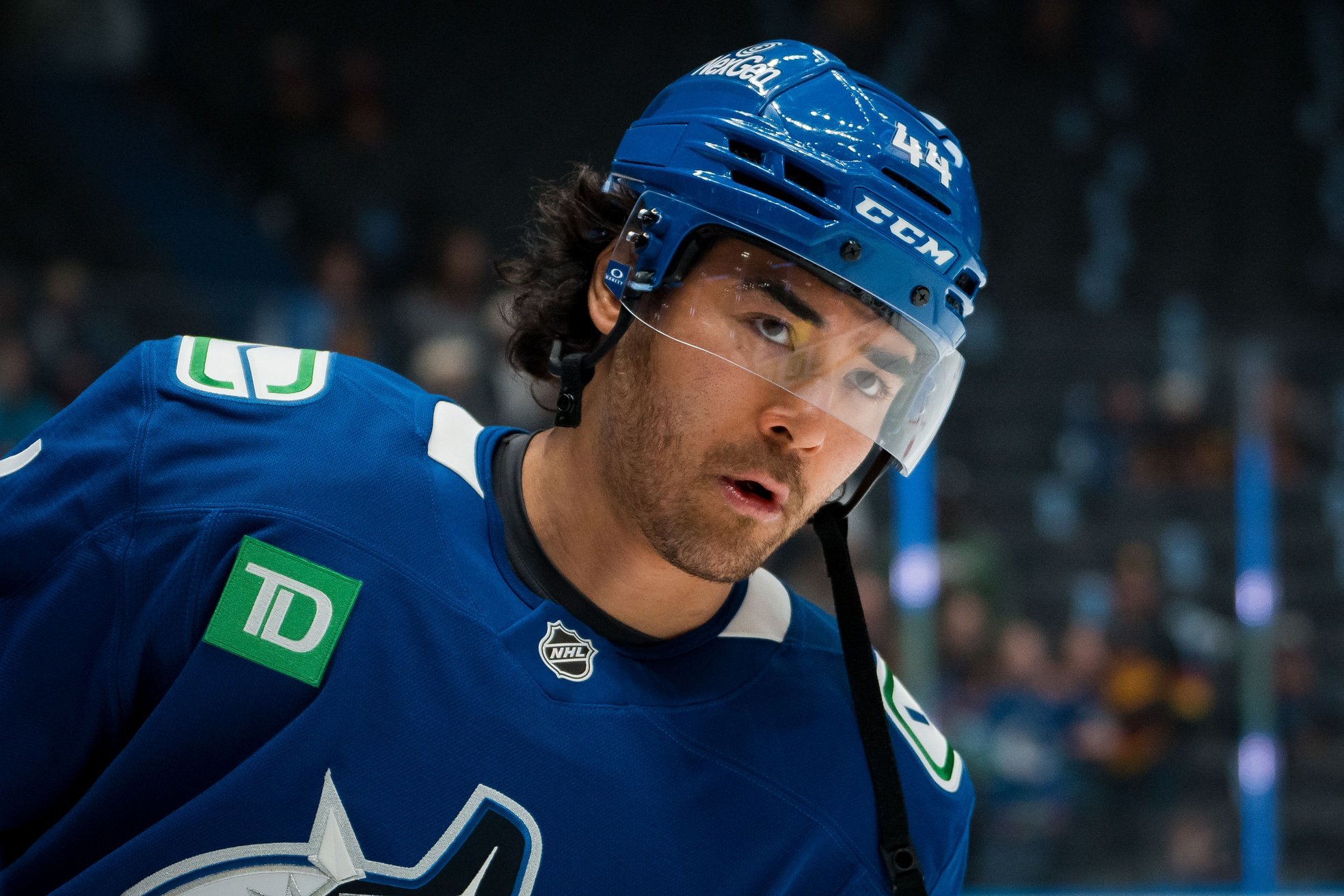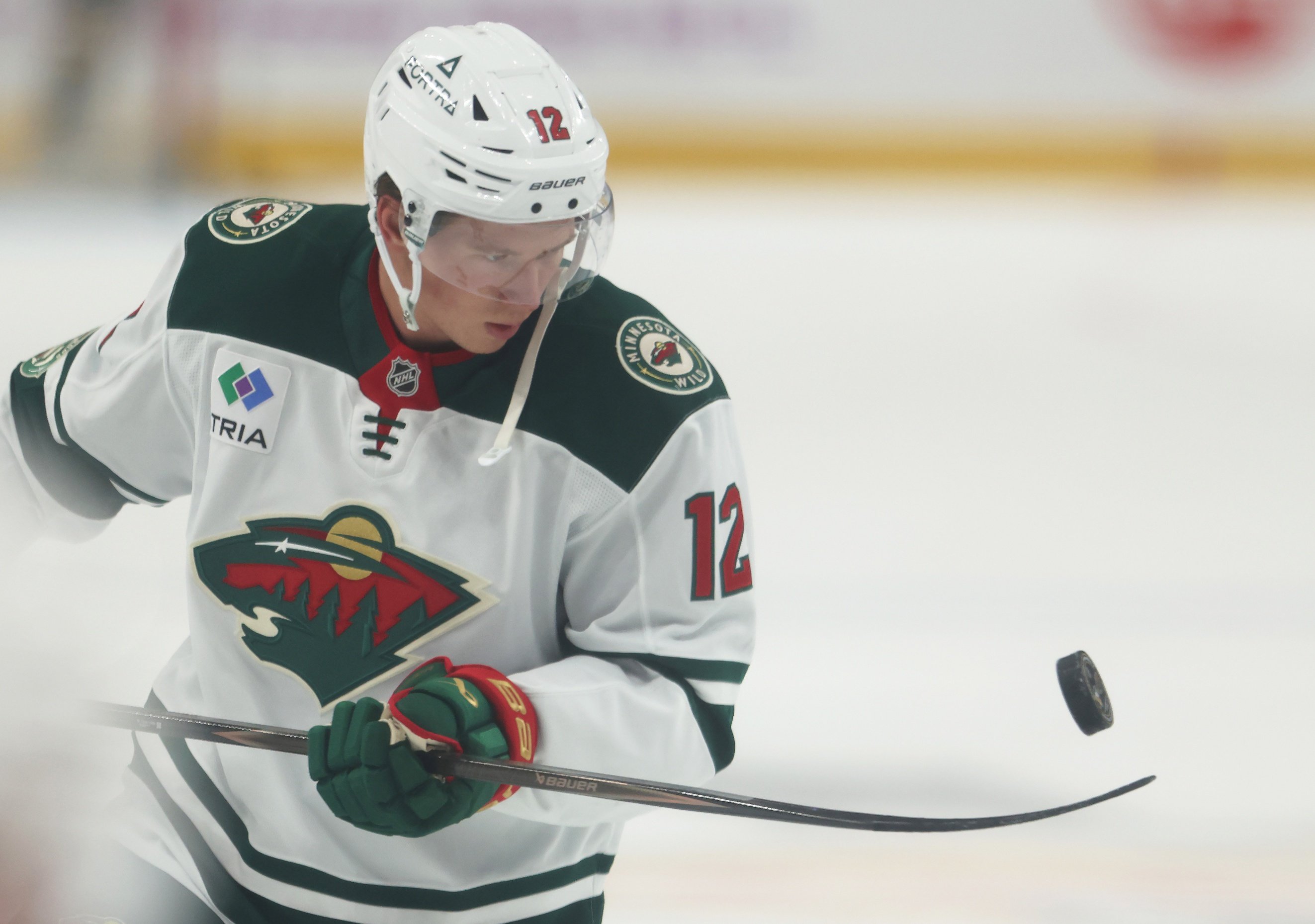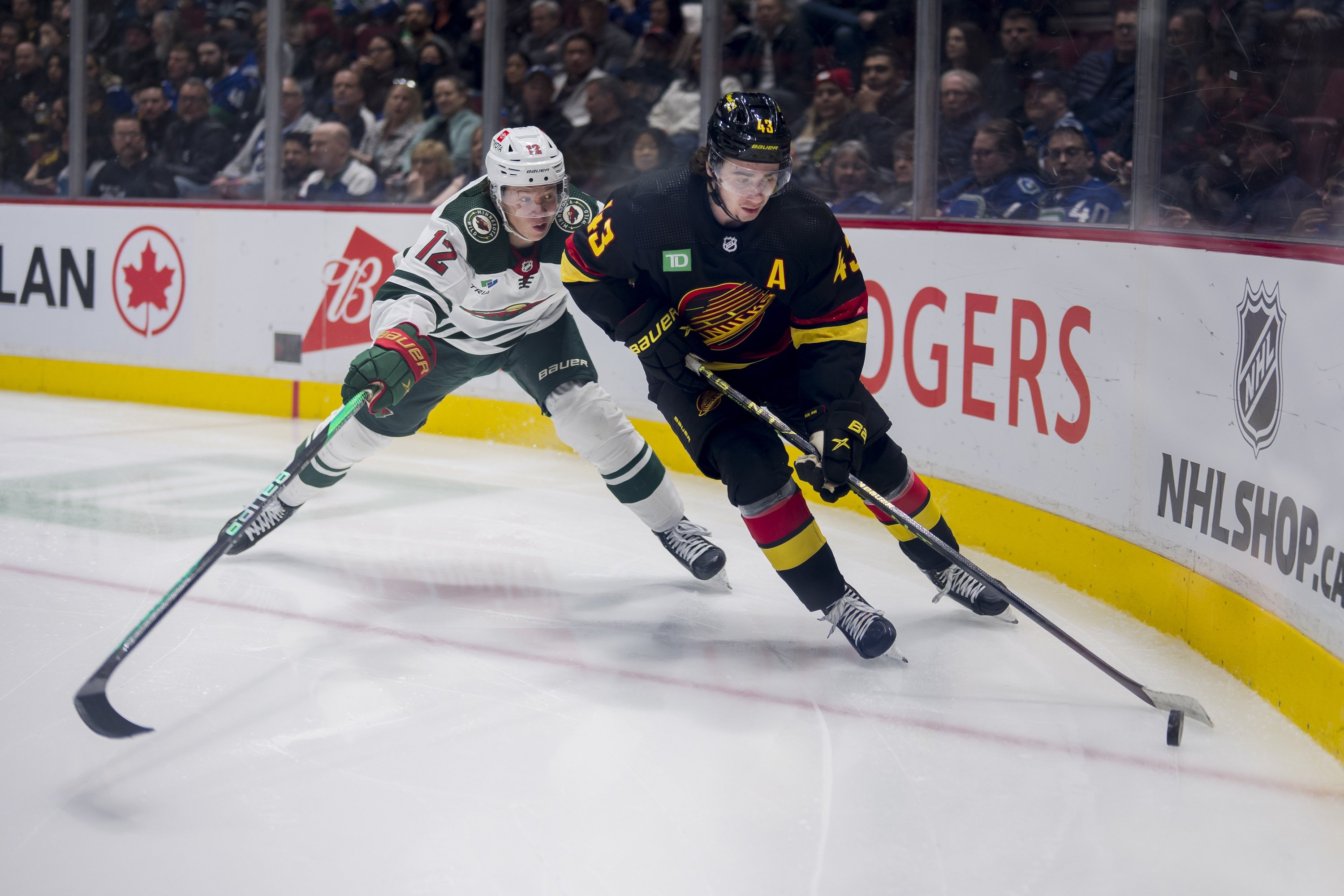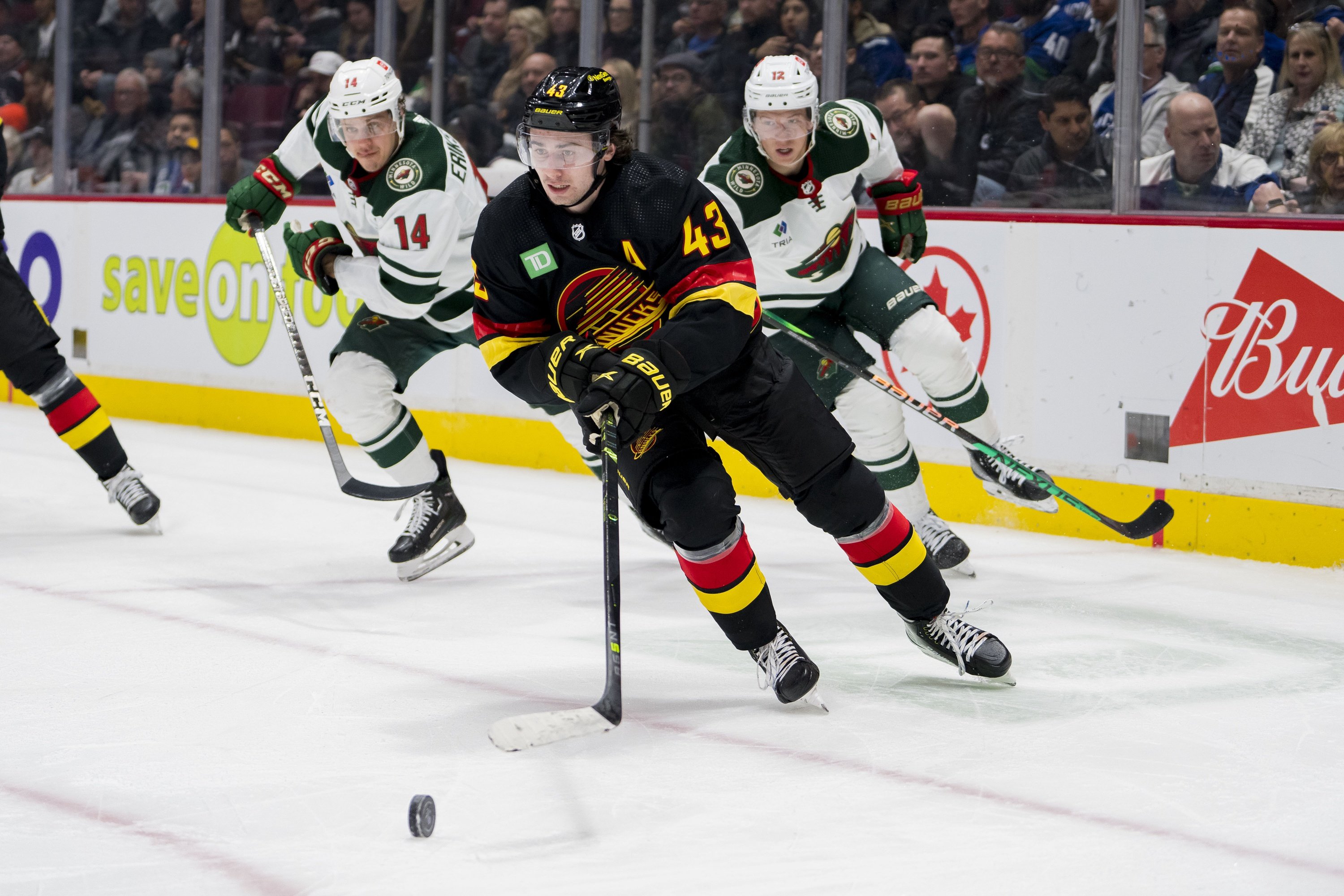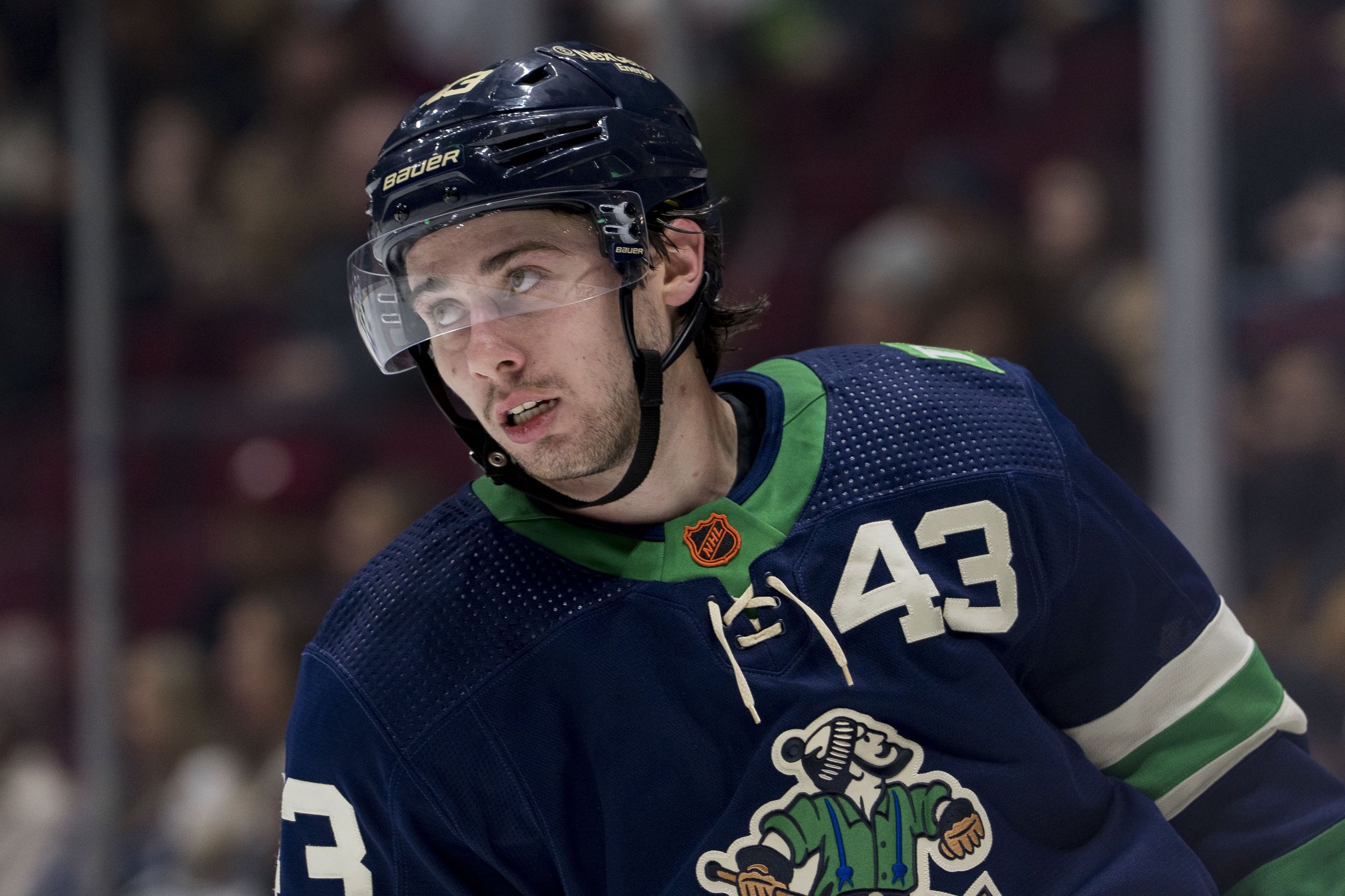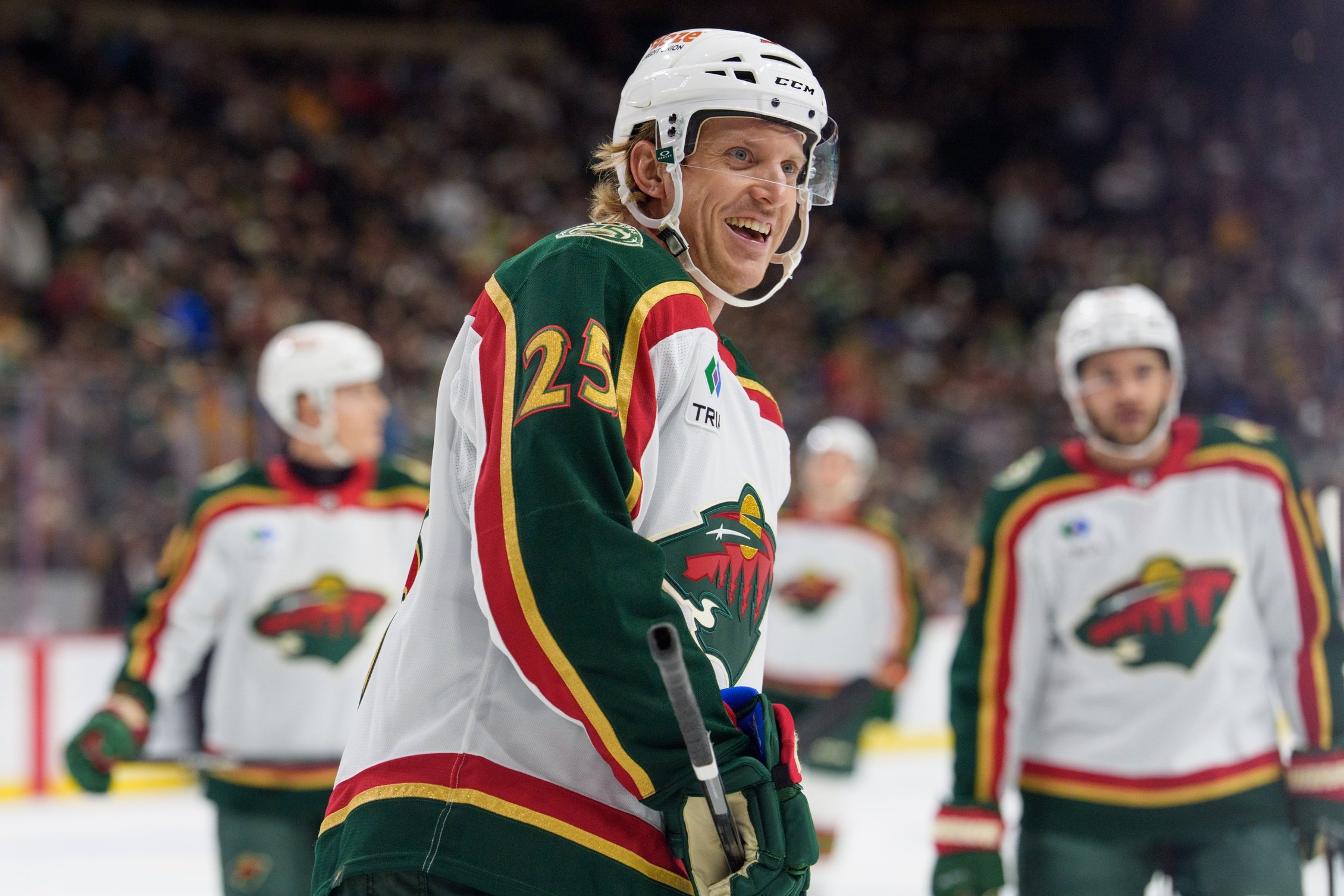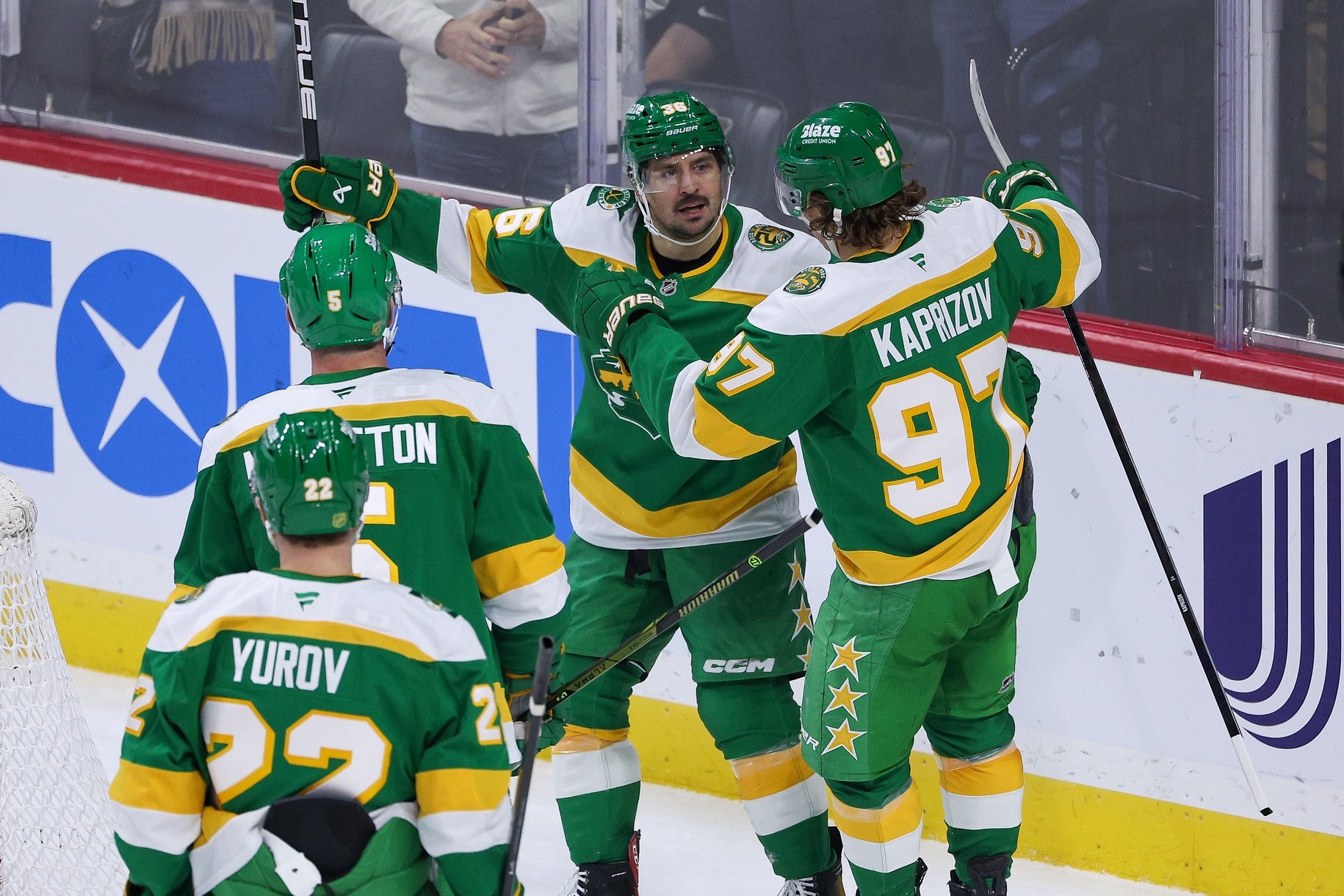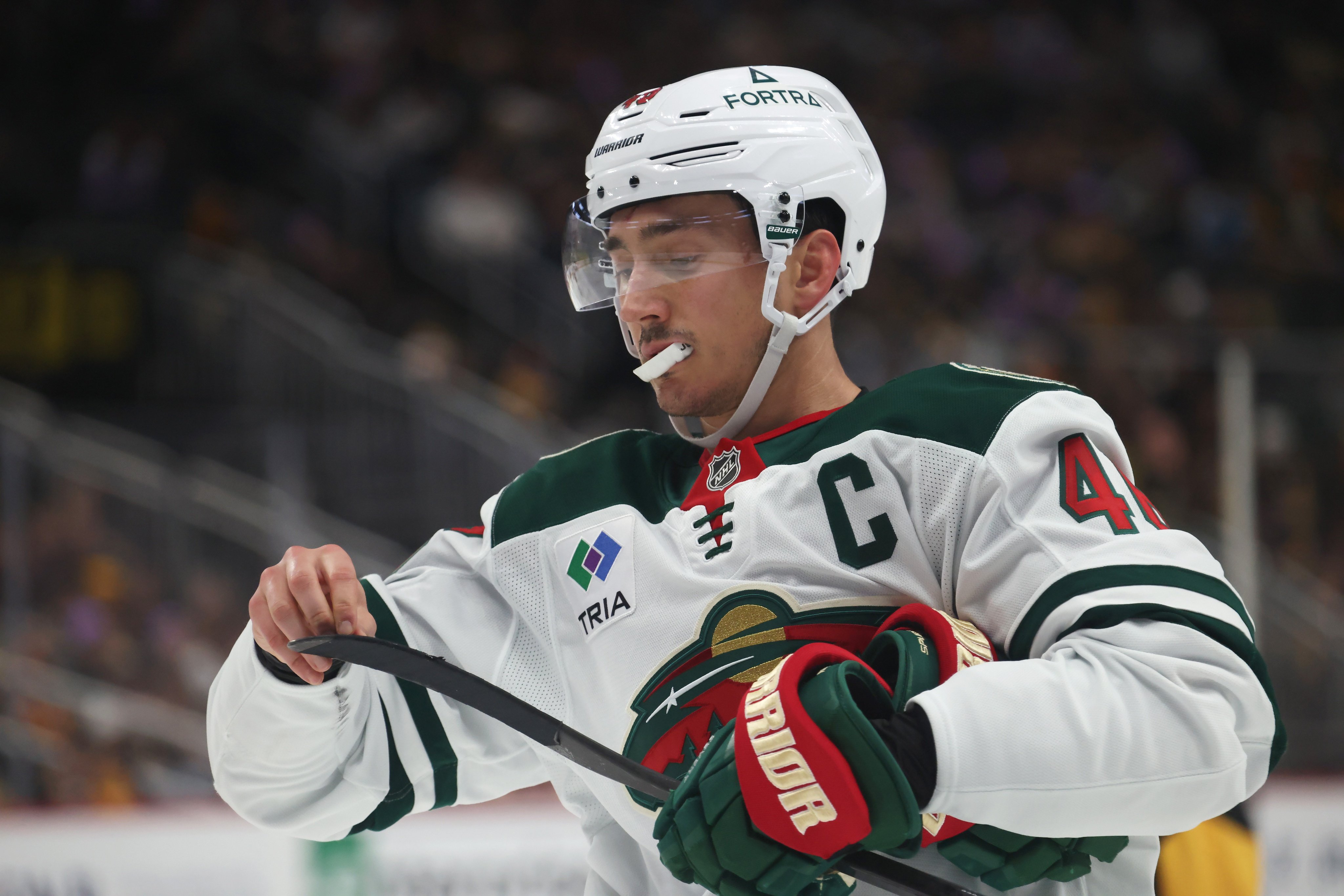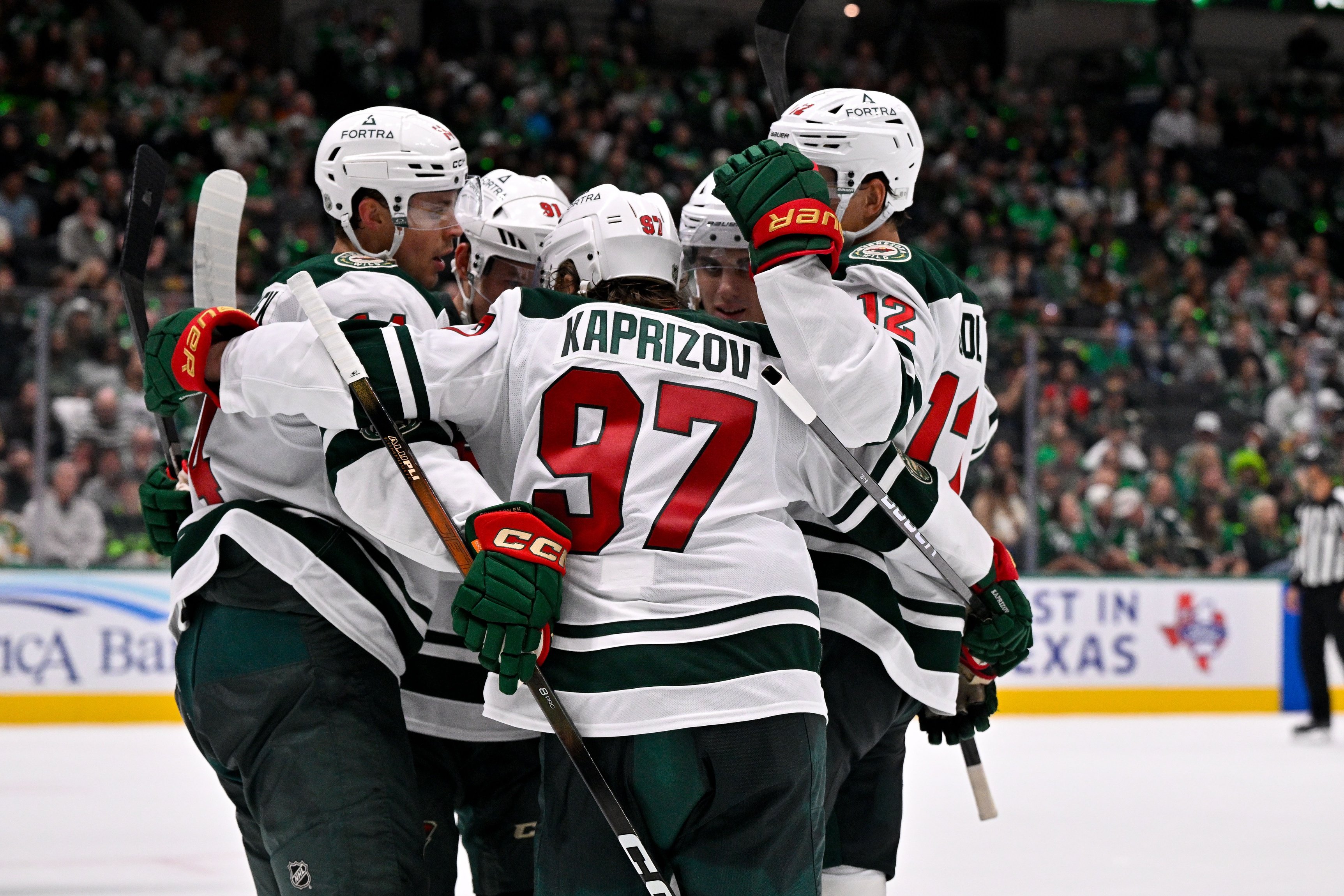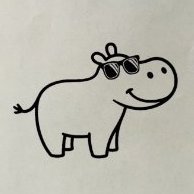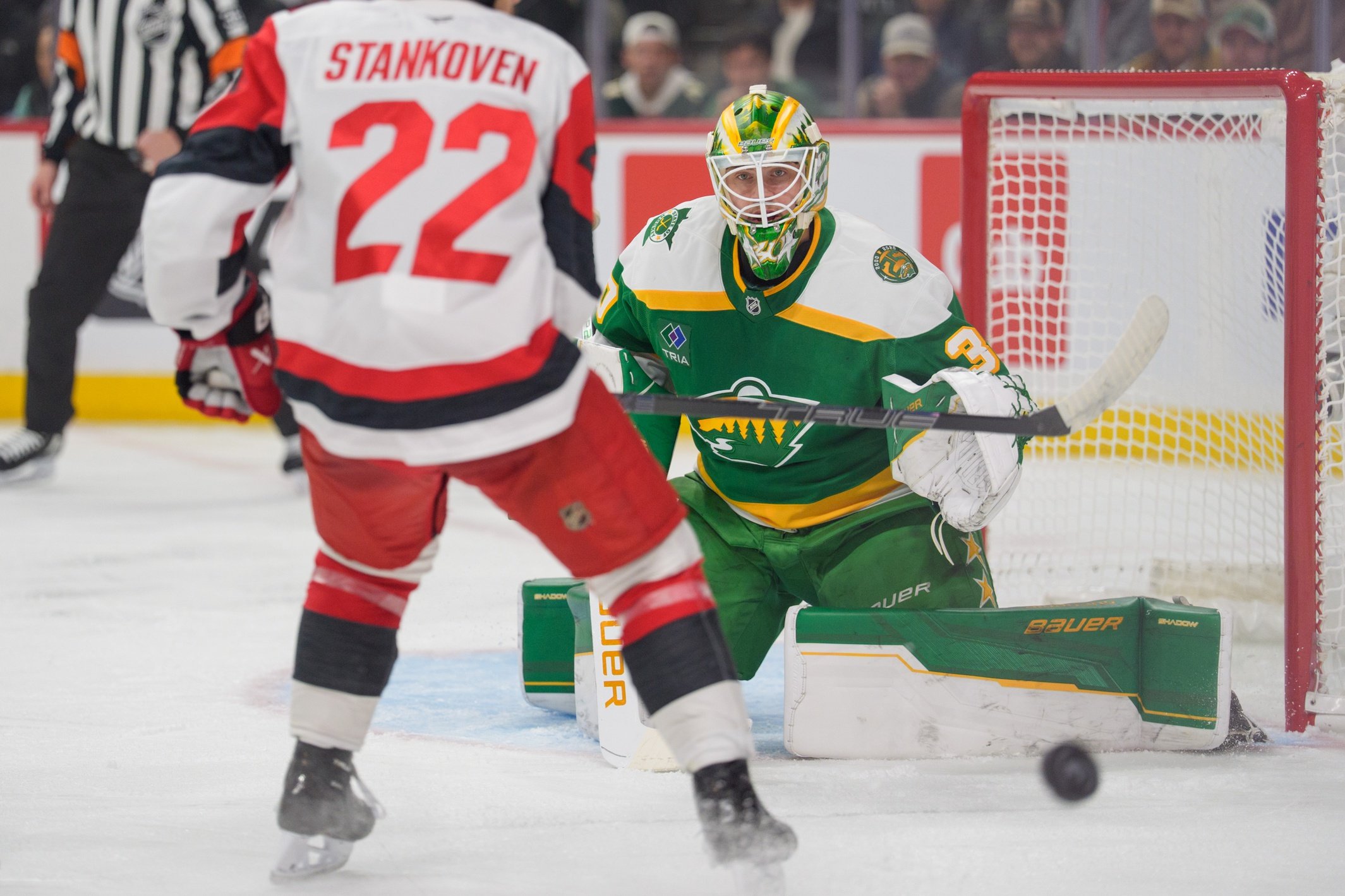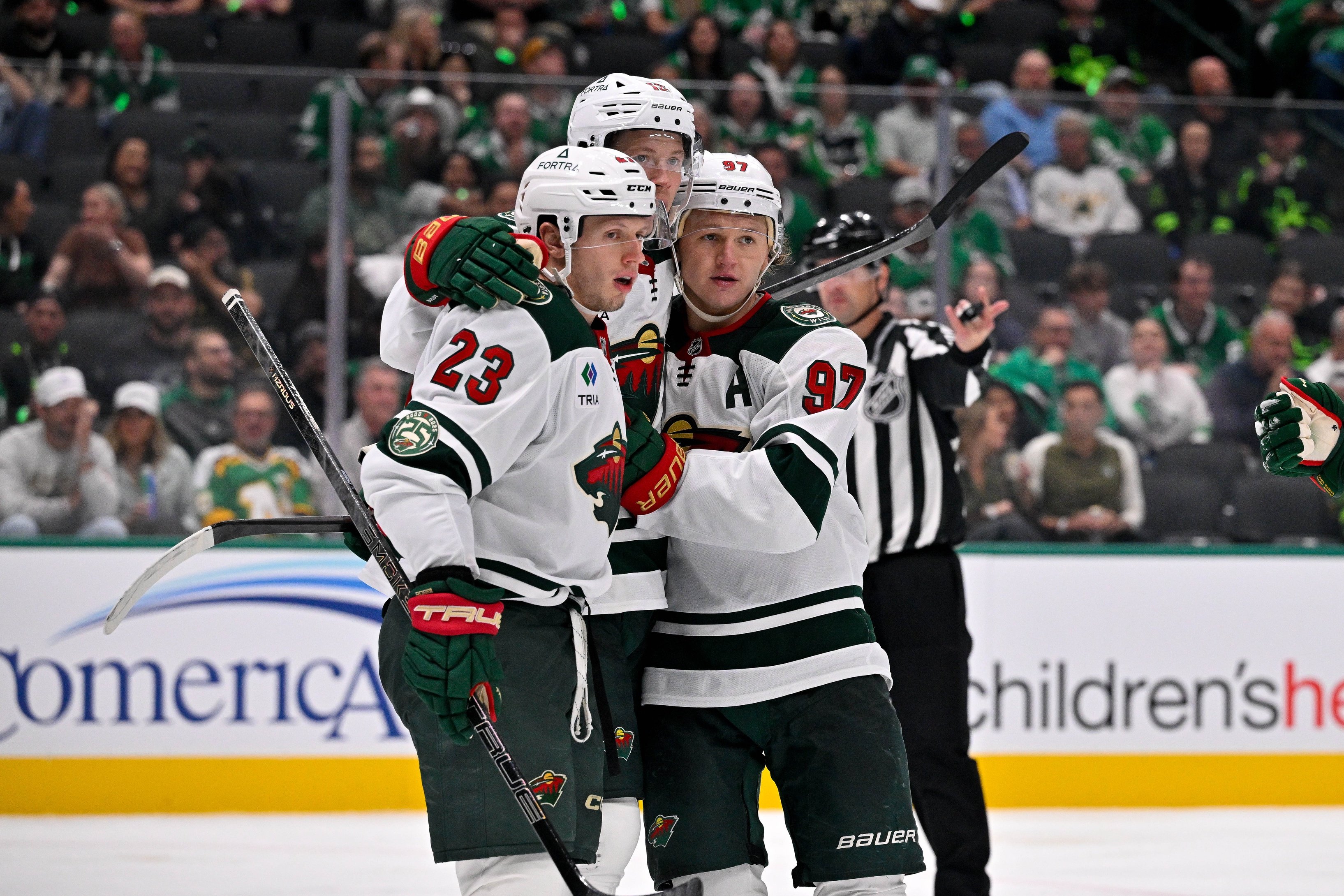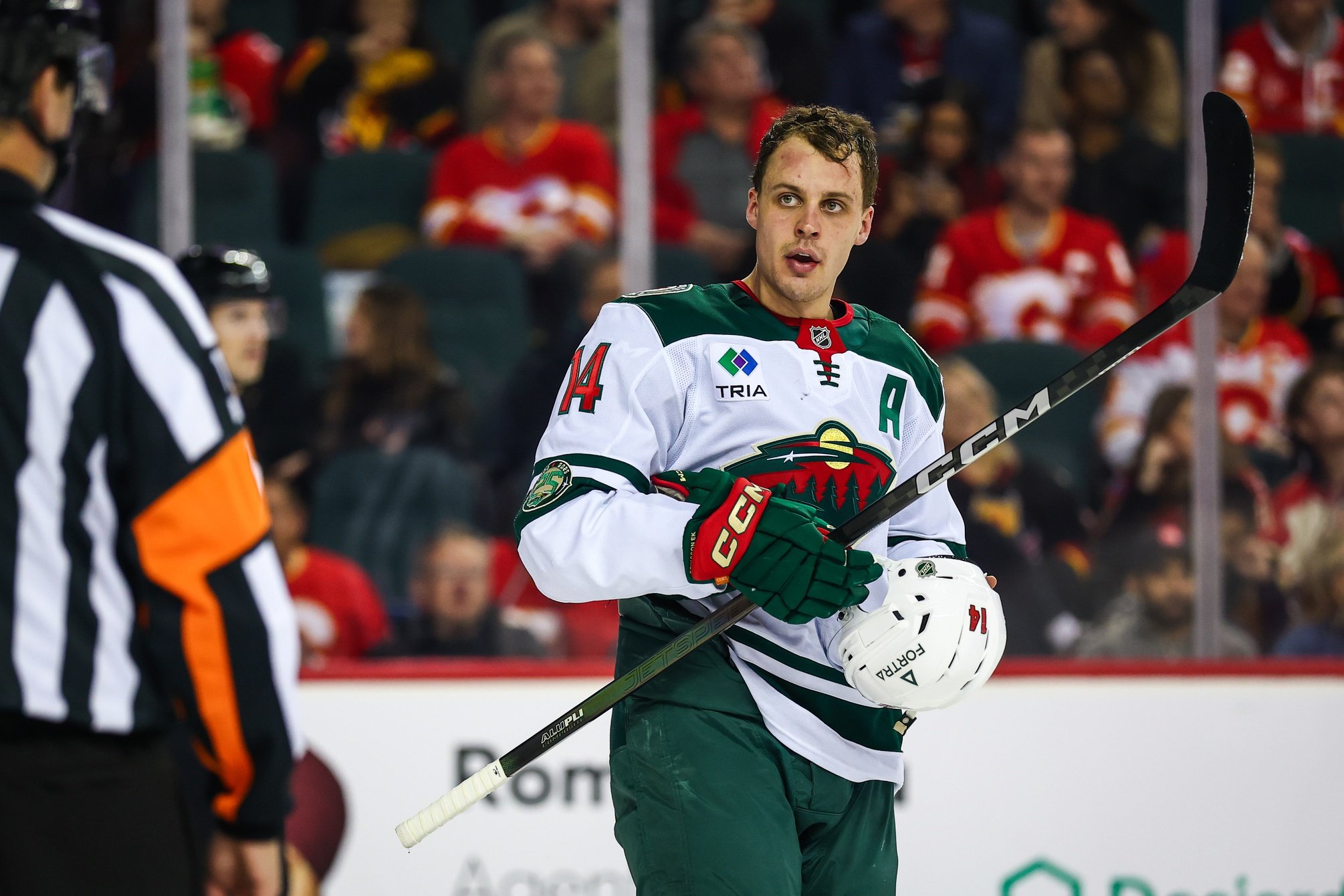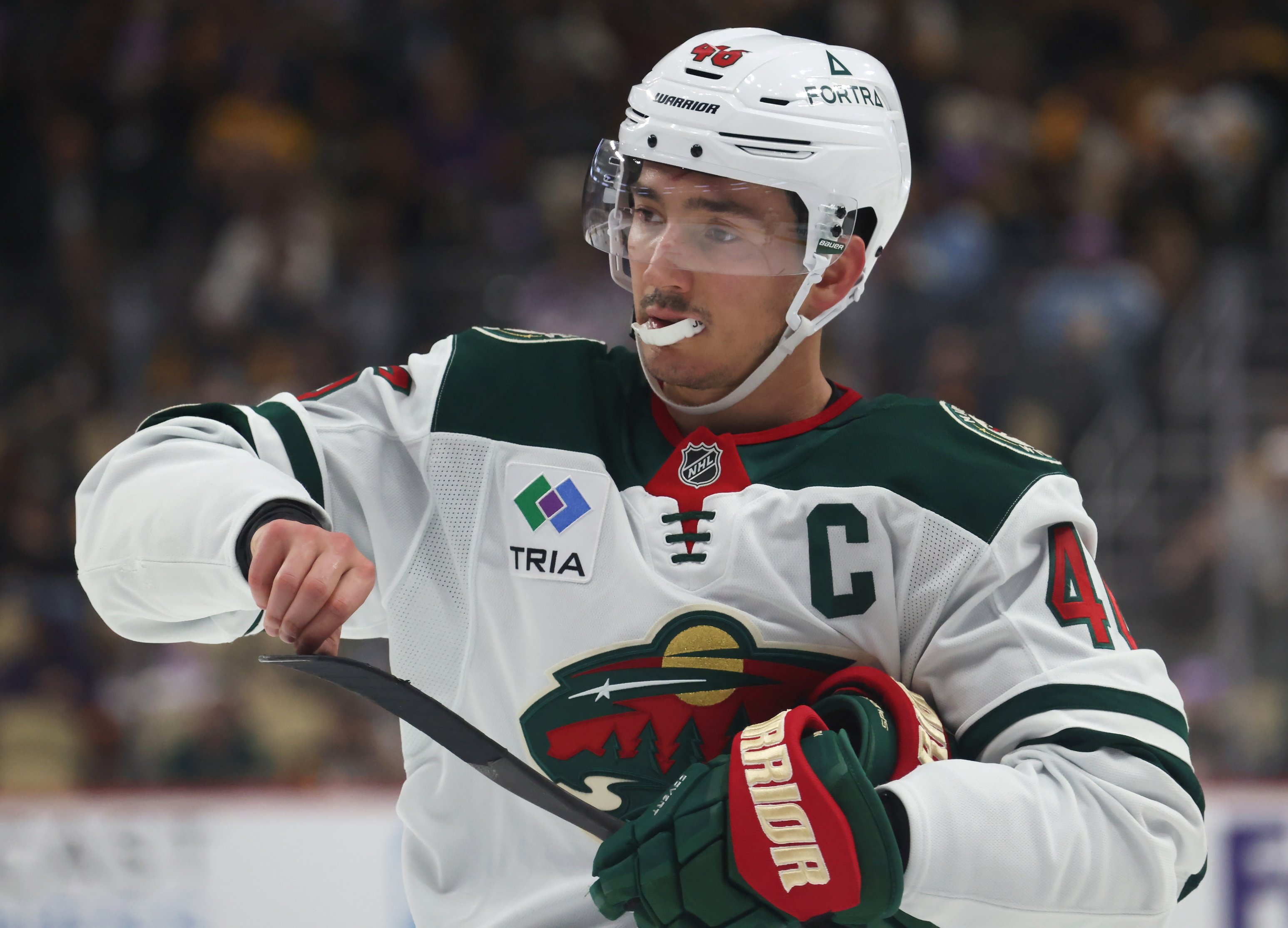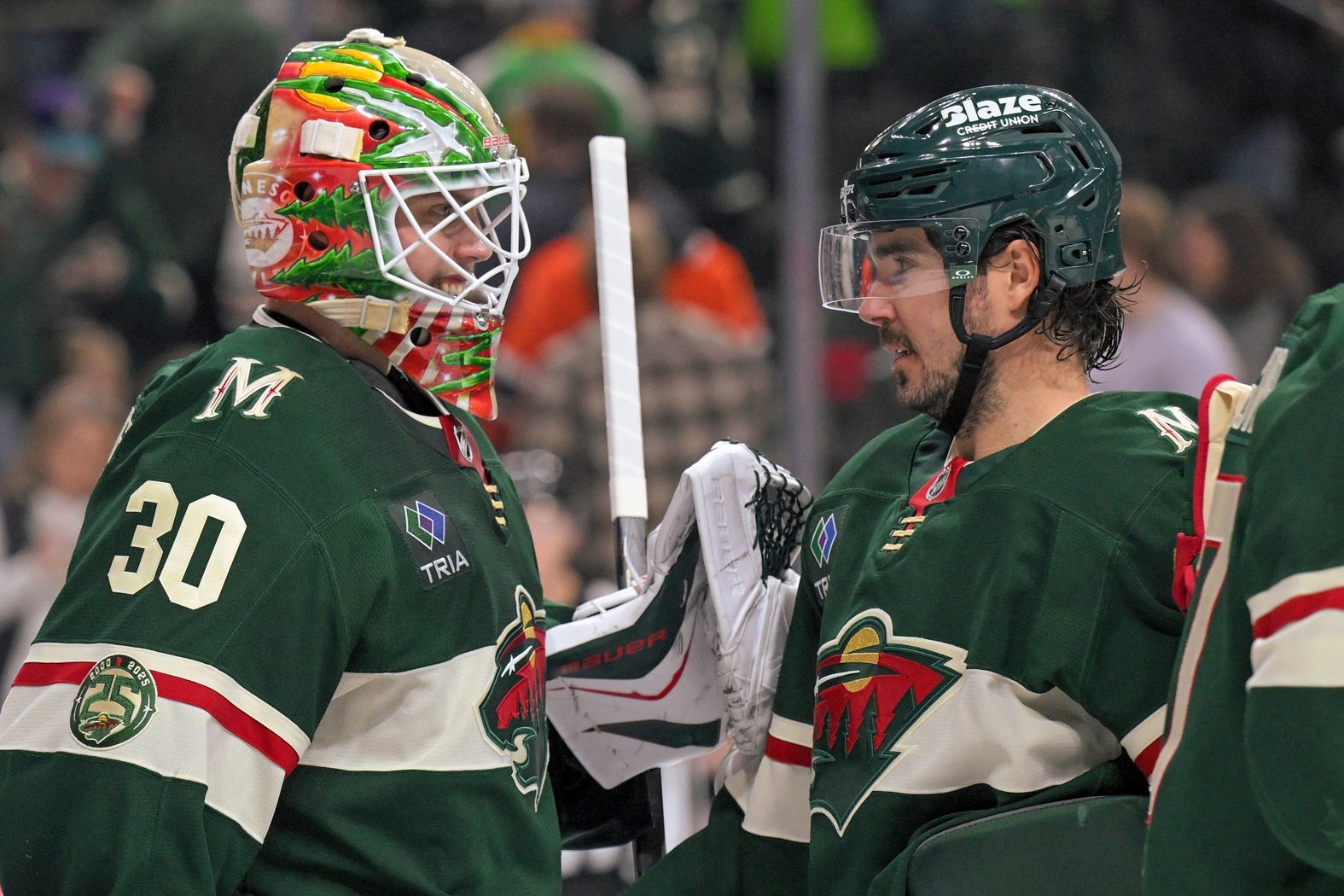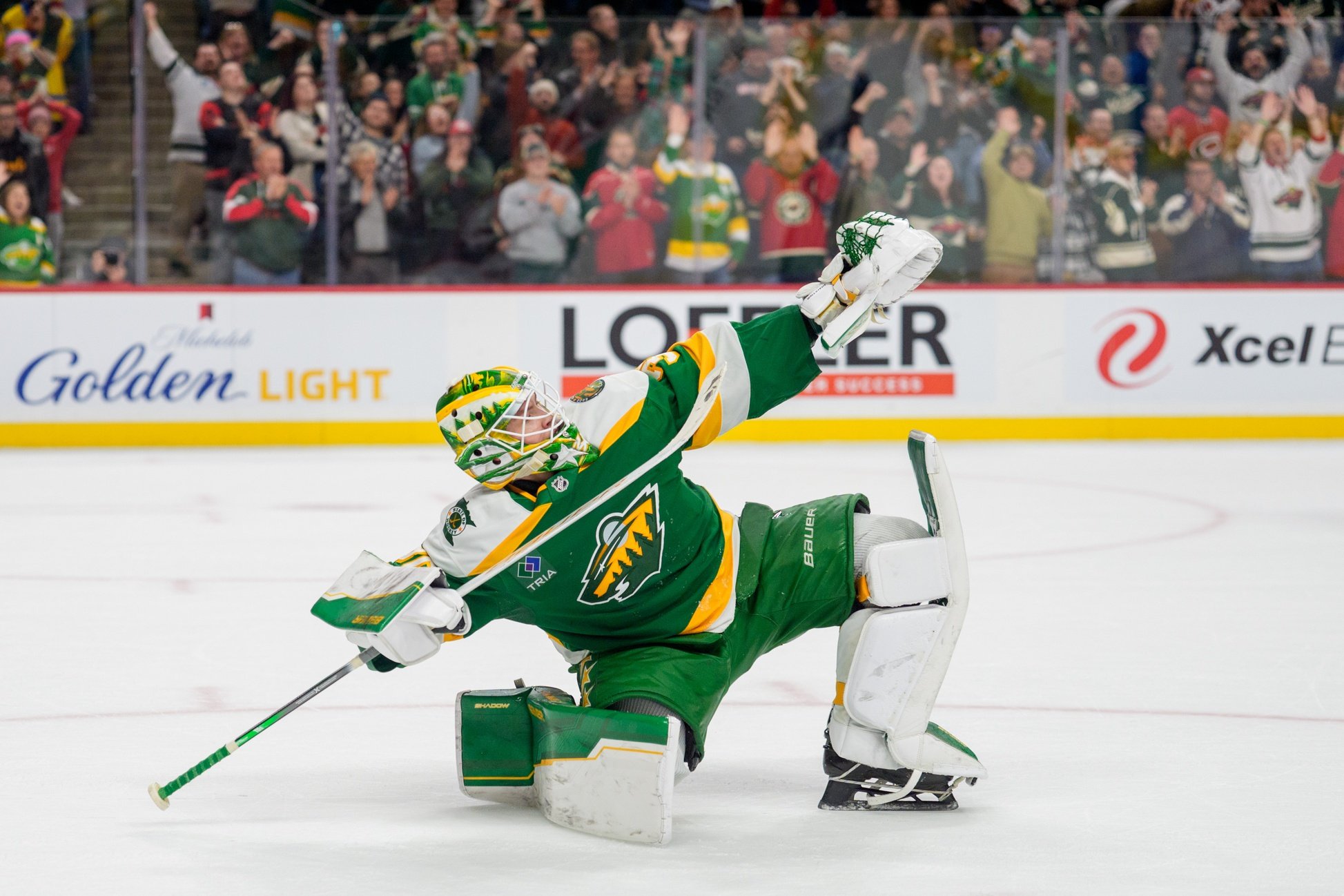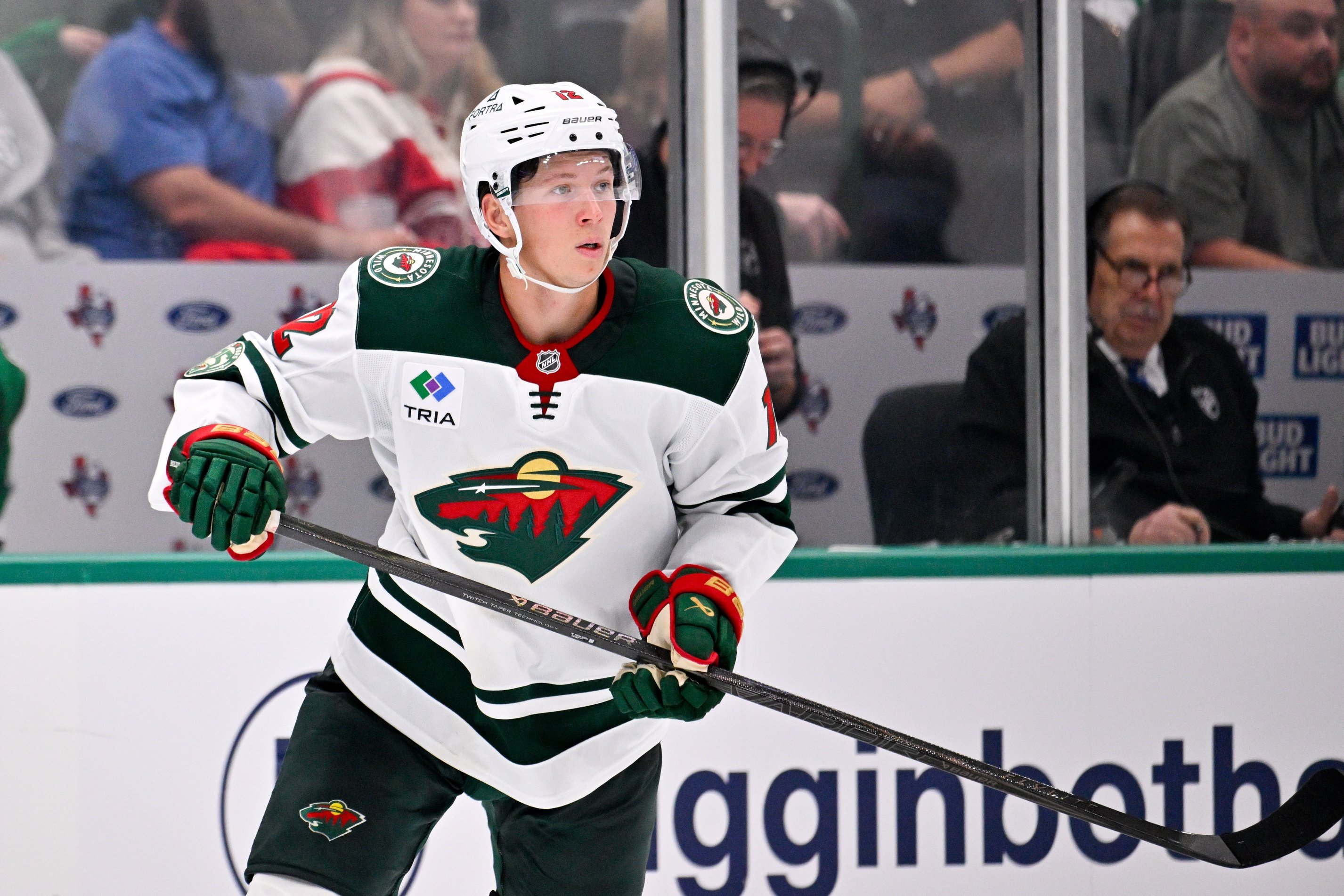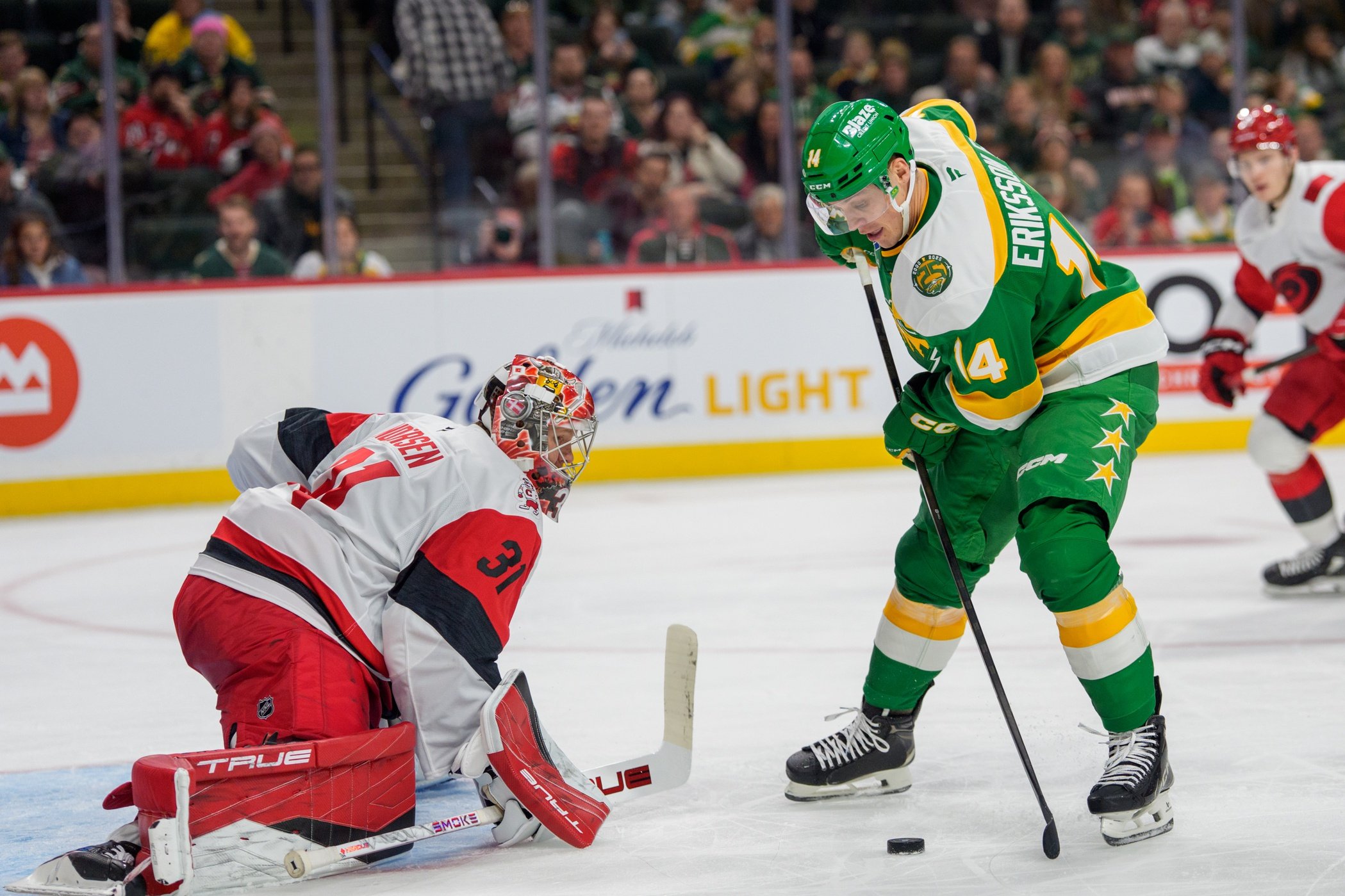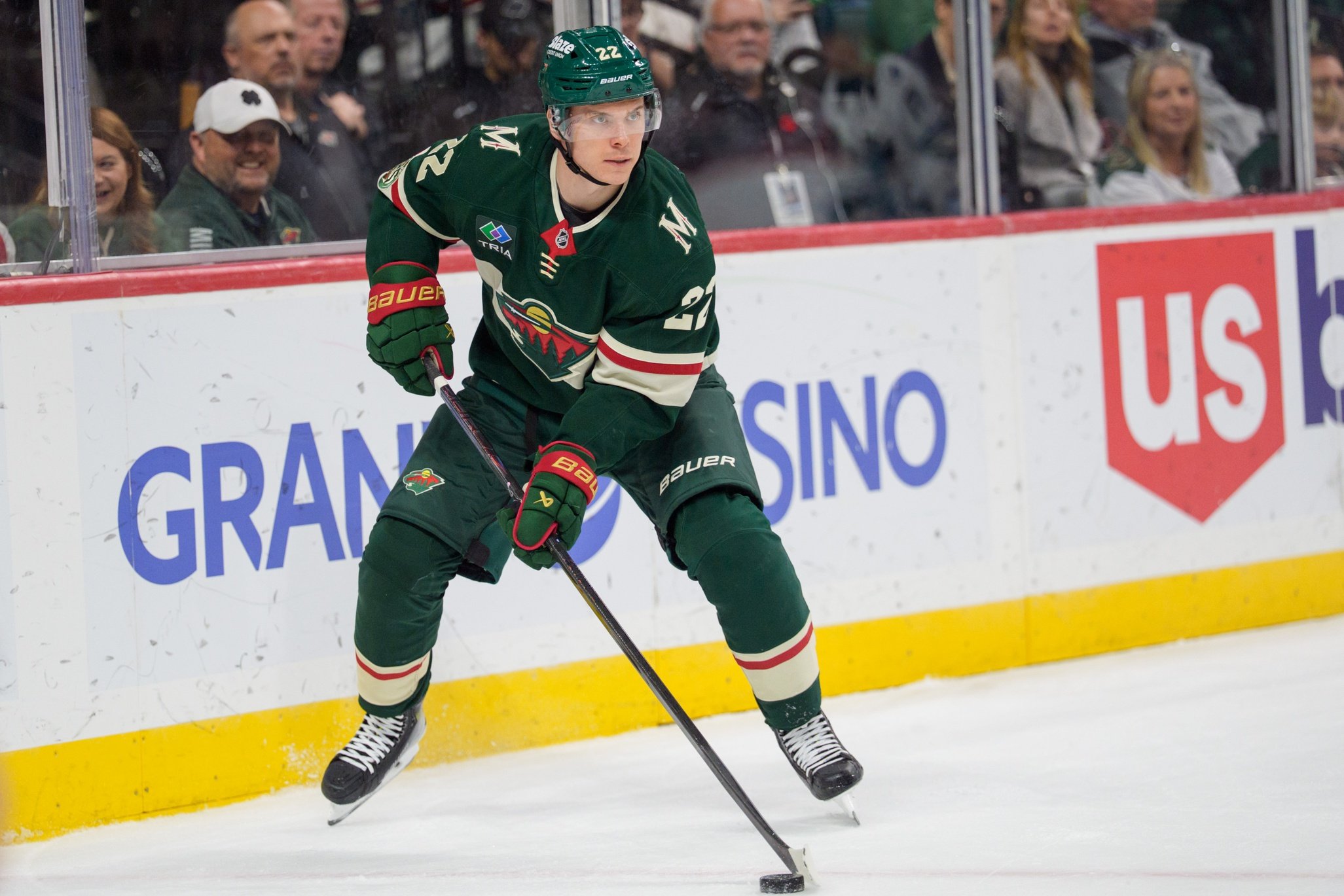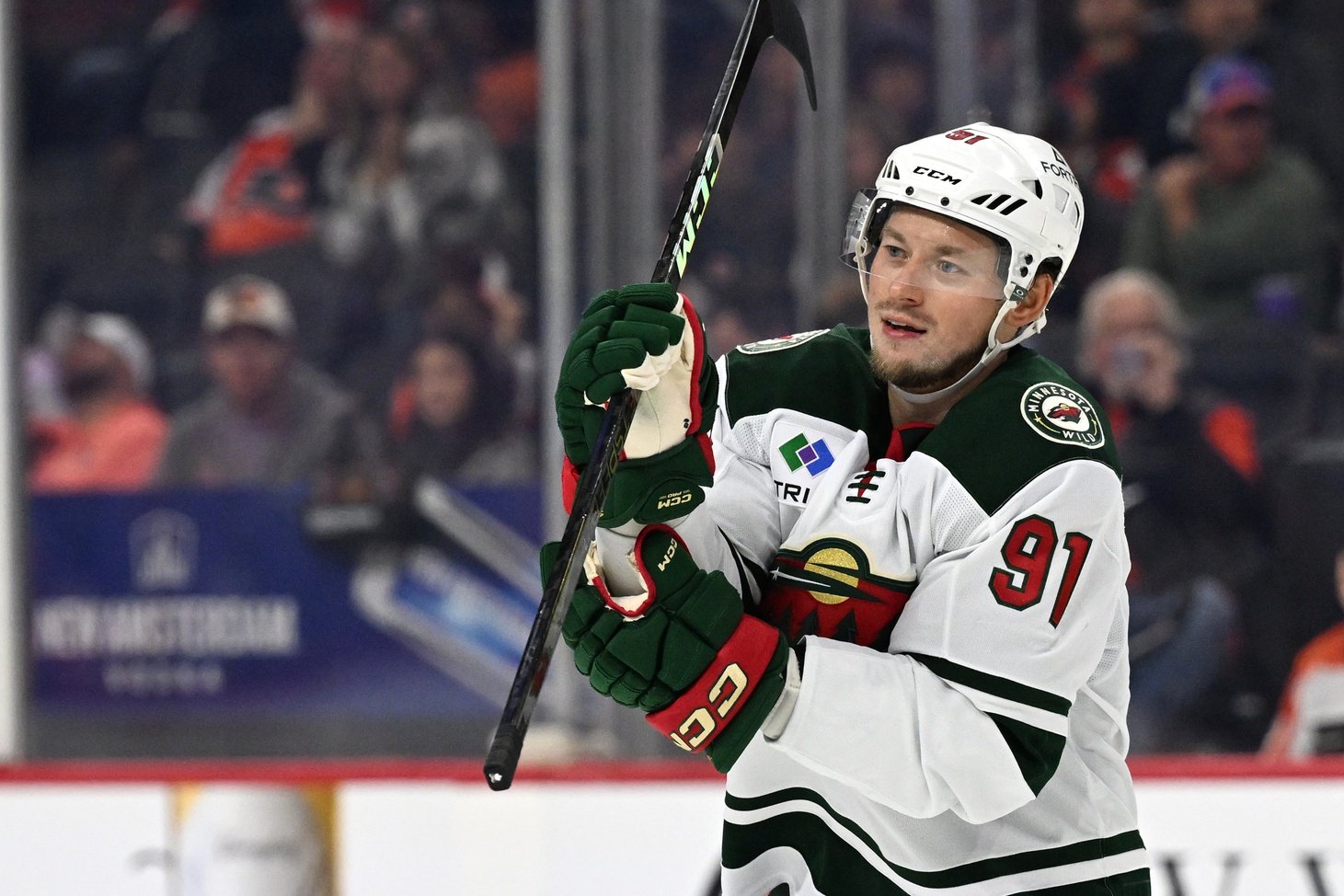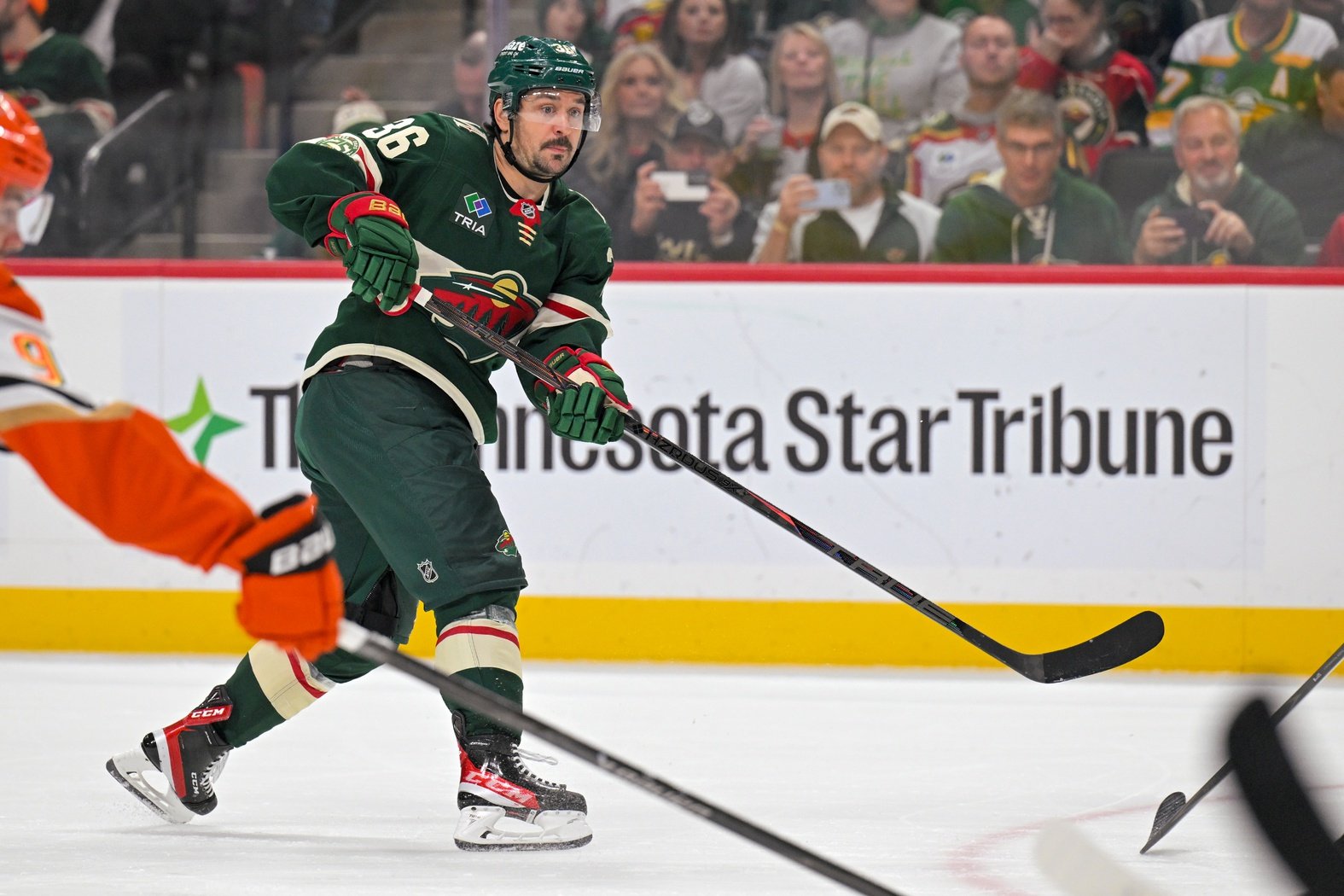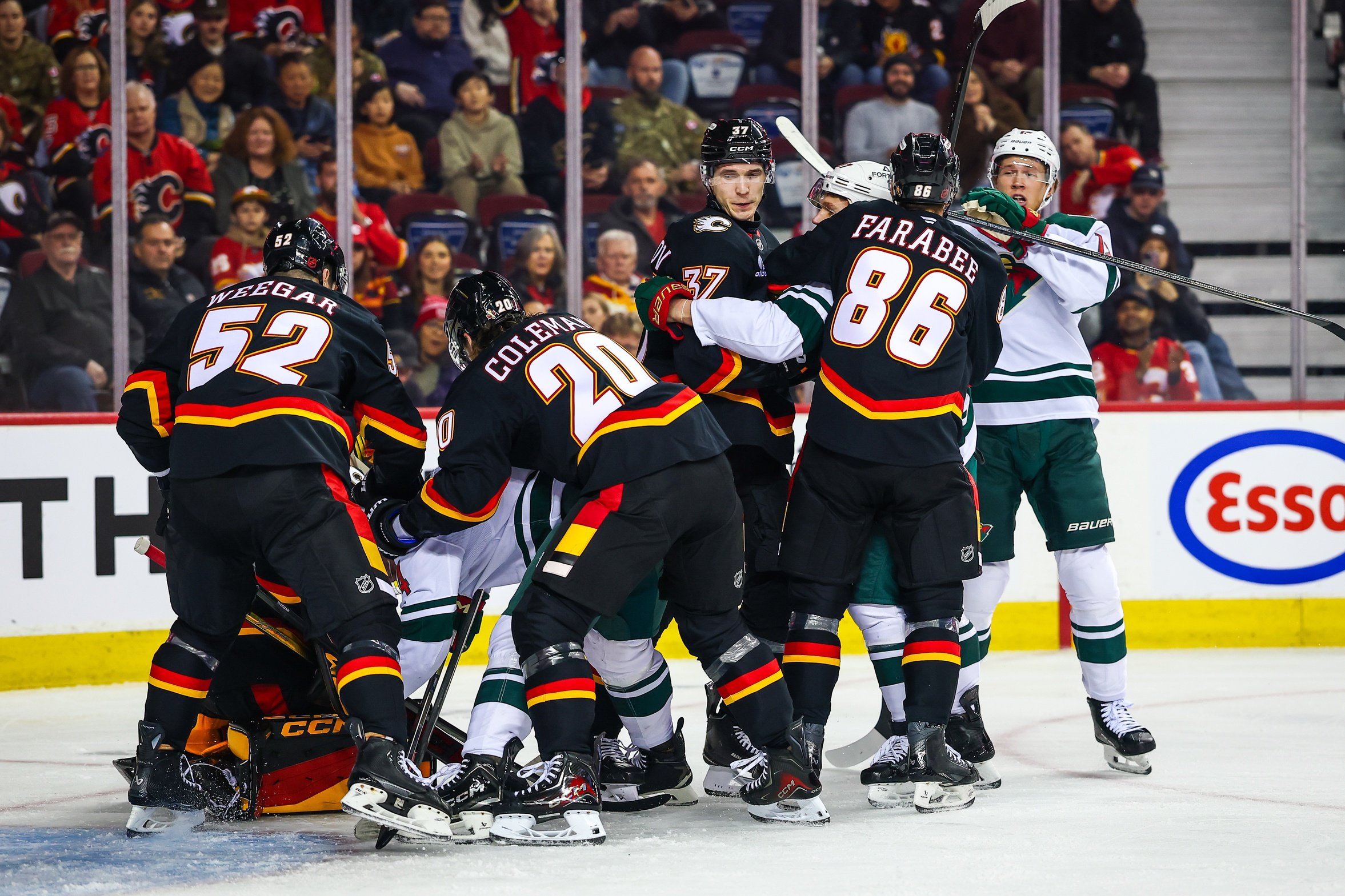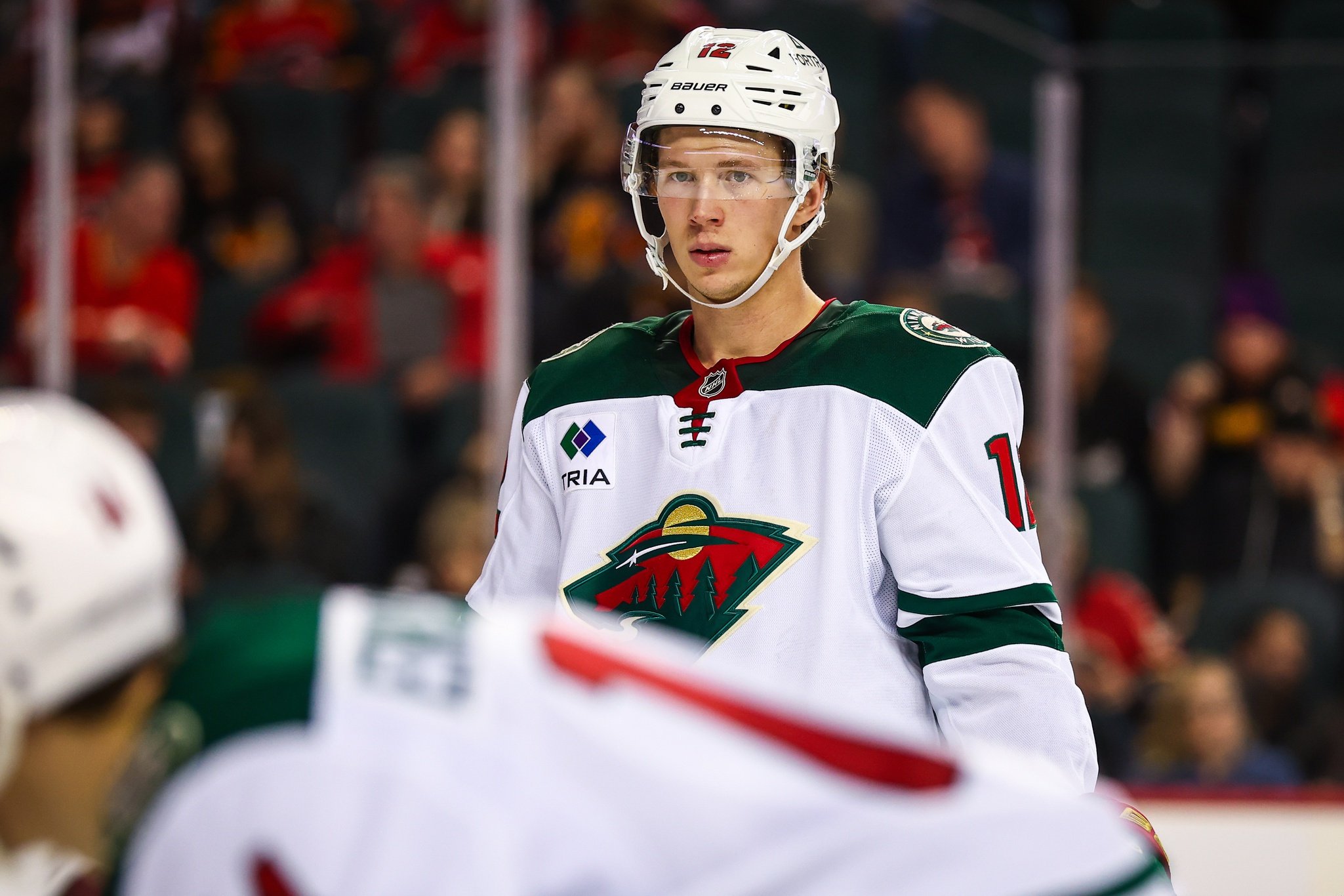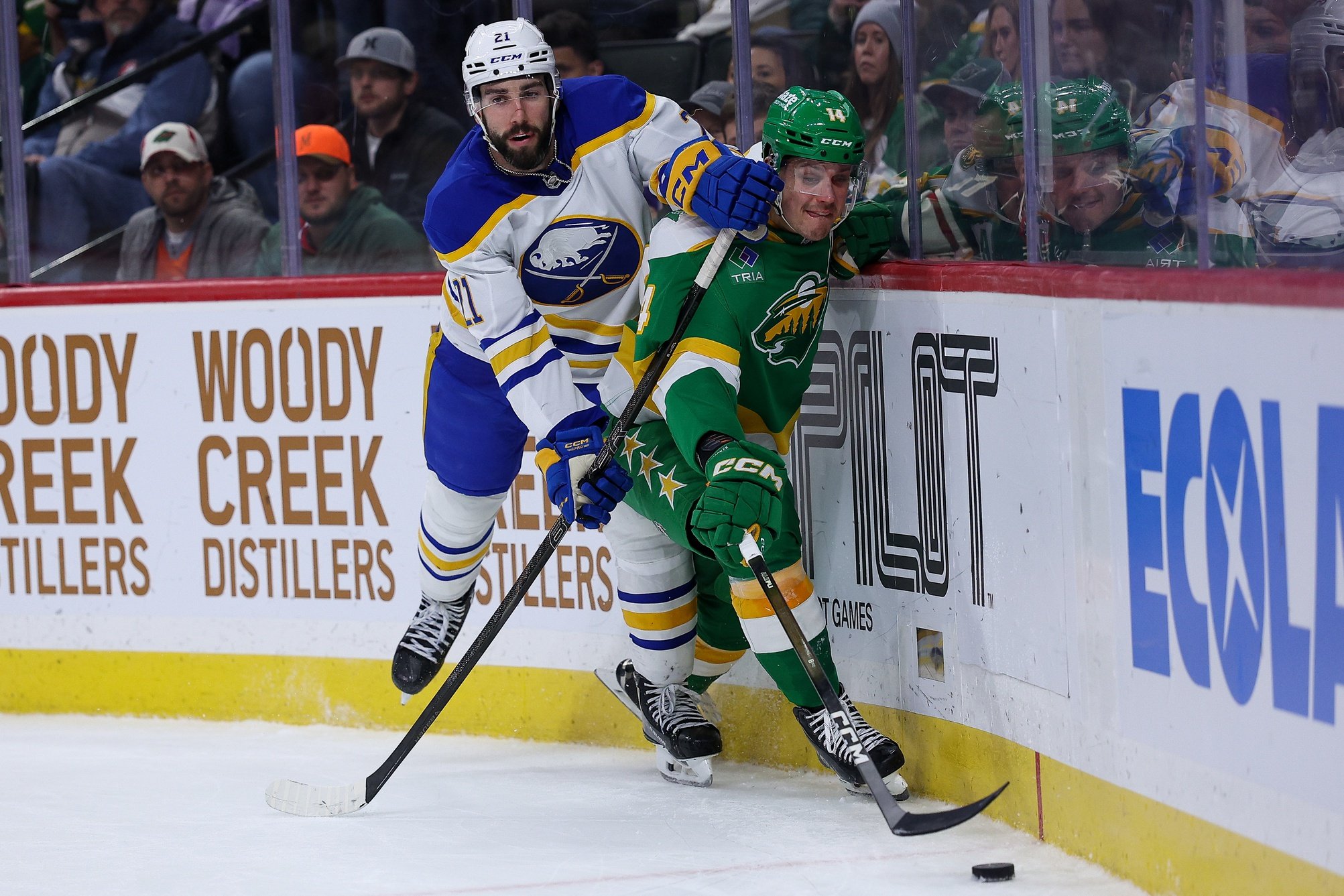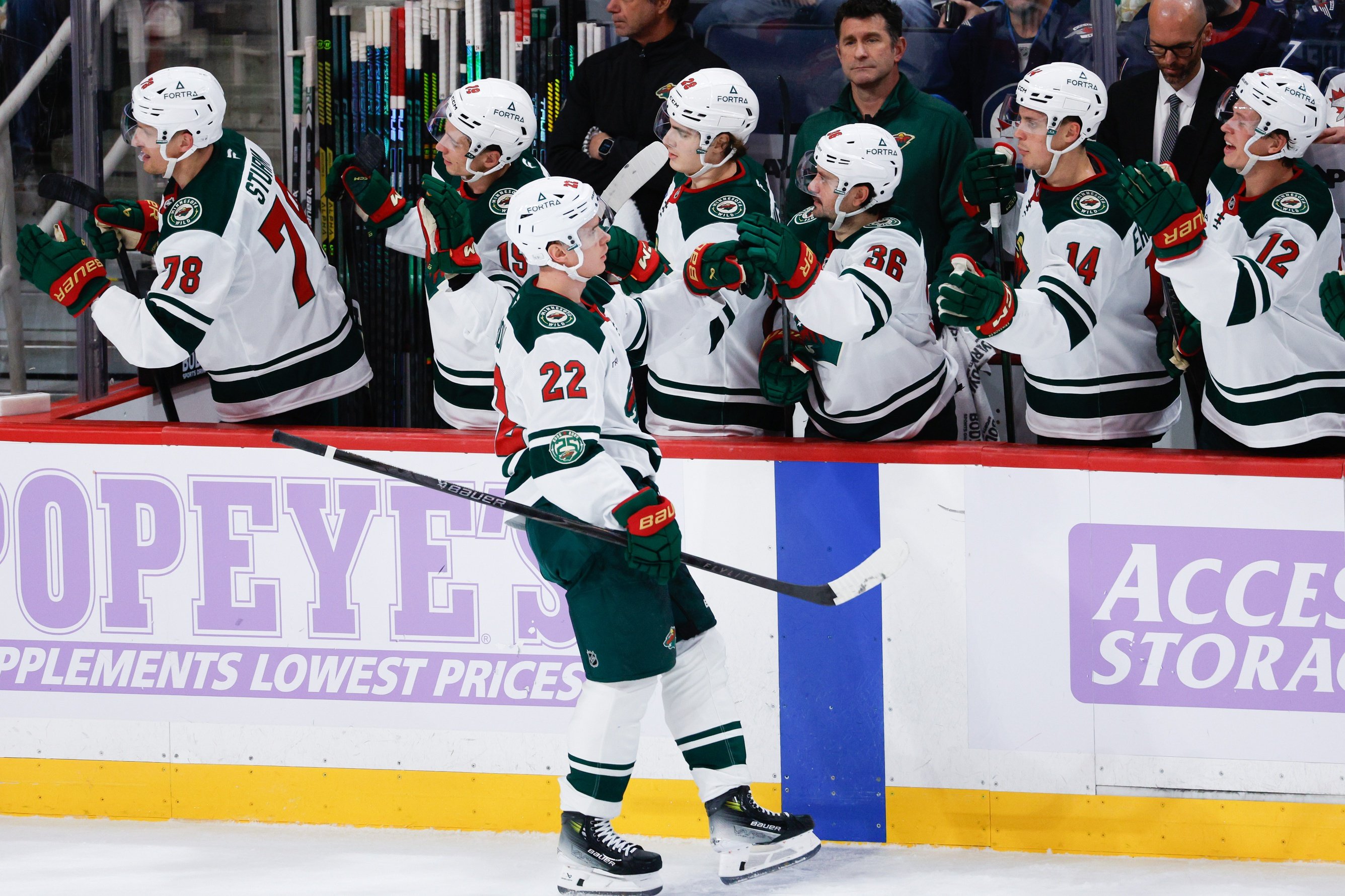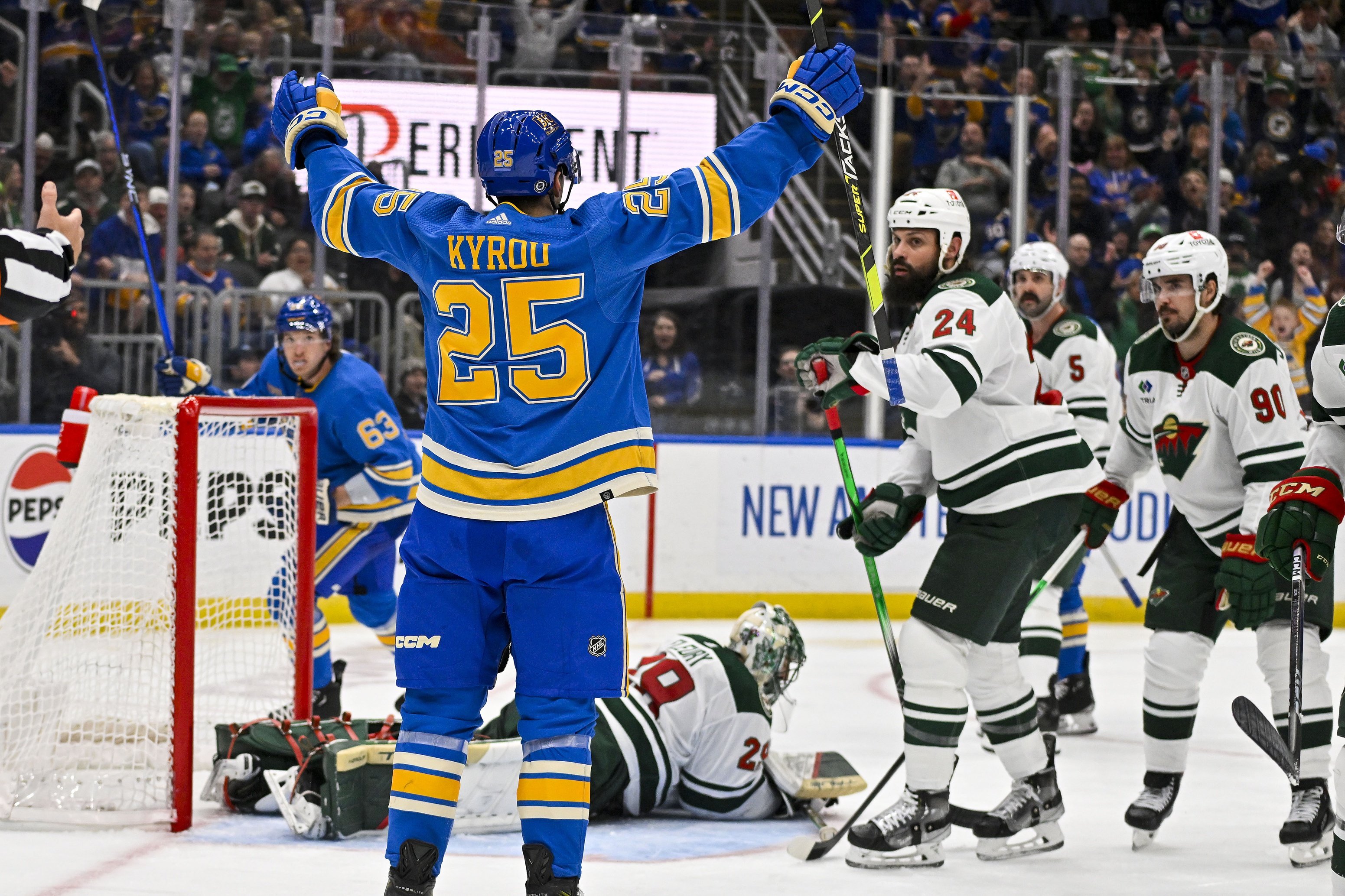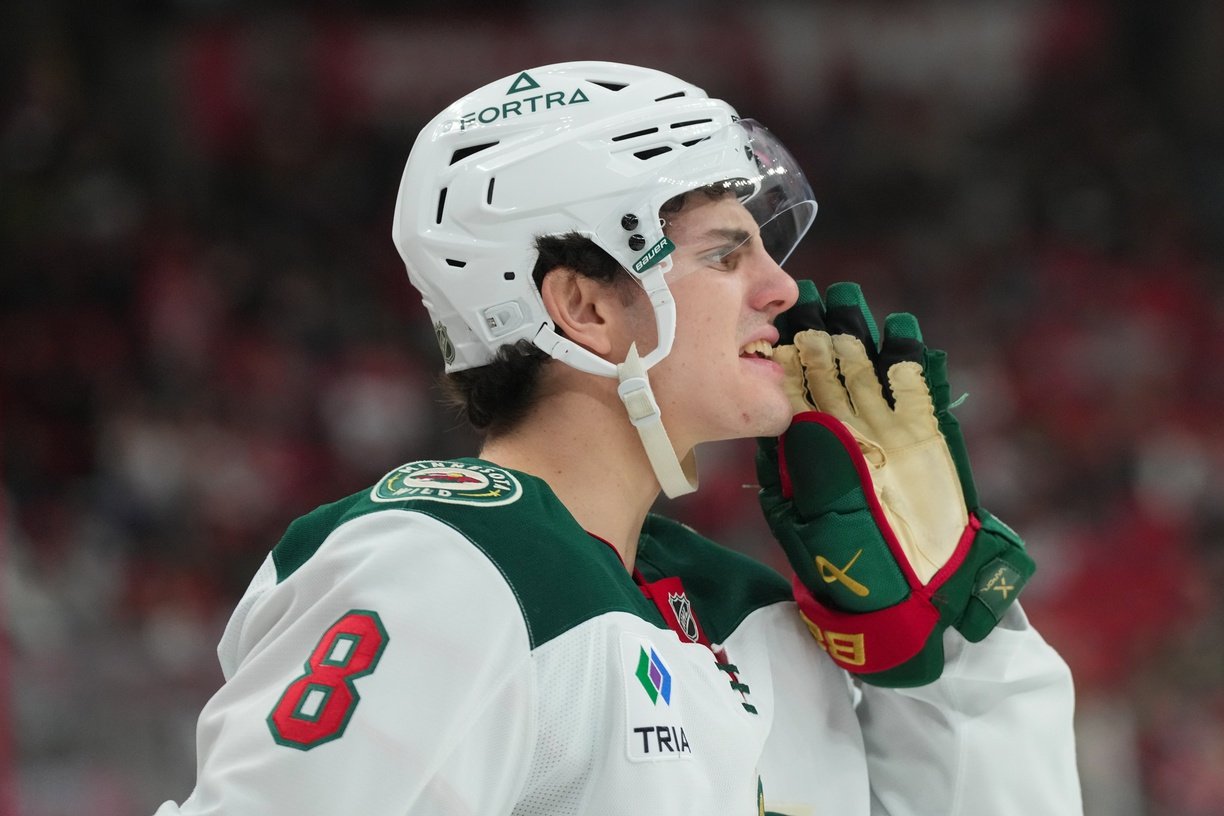Leaderboard
Popular Content
Showing content with the highest reputation since 11/13/2025 in Articles
-
Let’s start with the positive. Despite the Iowa Wild’s well-documented struggles in recent years, the Minnesota Wild’s roster features five young players who have spent significant time with their AHL affiliate over the past four seasons: Marco Rossi, Jesper Wallstedt, and Liam Ohgren are all currently playing key roles. Meanwhile, Daemon Hunt and recently-recalled Hunter Haight have also played games for the big club. Additionally, veterans like Tyler Pitlick and Ben Jones have done their jobs when called upon as injury replacements. However, from a team perspective, that’s about where the positives stop. After they appeared to turn a corner in October and won two of three to start November, Iowa has dropped six straight games and plummeted to the bottom of the AHL’s Central Division with a 5-14-0-1 record through 20 games. I watch a lot of Iowa’s games and have been taking notes on my observations as the season has unfolded. As the team passes the quarter mark of its season, it’s a good time to share updates on what’s happening in Des Moines with the team and some of its players. If you have a question about Iowa or any of its players that I don’t address below, feel free to post it in the comment section. No offense The numbers are ugly: out of 32 teams, they are 31st in goals scored (37) and 28th in goals against (68). Their power play sits at a putrid 10.6% (31st) and is in the midst of a 4-for-53 stretch. The penalty kill has been mostly solid lately, but still sits at 21st in the league at 79.3%. Gerry Mayhew leads the team with 7 goals and 3 assists in 16 games, despite not being signed until mid-October. Other than defenseman David Spacek, who also has 10 points (all assists), no other player is in double digits. Haight has produced 5 points in 14 games for Iowa, while Ohgren has had 5 in 9. Every player on the current roster has a minus rating. Goaltending woes and a lack of chemistry Goaltending has been a problem. In the offseason, the team brought in Cal Petersen, a veteran with 106 NHL games, to provide stability and serve as a reliable third-stringer. Still, he ranks 36th among 47 qualified AHL goaltenders with an .891 SV% over his 10 starts. Meanwhile, Samuel Hlavaj, who came off a stellar campaign last season in which he emerged as a legitimate prospect, is dead last in the league with an .871 SV%. The situation was so dire that the team decided to send a message and brought up William Rousseau from the Iowa Heartlanders in the ECHL to start the first game of the Grand Rapids series, a 3-2 loss in which he stopped 26 of 29 shots and played well. However, he probably wanted one of the goals back. Iowa put Petersen back in net for the second game, and he responded to the message with a solid start, stopping 28 of 29 shots in a 1-0 loss. Interestingly, Iowa has played Grand Rapids, who is dominating the league with a 16-1 record, closer than anyone, with three one-goal losses, one of which was in a shootout. Otherwise, it’s been a real struggle. The team recently hit what it hopes was rock bottom with two 7-2 losses in a three-game stretch: one to the Toronto Marlies and the other to the Milwaukee Admirals. The team’s struggle to find consistent lines that can develop chemistry has become apparent. Mayhew has been a fixture on the top line for a while, but the team has tried all sorts of combinations to little avail. Haight, Ohgren, Pitlick, Nicolas Aube-Kubel, and Caedan Bankier are among those who have recently played alongside Mayhew as Greg Cronin, and his coaching staff desperately try to find combinations that can fill the net. Where is Riley Heidt? One name that fans might notice is not among those playing top-line minutes: Riley Heidt, a much-hyped prospect in his first professional season. The 20-year-old rookie from Saskatoon has had a slow start, with 2 goals and 4 assists in 19 games. He’s mostly spent time in the middle six playing both wing and center. Most recently, he has centered a new-look third line with Ryan Sandelin and Jean-Luc Foudy during Sunday’s game against Grand Rapids. Heidt has the look of a player who lacks confidence and consistency as he learns to adapt his game to professional hockey. That’s very common among young players in the AHL, a tough, physical league with many veterans who know their roles and make life difficult for their opponents. Fans shouldn’t be concerned, but how Heidt handles adversity this year will be interesting to watch. One of the hallmarks of Heidt’s game during his time in junior hockey and at prospect events is tenacity without the puck. When he’s at his best, he’s hounding pucks in all zones and aggressively engaging in board battles, using leverage and positioning to win pucks. That has been notably missing for much of the season. Heidt is often hesitant to engage physically and guilty of reaching with his stick instead of fighting to get body position when contesting pucks on the wall. It’s night and day from the player that had fans and media raving about his bona fides as a prospect. With the puck, he’s lacking the aggression and straight-line drives that he has so often used to put pressure on opposing defensemen. It’s definitely worth noting that some of his offensive struggles are probably a product of his environment. When I wrote about Heidt after this fall’s Tom Kurvers Prospect Showcase, I noted how Heidt is “at his best when working in tandem with linemates who can read off his puck touches [and his] ability to make quick, efficient plays with the puck in all zones,” and how it would be important to find complimentary players that maximize his strengths. So far, there hasn’t been anyone in Iowa who can fill that role, and it’s probably contributing to Heidt’s lack of confidence with the puck. For a brief time, he was on a dynamic-looking line with Rasmus Kumpulainen and Oskar Olausson. Still, as injuries and call-ups shook up the roster, that line was broken up. Kumpulainen has struggled with consistency, as has Olausson occasionally. If I were Cronin, I might try Heidt with Mayhew, because Mayhew is an intelligent player with a track record of offensive success in the AHL. That might help jumpstart him. Bankier is a bright spot I’ve been back and forth with where to rate Bankier as a prospect. Last season, I wrote that he had the potential to be a valuable third-line center down the road, and earlier this season, I noted his continued improvement while also questioning whether he had the foot speed necessary to stick in the NHL. Since then, Bankier has been one of the bright spots in Iowa, and it recently rewarded him with the opportunity to center the top line and the power-play unit in the Grand Rapids series. Bankier is noticeable most nights because he's usually in the right spot and gets a lot of puck touches as a result. He’s got a really good release on his shot, which he can let go with power from multiple angles. It’s something he’s definitely improved at over the past year, and he’s tied with Mayhew for the team lead with 40 shots on goal. He doesn’t have scoring touch, and he’s not quick, but he is pretty efficient with his feet and has decent straight-line speed. He makes a lot of slick area passes and works well in motion on the power play. One of the hallmarks of his game is his stick placement when defending. He disrupts many plays and is an effective penalty killer. Another strength of his is that his game doesn’t change, no matter where he is in the lineup. He brings the same steady, two-way presence, which makes him a valuable piece. I’ll be watching Bankier closely as the season progresses to see if he can continue to elevate his game. He’s a restricted free agent after this season, and it will be interesting to see if he gets another contract with the organization and what that might look like. Czech mates on D Since being sent down by Minnesota a couple of weeks back, Jiricek has been playing big minutes on the top pair and top power play unit, while also getting a lot of run on the penalty kill. That’s probably what’s needed, and while Jiricek’s stats have been underwhelming (1 goal, 1 assist, and -5 in 10 AHL games), he’s not to blame for the team’s struggles. That said, he hasn’t been great, either. Defensively, he’s been mostly fine, but that’s never really been an issue for him. At this level, you’d like to see him making plays with the puck and using his size and length to create space. Instead, he’s been mostly vanilla when I’ve seen him, making safe plays and not really pushing the pace. Then again, maybe that’s the mandate he received from the NHL club after he displayed a propensity for bad turnovers during his time in Minnesota. David Spacek has been impressive this season, putting up 10 assists in 19 games and taking a spot on the top power play unit. He makes good puck plays in all zones, and his efficiency with zone exits and as a distributor on offense has continued to improve. He defends well with his skating and positioning, though he can struggle on the rush at times because he doesn’t have a powerful push when accelerating backwards. He’s much improved in board battles and is clearly stronger physically this season. There were reports last summer that Spacek might be unhappy with the opportunities he’s received in the Wild organization. While Minnesota briefly recalled him last month to serve as a seventh defenseman as the Wild dealt with injuries and illness, there doesn’t appear to be a path for him to stick in Minnesota anytime soon. He’s not a better option than anyone above him in the organization. That said, he’s more consistent than Jiricek and is light-years ahead of Carson Lambos and Jack Peart on the organization’s depth chart. It’s starting to look like Spacek has developed towards being nearly NHL-ready. It will be interesting to see what the Wild decides to do with him. Haight and Aube-Kubel are standouts Haight and Aube-Kubel have been the best forwards in Iowa. They play with a pace and straight-line decisiveness that sticks out relative to their teammates. With Haight, it’s just a matter of consistency and becoming more impactful with playmaking. His two-way game and physical play are NHL-caliber. While Haight is never going to be a goal scorer in the NHL, he can turn into a solid third-line player if he can become more of a difference maker with the puck on his stick. Aube-Kubel is a veteran who brings consistency, effort, and two-way play every night. He’s not flashy, but he’s got game and has proved to be a nice depth addition by the organization.12 points
-
Marco Rossi has been sidelined by a lower-body injury, according to a report from The Athletic’s Michael Russo. As a result, Russo and I must (separately) write about David Kampf. It would be one thing to write about Kampf joining a team other than the Minnesota Wild. Kampf is a solid role player who delivers middle-six quality forward play from the center position. His defensive impacts are effective, and he can chip in on the penalty kill when needed. His skill in the faceoff dot is also solid. He’s won between 51% and 53% of his faceoffs in each of the past six seasons, something that any beat writer (or me) will have to take a sentence or two to tell you about. I almost wasted another 15 minutes in Excel providing more context on just how many extra possessions this comes out to, until I remembered: I don’t care, and you shouldn’t either. Here is a list of things that David Kampf simply does not do: Drive offense Score goals Assist on goals Skate on the ice at the same time as his teammates have scoring chances Sure, it happens occasionally. But Kampf does none of these things above a fourth-line level. That is to say, below the 25th percentile. That has been true each of the past two years, as confirmed by Dom Luszczyszyn’s analytical model. There are many incorrect responses you could make to these numbers. Analytics are unfair to role players. They don’t know he’s shutting down the top line every night! Luszczyszyn’s model specifically quantifies the offensive and defensive impacts of opponents and teammates for the 2024-25 season. Kampf actually gets deployed against his opponent’s best defenders and worst offensive threats. The net effect was about two goals for and two goals against. I don’t believe in those made-up stats. Kampf’s faceoff percentage is something you can take to the bank. Made-up, like “goals” and “assists?” I’ll concede that “offensive impacts” are more of a black box. However, if you want to get real, offensive impact is mainly made up by shot attempts, the King of Hockey, with context given to the location of those shots. Compare that to faceoffs. While they are always credited to one team or the other as the winner, there’s no context for the quality of a faceoff win. The team that wins the faceoff can turn it over on the next puck touch. It also lacks context for where a faceoff occurs. Most teams give their most valuable faceoffs to their best centers, meaning the quality of competition has a massive impact on faceoff percentage, which raw faceoff win rate doesn't capture. Do you know who this looks like? Do you know which player on the 2024-25 Minnesota Wild looked just like David Kampf, but a little bit better? Freddy Gaudreau. We did it. We recreated Freddy Gaudreau in the aggregate. Let me be clear: I think Gaudreau is a serious NHL player. He could fit on many NHL rosters. But didn’t Minnesota seek a fourth-line center in free agency? If Nico Sturm weren’t a serious upgrade, why else send out Gaudreau? If the Wild wanted both players, they could have kept both! They traded Gaudreau for a reason, and it isn’t that the 2025 fourth-round pick they acquired for him is going to help them win a Stanley Cup. It’s that another role-playing bottom-six forward does not fit on this roster! And, Freddy Gaudreau is better than David Kampf! The only area Kampf has Gaudreau beat is that he will win between three and five more faceoffs out of every 100 faceoffs they see. None of this even begins to drive at the heart of the issue. It’s not that David Kampf should never take an NHL ice sheet again. He just brings nothing to the Wild that they don’t already have, while addressing none of the issues that have Minnesotans questioning this team’s playoff hopes. Examine this Wild lineup without Rossi: Kampf would slot in at 3C. Perhaps Yurov gets to stay on the third line, but it doesn’t really matter when you look at the wingers in that bottom-six. What if, instead, the Wild addressed that problem? Imagine if this team played with the above lineup, waited to accrue cap space, and put it into a second-line winger. Does it really look that different from blowing a quarter of their current cap space on Kampf and handcuffing their options at the trade deadline? (By the way -- when was the last time the Wild acquired a second-line winger? Drafting Matt Boldy in 2019? Trading for Kevin Fiala in 2019? Signing Ryan Hartman in 2021? Don’t you dare count trading for Marcus Johansson at the 2023 trade deadline.) Johansson slides into a third-line role next to Tarasenko and Yurov, replaced by Hartman when Rossi returns. Both versions of that line fit the mold of the line on which Tarasenko excelled in Florida. Some rotation of Foligno, Trenin, and Hinistroza keeps all three fresh and provides flexibility on the fourth line. Most importantly, though, this would address the two glaring weaknesses of the 2025-26 Wild: They don’t have a real second line, so they can’t out-score mistakes from their rookie defensemen. David Kampf could be Mikko Koivu 2.0, and it wouldn’t address that second weakness. No matter how good the other four players defend, there will be open space to the outside of Zach Bogosian. When Zeev Buium or David Jiricek’s brain falls out and he turns the puck over on the breakout, David Kampf’s faceoff win is not coming to the rescue. These things will happen many times over the next five months. It’s what happens when teams develop new defensemen. Without a serious secondary scoring threat, Minnesota will continue to give up leads and be unable to retake them. It’s time for the Wild to address the problem that has plagued this club since Kevin Fiala departed. The problem isn’t the depth forwards, and the solution isn’t another role player. David Kampf isn’t the answer for a team with Stanley Cup aspirations.8 points
-
In the age of analytics, player tracking, and data overload, sometimes the good, old-fashioned eye test gets overlooked as fans and media scrutinize players. There’s a reason for that, of course. History has proven that the eye test alone isn’t sufficient for overcoming biased perceptions or imperfect observations that can cloud analyses and lead to poor decision-making. However, there are times when you see a player, and you just know. That’s been the case with rookie Danila Yurov during his rookie season in Minnesota. Beginning with the Tom Kurvers prospect showcase, then in training camp and preseason, and on through the first 15 games of his NHL career, the 21-year-old from Chelyabinsk, Russia, has looked the part of an NHL player. His game at the Kurvers showcase was representative of a player still finding his stride. Still, even then, he clearly was a step above most of the prospects there. It was the first glimpse of the skating, puck pursuit, and remarkably mature two-way game that reflected a player who arrived in North America as a pro-ready prospect. Yurov carried that momentum into training camp, where he steadily progressed as the preseason went on, getting better with each game as he adapted to the smaller ice and faster pace. He displayed skating and hockey sense and diligent two-way play throughout camp. It was clear he was ready to be a valuable contributor and produce quality shifts regularly. Yurov’s game hasn’t been flashy, but it’s been steady. He’s in the right places. He stays above the puck, takes smart angles to win puck races, isn’t afraid to go to the net, and covers a lot of ice with his efficient skating. He just keeps getting better, little by little, and it’s been noticeable. John Hynes and the Wild coaching staff have clearly seen it too, deploying Yurov primarily at center after he began the season at wing. In the team’s most recent game, a 3-2 overtime win over the first-place Vegas Golden Knights team, Yurov played a season high 13:09, including nearly four minutes on the top line with Kirill Kaprizov and Mats Zuccarello after Ryan Hartman left with an injury. After the recent news that Hartman is week-to-week with a lower-body injury, and with Marco Rossi still on the shelf, The Athletic’s Michael Russo has reported that Yurov is going to get another shot with the Wild’s dynamic duo against the Carolina Hurricanes on Wednesday. Playing on the top line against the Hurricanes will be Yurov’s stiffest test yet. They have looked like a buzzsaw this season, overwhelming opponents with their depth, aggressive defending, and relentless forechecking. The Wild experienced this first-hand less than two weeks ago, when Carolina thoroughly outplayed them for long stretches during a 4-3 defeat. Yurov was a healthy scratch for the third consecutive game that night in Carolina. It’s not a coincidence that he's been in the lineup every night since. His skating and intelligence would have been an asset. The Wild first activated him the next night against the New York Islanders and made an immediate impact with a first-period goal. Yurov makes small but noticeable contributions almost every shift, and he’s starting to pass more than just the eye test. According to Natural Stat Trick, he has produced an expected goal percentage of 55% or higher in five of his past seven games, and the Wild have outscored their opponents 2-0 during his minutes over that time. Minnesota has also broken even with high-danger scoring chances during his minutes over that stretch. He produces these numbers with intelligent positioning, a surprisingly strong stick that can win puck battles or maintain possession under pressure, and excellent skating. On Yakov Trenin’s first goal of the season against Vegas on Sunday, Yurov made two key plays that led to the goal. The first was out-leveraging Ivan Barbeshev for a loose puck after the Wild entered the offensive zone, and the second was another won stick battle in which he beat Ben Hutton to a loose puck down low and poked it free to Trenin. He did that after he made the correct read to get to the corner and capitalize on a loose puck created by Marcus Foligno. Yurov earned his first career assist on this play, and the way he did it is indicative of how he’s been able to turn in a quietly impressive rookie campaign. Smart reads, timely positioning, and a good stick go a long way in the NHL, where victories often hinge on repeatedly winning the small moments. He’s still a young player who will have some rough nights here and there, and there’s a lot of hockey left to be played this season. Still, there’s no question that Yurov is becoming a valuable contributor to Minnesota’s lineup. Wild fans have long wondered exactly what type of player he’d be once he finally arrived, and they haven’t been disappointed. Because when it comes to this rookie, seeing is believing.7 points
-
Charlie Stramel’s progress was one of the Minnesota Wild’s most encouraging prospect stories this year. The former first-round pick had struggled in his first two NCAA seasons with Wisconsin after playing well with the U.S. National Development Team. His transfer to Michigan State and reunion with former coach Adam Nightinengale seemed to be a last-ditch effort to get his development on track. The move did wonders for the center, improving his point totals from eight in his last season with Wisconsin to 27 in his first season in East Lansing. His play this season has been even better. Stramel is building on his breakout junior year and showing even more signs that some people who called him a bust too soon were wrong. Michigan State is 14 games into its season. In those contests, Stramel has established himself as a true No. 1 center. He defends well, contributes offensively, and is a crucial part of a No. 3-ranked program in the country. Stramel is second on the team in scoring, with six goals and 11 assists, his highest points-per-game (1.21) output of his college career. His scoring jump has been partly due to Stramel's consistent, assertive play. He’s averaging 2.64 shots per game this season after putting up 2.3 shots per game last season. While the numbers on the stat sheet have been encouraging, a deep dive into Stramel’s play that’s produced them provides vital context. The first thing that stood out about Stramel’s play is that he’s continued to build on one of the best aspects from his last campaign. He’s doing a great job at using one of his best assets, his size, to his advantage. Stramel is listed at 6-foot-3, 216 pounds, and has always had a physical edge to his game. During his tenure in Wisconsin, he was unable to use that effectively to create offense, which was a significant factor in his lack of production with the Badgers. Since transferring to Michigan State, the Rosemount, Minn. native has been far more effective at playing like the power forward he projects to be at the next level. He can dominate in the offensive zone in front of the net and create offense with deflections, rebound chances, and generally create issues for the other team’s goaltender. Plays like the one above against Boston University are excellent showcases for Stramel’s instincts. As soon as the defender starts to follow the forward into the corner, Stramel parks himself in the newly vacated spot on the ice. The other BU defender is too burdened to put full effort into clearing Stramel out of the net-front area, which leads to Stramel’s deflection goal. Stramel’s ability to be a net-front presence has been a signature during his time with the Spartans. However, he’s also developed into a proficient distributor. When the Wild drafted Stramel, his passing was a trait that made him a first-round prospect. The EliteProspects 2023 NHL Draft Guide highlighted it as one of his strengths. Stramel's skill as a small-area distributor was a constant across our viewings, something that seemed immune to the noise around him. His ability to parry opponents and sequence plays with touch and pace from in tight made him a constant offensive driver during sustained offensive zone pressures. Like most of his talents, that distributing ability didn’t initially translate to college hockey. In 67 games with the Badgers, Stramel registered just 12 assists. His playmaking rebounding last year with 18 assists in 37 games, but it’s been even better this season. Stramel’s .79 assists per game this year (11 in 14 games) is by far the best of his career, going back to when he was with the U.S. National Developmental team. A few of Stramel’s assists this season highlight how much he’s improved as a playmaker. The goal above is an excellent example of the small-area distribution that Elite Prospects praised in their 2023 draft guide. Stramel jumps on a loose puck behind the net and has the vision to see Porter Martone alone on the other side of the net. It would be an easy play for Stramel to play the puck along the boards or try to maintain possession on the power play, but recognizing the opportunity to reverse play and find Martone is a quick decision that showcases his vision. That passing play is impressive and also highlights Stramel’s chemistry with forward Porter Martone. The Philadelphia Flyers took Martone sixth overall in 2025 after he made the jump from the CHL to the NCAA. Some players have had difficulty moving from Canadian juniors to college hockey, but not Martone. He leads all first-year students in the NCAA with 19 points, and that’s largely due to the synergy he’s built with Stramel. When Stramel distributes the puck the way he has this season, it unlocks a whole dimension to his game. It’s the perfect complement to his physical abilities. Stramel acts as a hub for the Michigan State attack, creating a gravitational pull with his size and strength. When defenders crash down low on Stramel, it opens lanes for his teammates. That style of play gives him potential to contribute offensively at the next level, even if he’s never expected to score like a top-six forward in the NHL. While it’s great to see Stramel perform in college, the important thing is to project whether he'll be a difference-maker for the Wild. That remains to be seen, but he’s much closer to it now than he was during his first couple of years in college hockey. Stramel is a physically gifted center who is responsible defensively, wins more than half of his faceoffs, and can drive a line with his assertive play and talent as a distributor. The Wild have struggled to find consistency at center in recent years, with faceoffs a particular weakness. He may not project as a star NHLer, but Stramel’s progress at Michigan State positions him well to at least get the chance to show he can play a role for the Wild after he finishes his collegiate career.6 points
-
There are superstars, there are Hart Trophy winners, and there are Hall of Famers. But there's nothing more terrifying than the [YOUR TEAM HERE] Killer. The guy who is liable to get a goal against your team every time they line up against your best defensemen. The player who can make you nervous in crunch time, even if no one else makes a peep against you. Minnesota Wild fans are no strangers to this concept. Jarome Iginla was perhaps the most notorious Wild Killer of all time, notching 39 of his 625 games against Minnesota... and that's without the team even existing for his first four seasons. Twin incredible Colorado Avalanche centers, Joe Sakic (16 goals, 38 points in 41 games against Minnesota) and Nathan MacKinnon (24 goals, 64 points in 52 games), could also lay claim to that title. But the Wild have, historically, been short on [OTHER TEAM] Killers. Their top goal-scorers, Marian Gaborik and Zach Parise, in particular, weren't known for being a thorn in the side of their top rivals. Or at least, until now. We've seen enough, we're calling it: Kirill Kaprizov is officially an Avalanche Killer. According to NHL Network's Top-100 player rankings, the Wild faced off against the second (MacKinnon) and fourth-best (Cale Makar) players in the entire league. They rolled into Grand Casino Arena with one (one!!!) regulation loss in 23 games. But Kaprizov was their equal as the Wild somehow went toe-to-toe with the Avs in a track meet. Kaprizov didn't score in overtime or the shootout, but he dragged Minnesota to the extra frame. His 200th and 201st goals were both the result of will over skill, crashing the net to cash in both times. It's far from the first game Kaprizov has terrorized the Avalanche. Friday was his 13th and 14th career goals against Colorado, making the Avs the team he's scored the most goals against during his career. It's the most that anyone has scored against the Avalanche since Kaprizov entered the league. It's not even close. Most Goals vs. Avalanche, since 2020-21: 1. Kirill Kaprizov, 14 T-2. David Pastrnak, 10 T-2. Kevin Fiala, 10 T-2. Gabriel Vilardi, 10 T-5. Tage Thompson, 9 T-5. Matt Duchene, 9 T-5. Tomas Hertl, 9 T-5. Evander Kane, 9 T-5. Adrian Kempe, 9 T-5. Joe Pavelski, 9 T-5. Jason Robertson, 9 T-5. Brayden Schenn, 9 T-5. Tyler Seguin, 9 It's just one example we see from Kaprizov of a true superstar trait: The ability to elevate his game against the best opponents. Kaprizov, Most Career Goals Per Game vs. Any Team, Career 1. Columbus Blue Jackets, 1.25 (10 GP) 2. Boston Bruins, 1.20 (5 GP) 3. Tampa Bay Lightning, 1.00 (7 GP) 4. Buffalo Sabres, 0.86 (7 GP) 5. Detroit Red Wings, 0.83 (7 GP) T-6. Vancouver Canucks, 0.75 (12 GP) T-6. Carolina Hurricanes, 0.75 (8 GP) T-6. Pittsburgh Penguins, 0.75 (8 GP) 9. Colorado Avalanche, 0.74 (19 GP) 10. Dallas Stars, 0.73 (11 GP) Of the 10 teams against which Kaprizov scored at the highest rate, the four in bold are the ones that've gone to the Conference Finals during that time. Predictably, the highest-scoring rates are against Eastern Conference teams, where the sample size is smaller, but a similar trend holds when we look only at the Western Conference. Kaprizov, Most Goals Per Game vs. Western Conference Teams, Career 1. Vancouver Canucks, 0.75 (12 GP) 2. Colorado Avalanche, 0.74 (19 GP) 3. Dallas Stars, 0.73 (11 GP) 4. Vegas Golden Knights, 0.65, (17 GP) 5. San Jose Sharks, 0.60 (20 GP) Again, we see Kaprizov putting up his biggest numbers against the best teams. The Avs, Stars, Golden Knights, and Edmonton Oilers are the only four teams to have gone to a Conference Final since Kaprizov entered the league, and Kaprizov has been able to show up against all four teams. Kaprizov vs. Colorado: 19 GP, 14 goals, 22 points Kaprizov vs. Dallas: 11 GP, 8 goals, 16 points Kaprizov vs. Edmonton: 14 GP, 1 goal, 14 points Kaprizov vs. Vegas: 17 GP, 11 goals, 16 points Kaprizov vs. WC Big 4: 61 GP, 34 goals, 68 points We're talking about a 46-goal, 91-point pace against these teams. You'd say that bodes well for Kaprizov in the playoffs, except, well, that Kaprizov's been about as dangerous a goal-scorer in the playoffs as anyone. He's had boom-or-bust series in the postseason, but there's no denying the overall picture, either. Goals Per Game, Playoffs, Since 2020-21 (minimum: 15 GP): 1. Nathan MacKinnon, 0.64 2. Adrian Kempe, 0.63 3. David Perron, 0.61 4. Kirill Kaprizov, 0.60 5. Chris Kreider, 0.56 6. Jake Guentzel, 0.55 7. Leon Draisaitl, 0.54 T-8. William Nylander, 0.50 T-8. David Pastrnak, 0.50 T-10. Brad Marchand, 0.49 T-10. Valeri Nichushkin, 0.49 No Wild fan needs to be told, "Kirill Kaprizov is good," of course. But as the question of "Did the Wild dramatically overpay for Kaprizov?" keeps bouncing around, it's games like this, against teams like the Avalanche, that show why he's priceless. There's no one else in Wild history that you can reliably expect to get a goal against top, top teams like the Avalanche, the Lightning, the Stars, and the Golden Knights. It's not close. Black Friday might be the day of discounts, but in the State of Hockey, it was a reminder of why the team decided to pay list price on their superstar.6 points
-
There’s no one-size-fits-all approach when it comes to winning in the NHL. While there are lots of ways to win a hockey game, the best teams in the league generally have a well-developed identity. The Florida Panthers are relentless forecheckers with total buy-in from every player; the Colorado Avalanche blitz with pace and puck possession. The Minnesota Wild kind of lacked an identity until they started winning. With the duo of Filip Gustavsson and Jesper Wallstedt, Minnesota is becoming a team built on a high-end goaltending battery. Wallstedt is the league’s hottest goaltender, with three shutouts in his last four starts. Gustavsson has responded by also playing his best hockey of the season, with a .921 save percentage since the start of November. The hot streak by both goaltenders has been the driving force behind the Wild going 9-1-1 this month and turning around a difficult start to the season. Two goaltenders playing so well could lead to a few outcomes. There may be some calls to trade one of the goalies while they’re at peak value. There could be a goaltending controversy over who becomes the clear starter. Or you could also have two good goalies. With Wallstedt and Gustavsson on team-friendly contracts, the best option is for the Wild to have two high-end starters. Thankfully, John Hynes seems bullish on going with a rotation. "Right now, the way both guys are playing is for sure. That’s what we’ve done for the last few games. I would anticipate that moving forward," Hynes said. "I think there might be opportunities and stretches in the season where you possibly could ride one guy a little bit more than the other. But the way our two guys are playing and competing, it looks like a good recipe right now." The duo also agrees that their high-quality play is pushing them to be better. Jesper Wallstedt reflected on the dynamic recently, saying that it’s been a positive development for both of their games. “It makes both goalies compete, and both goalies get better from it, I think," Wallstedt said. "I think if both want to play as much as possible and kind of make the other one play a little less, I think that’s a healthy competition, and obviously, I know my role a little more coming into this year.” That healthy competition has obviously worked wonders for the duo. We’re looking at stats from a small sample size, but they don’t even scratch the surface of just how dominant the duo has been. Since November 1, the Wild lead the league in 5-on-5 save percentage with their goalies saving 96.53% of shots on goal. They’re second in the league in that stretch in high danger save percentage with an 88.89% mark. That accomplishment is especially impressive considering the Wild are giving up 26.56 scoring chances against per game, which is 12th-most in the league. In that same time frame, Wallstedt leads the NHL in GSAA/60 (1.52) while Gustavsson places 18th (.38) out of the 73 goalies who have made more than one start. They’re also both top 20 high-danger saves per 60 with Gustavsson in 14th place (6.87) and Jesper Wallstedt in 18th (6.65). Of course, Minnesota’s goaltending in the last month is challenging to count on long-term. Wallstedt isn’t going to continue shutting out three of every four opponents he faces. There’s a difference between a goaltending hot streak and being difficult to score against being a franchise’s defining identity. That identity comes when a team pairs strong goaltending with a stifling defensive structure that supports sustained success in limiting scoring. Fortunately, that’s perfect for the Wild. Minnesota has always been at its best when playing defensively sound hockey. Since the 2022-23 season, the Wild have surrendered the 3rd-least high-danger chances against (2645) in the league while ranking 11th-lowest in high-danger chances for (2851). Minnesota also ranks 3rd in expected goals against per game (2.79) and is a bottom-ten team in expected goals for per game (2.95). It may not be the most exciting brand of hockey, but the Wild are clearly constructed to limit chances and play the dreaded “low-event” style. Still, while it may not be glamorous, it’s actually the perfect fit for a team that is leaning into an identity as hard to score against, with two elite goaltenders. It’s a formula that has produced positive results in the past, especially for teams that need to get as much as they can out of a roster with limited scoring ability. The best example of a template the Wild could follow is emulating the success of the Barry Trotz-era New York Islanders. From 2018-19 through 2020-21, the Islanders were one of the best teams in the NHL. They reached the conference finals twice, including a Game 7 against the eventual champion Tampa Bay Lightning in 2020-21. New York’s calling card was low-event hockey with potent goaltending duos. During that time, the Islanders led the league in save percentage from their goaltenders and, like the Wild, ranked in the top ten in expected goals against per game (2.61) and in the bottom ten in expected goals for per game (2.65). The Islanders achieved that defensive excellence with sterling goaltending duos, including Robin Lehner and Thomas Greiss, Semyon Varlamov and Thomas Greiss, and Semyon Varlamov and Ilya Sorokin. During that time, every goalie had a positive goals saved above average rating, and none started more than 45 games in a season at any point in the stretch. While they never reached the Stanley Cup finals, the Islanders clearly delivered strong results and were a tough team to play against every time they took the ice. In the past, the Wild have played that low-event style, but haven’t gotten good enough goaltending to follow through on it fully. That’s the issue with playing slow hockey. When you’re giving up goals and can’t keep up with scoring, it’s a bad recipe for winning. But that equation finally looks different now. With Wallstedt and Gustavsson giving Minnesota the goaltending this system has always required, the Wild can finally commit to the identity of being a goalie team.6 points
-
When a hockey team is painful to watch, it’s important to find a deeper reason to keep watching. The Minnesota Wild have been struggling, with a current record of 7-7-4 as I write this. While I’m a perpetual “rose colored glasses” sort of fan, not everyone can manage that. They need a deeper reason to keep positive and support the team. Here’s one of my reasons. One week ago, the Wild lost one of their biggest and most devoted fans. He wasn’t famous or well-known, but he never missed watching a game and was more passionate about this team than anyone I’ve ever known. His name was Mason, and he was my little brother. Mason passed away unexpectedly after a sudden medical emergency last weekend. A few hours before he died, he watched an amazing 5-2 win against the New York Islanders, with that Kirill Kaprizov-Mats Zuccarello back-and-forth goal being the last Wild goal he saw. I think that he died happy, with some hope that the team could turn things around. But even if they couldn’t, he would never stop supporting the Wild. That was his ride-or-die team, come hell or high water. Mason loved the sport of hockey more than anything. He started skating shortly after learning to walk and never looked back. Hockey was a year-round sport in our household, and as his big sister, I spent countless weekends in hockey rinks around the Midwest supporting him. Hotel room after hotel room, championship games or toilet bowl games at 7 am on a Sunday, it didn’t matter. The thing was, we didn’t do all of that because we thought he would ever make it as a professional. He was undersized all the way up until he graduated from high school. He was good, not great, but it didn’t matter. As a family, we were there for the love of the game, and Mason was at the heart of it. When his playing days were over, that passion shifted into being a fan. Once he could swing it, Mason started buying season tickets. Starting with one of the 11-game packages, he worked his way up to being a full-season ticket member this year. The funny thing was, he didn’t even live in Minnesota. But Mason wanted to be able to go whenever he was back in town and to share the love of hockey with friends and family, even when he couldn’t attend. Some of my favorite hockey games I’ve ever been to were with my brother. Mason and I went to Alex Goligoski’s 1,000th game celebration, where he scored the OT winner against the Carolina Hurricanes on November 19, 2022. I previously wrote about that game and how amazing it was. I cried like a baby and, honestly, I think Mason teared up too. We were at the game against the Vancouver Canucks, which ended 10-7 on February 19, 2024. Mason, in some sort of weird premonition of the upcoming game, had purchased two baseball hats at the Hockey Lodge before the game, even though he had come to the game wearing one already. He ended up tossing two of them onto the ice that game. The Wild were scoring so fast in the third period that the announcer couldn’t even announce them fast enough. We laughed and cheered so loud that we both lost our voices. Mason also waited in the virtual line to get tickets for our entire family to go to the Winter Classic when the Wild hosted it in 2022. I know people think it’s crazy to watch an outdoor game when the wind chill is close to -50°F, but it was perfect. Mason would go to buy a beer, and by the time he got back to his seat, it would be slush. The Wild lost, but the atmosphere was so fun that I tend to forget that fact. As I work on moving forward, drenched in grief, it is hard not to have my No. 1 hockey buddy along for the ride. Our text messages were a constant stream of NHL news, hockey quips and memes, and funny social media posts about our favorite sport. My mom would call and ask me if I’d heard from Mason lately. I’d have to say that, yeah, I talk to him every day, but only about hockey. I have no idea what’s happening in his personal life. We both functioned as a sounding board for the other when it came to our favorite sport. Most people I befriend will know hockey on a surface level or a lot about one team specifically, but Mason and I were hockey-crazy. We could share about league minimum guys, AHL teams, or Men’s or World Juniors, knowing that the other person knew exactly who or what they were talking about, no extra explanation needed. And now he’s gone. He’ll never again watch the Wild on TV, attend another game in person, or buy another jersey. Mason will not get to see Kaprizov break any and all remaining team records, Zeev Buium grow into the world-class defenseman we all know he can be, or the Swedish goalie tandem dominate the league. When the Wild win the Cup (and Mason and I firmly believe it’s a when and not an if), I will have to celebrate at the parade without him. But I will also celebrate for him. Even if this season becomes a repeat of the 2023-24 disaster season, I will still watch every game. Because no matter what, Mason would have been watching too. He is my reason for staying a fan, even when it is hard and breaks my heart. So if this season is becoming hard or even unbearable for you, please remember my brother Mason and keep cheering for the Wild. Because at some point, I need them to bring the Cup home to the State of Hockey for him. And hug your fellow hockey fans tight. We’re all in this together. If you’d like to learn more about the extraordinary human being my brother was, I'd love if you read the obituary I wrote for him because we lost a good one, folks.6 points
-
Picture this: You’re on your couch, favorite cold-weather snacks and beverages before you. Your favorite hockey team, the Minnesota Wild, is on television. The other team has committed some injustice punishable by two minutes in the box. Huzzah! Time for an Xcel Energy Power Play! But what’s this? They’ve lost the faceoff, and the other team dumps the puck. No matter. Surely regrouping and re-entering the offensive zone won’t be a challenge. Least of all with a five-on-four man advantage. Plus, that new kid, Zeev Buium, can really skate the puck. Kirill Kaprizov drops the puck back at center ice, and with a head of steam, here comes…Jared Spurgeon? Brock Faber? Frantically, you search the other forest green sweaters for No. 8, Our Savior. Alas, it’s nowhere to be found. 90 seconds of valuable top-unit power-play minutes seep away. Soon enough, the power play ends. The opponent’s infraction goes unpunished. You’ve lost your appetite for those snacks and beverages. In its place, an appetite for John Hynes’s still-beating heart burns in the pit of your stomach. If you think Zeev Buium is the best option to lead Minnesota’s power play, the data backs you up. When he’s on the ice, the Wild's power play is at its most efficient in high-danger shots, shot attempts, and expected goals (xG). Those numbers are all on a per-minute basis, courtesy of MoneyPuck.com. That’s not just because he gets to play on the top unit more frequently than other defensemen, either. If we filter Minnesota’s defensemen to power play minutes when Kirill Kaprizov is on the ice (a reasonable proxy for PP1 minutes), Buium still leads the team by a significant margin in all the most important numbers, according to NaturalStatTrick.com. This impact also passes the eye test. As talented as Faber and Spurgeon are, neither of them matches Buium’s ability to carry the puck into the zone, work the blue line, and find his teammates in high-danger shooting lanes. That’s why it’s supremely frustrating to see Buium’s share of ice time with the top power play unit diminished by minutes for Spurgeon and Faber. Again, using five-on-four time with Kaprizov as a proxy for PP1 minutes, Buium has played only 59% of the time. Part of the reason for that is that Minnesota’s top two right-handed defensemen are capable power play quarterbacks. Over the past two seasons, their man-advantage impacts from The Athletic’s analytical model have been good-to-great. In 2023-24, Spurgeon and Faber ranked in the 99th percentile of defensemen by power play impact. Part of that spectacular rating is that teammate and opponent impacts weren’t measured in the model for that season. In other words, playing often with Kirill Kaprizov (sometimes against opponents’ second- or third-best penalty kill units, given the 90-second shifts often given to Hynes’s top unit) heavily skews those 2023-24 power play impacts. However, the numbers from the same model for the 2024-25 season do account for opponent and teammate impacts. Spurgeon’s results drop off dramatically to the 22nd percentile, but Faber still comes in at the 65th percentile. He’s not lighting the world on fire, but he’s certainly capable. That partially explains why Faber and Spurgeon have been on the ice for 41% of the Wild’s top power play minutes. Combine Faber’s abilities with the fact that Buium is a rookie, and it’s not easy for the Wild to explain to Faber and Spurgeon why they would be reducing their power play minutes this season. Even still, Buium’s effect on the Wild power play is noticeable beyond the numbers. It just feels more dangerous when he’s on the ice. He draws opponents into his gravitational pull and uses his unique skating and stickhandling to pass into dangerous areas. Why not use him all the time? Simply put, Hynes has never stuck with one power play quarterback in either of his two previous seasons in Minnesota. Looking back at defensemen’s share of PP1 minutes in ‘23-24 and ‘24-25, Faber was typically the go-to guy. Even still, Faber only drew about 55% of available minutes with the top power play unit. Note that for ‘24-25, minutes with Matt Boldy were used instead of Kaprizov, since Kaprizov missed half the season with injury. With this context, it seems that the hair-pulling over Buium’s time on the top power play is overblown. It seems this has less to do with Hynes demoting Buium and more to do with Hynes’s overall power-play philosophy. He relentlessly tinkers with the power-play quarterback. Most likely, there is a good reason for that tinkering. If the point man is right-handed, he has access to different plays than a left-handed player. Faber and Spurgeon are more defensively responsible -- especially Spurgeon, who has a better xG% in his five-on-four minutes. That means that, after accounting for chances given up the other way, Spurgeon is more efficient on the power play. Hynes might prefer Surgeon against teams that deploy a more aggressive penalty kill system or whose penalty kill employs skilled scorers. On top of that (and much to the chagrin of Wild fans who just want to see them let the kid loose!), top-unit power-play minutes are a powerful motivator. It’s easy to lose sight of the human aspect, but Buium is a 20-year-old rookie. Teaching him to be a professional athlete is part of his development. That doesn't mean that Hynes is right for reigning in Buium’s PP1 minutes, but it offers an explanation as to why it might be necessary, or even optimal. So, try not to have a heart attack when Spurgeon or Faber is first over the boards next time Logan Stanley gets up to whatever evil action takes hold of his black heart. Buium is the team’s best power play quarterback, and the team seems to know that.5 points
-
By the time you read this, Giannis Antetokounmpo might be on the move in the NBA. Crazier things have happened in the NBA, just in this calendar year alone. The Dallas Mavericks swapped Luka Doncic for Anthony Davis, for crying out loud! The Houston Rockets landed Kevin Durant in a seven-team trade. It's the NBA. Anything is possible. Ever since this summer, Bill Guerin has been hoping for this kind of franchise-changing opportunity to arise for the Minnesota Wild. But when Guerin asks the NHL if he could trade for a Giannis, the NHL GMs are quick to tell him that they've got a Like-New Giannis-quality player on their team. Then that Giannis-type guy is someone like... Kiefer Sherwood. According to The Athletic's Michael Russo, the Wild were in on him when the price was "a good, young prospect," but apparently balked when the Vancouver Canucks raised their ask to "a good roster player" and/or a first-round pick. It's a bit too easy to dismiss Sherwood, now one of the hotter commodities on the NHL trade market, as a complete non-entity. He didn't secure a regular NHL role until age-28, and his 12 goals this season are fueled by a shooting percentage of nearly 20%. He's putting up OK numbers with the Canucks (12 goals, 16 points in 29 games), but that sort of thing happens when you give someone 17 minutes a night. Even for a last-place team like Vancouver, someone's gotta score some points. Sherwood's got some of the red flags you'd associate with being fool's gold in the NHL, but to call him that is not entirely accurate. Sherwood isn't likely to score 30 goals (the pace he's on, even after a recent slump), but he sneakily drives offense in the middle-six and loves to mix it up physically. Sherwood is second in the NHL with 124 hits this season. Trading for Sherwood seems like a nice little bit of business, except that the Wild is a team basically built out of Kiefer Sherwoods. Obviously, they have star power in Kirill Kaprizov and Matt Boldy, but when you get past their top-six (when healthy), it's hard to find players who aren't some version of Sherwood already. What's the difference between Ryan Hartman and Sherwood, for example? How about Marcus Foligno? Or Yakov Trenin, who is the only player in the league with more hits than Sherwood? Sure, Guerin has to work with the trade market in front of him, and that's an NHL landscape, not an NBA one. The Wild could trade for Sherwood (who makes $1.5 million against the cap as a rental) without restricting other avenues of improving too much, and doing so is probably an upgrade over someone like Tyler Pitlick. Heck, Sherwood would likely be an improvement over the much bigger-name Vladimir Tarasenko. At the same time, it's very Weird (and Wild) that Guerin is looking to trade for the exact kind of player they always go out and get. Someone physical who can play in your bottom six and/or maybe move up if someone gets hurt?! That doesn't sound anything like Justin Brazeau, Jakub Lauko, Pat Maroon, Ryan Reaves, Nic Deslauriers, or Nick Bonino! Look at all the resources Minnesota has already put into building a bottom-six that tries to balance physicality with some offensive production. $4 million for Hartman and Foligno. $3.5 million for Trenin. That's $11.5 million they spent on three Kiefer Sherwoods rather than, say, Nikolaj Ehlers, and $3 million to try to find the next Sherwood. Now, look what they've gotten for it. Those three have a combined six goals in 77 games this season, have collectively been out-scored 15 to 22 when on the ice at 5-on-5, and have given the Wild minus-0.4 Standings Points Above Replacement, per Evolving-Hockey. That's despite Trenin putting up 1.1 SPAR. Is Sherwood going to help some team? Probably. But the Wild should be one of the teams that need Sherwood the least. They've paid three players more than double Sherwood's salary to be that kind of player. If they're still in need of Sherwood, something's gone wrong -- which the numbers for Foligno and Hartman would seem to indicate. If that's the case, the person who made those extensions, despite them likely aging poorly, is looking to double down on more physical middle-to-bottom-six players in their 30s. The Wild have had the same problem for 25 years now: They don't have enough skill to win anything but a low-scoring slugfest. It's hard to say what the solution is, but Guerin has spent years trying to throw more grit at this problem, and trading for Sherwood would simply be more of the same.5 points
-
When Bill Guerin told the media before the start of the 2024-25 season that Matt Boldy had 50-goal, 50-assist potential, those seemed like some massive shoes to fill. For context, even Kirill Kaprizov, with as many goals as he scores, hasn't hit a 50/50 season. But through 20 games, it looked like Boldy was going to validate Guerin's call, 11 goals and 22 points, or a 45/45 pace. Then, that pesky middle-of-the-season slump hit him. Boldy hit a 35-game dry spell, during which he put up just 7 goals and 23 points. Granted, a strong finish led him to a career-high 73 points, and an even stronger playoff performance carried optimism going forward, but it wasn't the superstar breakout many had hoped for. So through the first 20 games of this season, when Boldy amassed 10 goals and 11 assists, that was something Wild fans had seen before. That's the first step to superstardom. The next step is keeping that momentum going. Four games past the 20-game mark, and it seems Boldy is up to the challenge. He's been explosive in the last four contests, racking up two three-point efforts. He's been consistent, scoring a goal in three of those four games. Perhaps most importantly, he's been at his best in big moments. His game against the Carolina Hurricanes saw him turn a penalty kill to hold a 1-0 lead into a goal, then clinch the game in the shootout. When the Wild could have dropped a game to the upstart, but inferior, Chicago Blackhawks, Boldy stood tall at the net-front and slam-dunked the tying goal in the third period. While Kaprizov's laser of an overtime winner was the headliner, there was Boldy, finding Kaprizov in a position to score. And compared to last season's second quarter? It's not even close. Matt Boldy Scoring, Games 20 - 41 2024-25: 3 goals, 12 points 2025-26*: 4 goals, 7 points (*four games) Boldy doesn't even have the benefit of playing his 5-on-5 minutes with Kaprizov and Marco Rossi, as he did at the start of the season. He's not being an elite second banana, the Mikko Rantanen to Nathan MacKinnon. Boldy is functioning as the Leon Draisaitl to Kaprizov's Connor McDavid. Joel Eriksson Ek and a rejuvenated Marcus Johansson provide the defensive and puck-carrying complement to Boldy's do-it-all game. Still, Boldy has indisputably been the star of the show. And being apart from Kaprizov hasn't derailed him from putting up big-time numbers. Boldy entered Friday's action tied for third in the NHL with 14 goals, alongside Draisaitl, Kaprizov, Brad Marchand, Jason Robertson, Bo Horvat, Cutter Gauthier, Connor Bedard, and Macklin Celebrini. With 14 additional assists through 24 games, Boldy is now on track for... Oh, my... 47 goals and 47 assists. Three off from 50/50. Now, Boldy has to keep up this play for the rest of the season, and slumps are going to happen, no matter how consistent he plays. But there's a difference between a minor slump and one that lasts half the season, and the encouraging thing about Boldy is that he's already pulled out of a slow stretch in a timely manner. Boldy scored four goals in each of his first four games, and then the pucks stopped going in. He came away with one tally and five points in the next 10 games. But now, he's back and so hot right now. In his past 10 games, he's notched nine goals and a whopping 15 points, with five multi-point games during that stretch. The Wild can't just ride Kaprizov to playoff success. Every real contender has a second star to break games for their team, to step up when the main guy is sputtering. There are 58 games left in the season, but so far Boldy's not slowing down and is making his bid to be the legitimate No. 2 his team needs.5 points
-
The State of Hockey wakes up on Saturday to the rumbling aftershocks of the Quinn Hughes trade. And in taking the temperature based on comments on Hockey Wilderness, elsewhere on the internet, and personal text messages, it seems one of those shocks is of the sticker variety. One can definitely argue that the Vancouver Canucks maximized their return for Hughes. The jewel of the trade for them is Zeev Buium, who came into this season as a consensus top-10 prospect in the NHL. They got a legitimate top-six center in Marco Rossi, who is 24 and coming off a 60-point season and a good start before injuries struck. They got a solid NHL-ready(ish) prospect in Liam Öhgren, and a first-round pick in 2026. It's a really good haul for a rebuilding team forced to sell off a franchise player. The largest point of contention seems to stem from surrendering Buium in the deal. NHL teams are usually loath to give up prospects of Buium's caliber -- they're young, cost-controlled, and full of potential. Putting on the Sigmund Freud glasses to psychoanalyze the fanbase, perhaps they have lingering memories of the Wild giving up Alex Tuch as a top prospect before he was able to establish himself in Minnesota. Or it might not be that deep. Buium's the rare prospect where you can throw around comparisons like Hughes or Cale Makar and not sound like someone who breathlessly compares J.J. McCarthy to Tom Brady. It makes sense that fans would be attached to the idea that he, too, could grow into being a player like Hughes. Why surrender Buium plus two roster players and a first-rounder if Buium might grow into the role in the near future? The reason why is simple: Hughes is the Hughes-like player that we think Buium can become. There's uncertainty with Buium, and no, it's not because he didn't immediately take the NHL by storm. It's unlikely that he will be Hughes, mostly because most prospects -- hell, most S-Tier prospects -- don't turn into Hughes. Hell, Luke Hughes has the same parents as Quinn, and he hasn't even turned into Quinn yet. The Athletic's Corey Pronman may have illuminated that point when he spoke at length about Buium ahead of this season. "[Buium] brings you out of the seat with his talent. He's so skilled, so smart, so dynamic. A great skater," the normally reserved prospect evaluator gushed. "When I see him. "Honestly, when I watched him, I see (Zach) Werenski. I see that guy at the same age." Look, Zach Werenski rocks. He contended for the Calder Trophy in his rookie year with a 47-point season. He's scored 20 goals from the blueline twice. Last season, he finished runner-up for the Norris Trophy and seventh for MVP, and he's producing at a point-per-game pace this season. And yet, as great as he is, he's not transcendent in the way Hughes is. Werenski has averaged 57 points per 82 games throughout his career, while Hughes is averaging 77. Werenski's play has been worth a cumulative 23.7 Standings Points Above Replacement throughout his career, while Hughes is at 27.3 SPAR... and that's with 134 fewer games. Hughes has also been a Norris Trophy finalist twice before his 26th birthday, while Werenski didn't accomplish that until his age-27 season. Buium has the talent to beat the odds, sure, but it's much more likely that he's "just" a No. 1 defenseman than an All-World defenseman like Hughes. It's just simple probability. The Vancouver Canucks know this, too. They didn't make this trade because they were excited about cashing in a 26-year-old Hughes for a younger version. As Vancouver beat writer Harman Dayal wrote for The Athletic, "With the writing on the wall that Hughes wasn’t going to re-sign in Vancouver long-term, the Canucks had to do their best to minimize the pain." The Canucks almost certainly would have preferred to keep Hughes. That fact alone should dispel the reservations about the price involved. Trading for Hughes also means giving up Marco Rossi, who has looked like a low-end No. 1 center over the past two seasons. Rossi's a strong player with a nose for the net, a responsible two-way game, and sneaky grit. Is he ever going to be considered an MVP candidate? Probably not. Meanwhile, Hughes is at that level. As for Öhgren and the first-round pick? The former might be a solid middle-six winger, while the latter is a lottery ticket. So if we're scoring at home, there are just two risks for this trade: That Buium hits his 99th-percentile outcome and becomes a Hughes-type player, and that Minnesota can't convince Hughes to stay in the State of Hockey. Are the risks noteworthy? Sure, but they're also acceptable. And even if one of those outcomes happen, that might not mean Minnesota automatically loses the trade. Buium might be everything the Wild think he'll be, but the fact of the matter is that Minnesota needed him to be a superstar this season to maximize their Stanley Cup window. That's not a fair expectation, maybe, but that's how the Wild are built. Kaprizov is healthy, on pace for 47 goals, and most crucially, making $9 million against the cap before his cap hit nearly doubles. Important players like Mats Zuccarello, Jared Spurgeon, Marcus Johansson, and Marcus Foligno are well into their 30s. Their cornerstone players: Kaprizov, Matt Boldy, Joel Eriksson Ek, and Brock Faber are in the age-23-to-29 sweet spot. The Wild still have about $6.3 million of deadline cap space to make another move. For those reasons, this may be the year Minnesota is best-suited to make a run. So if it costs Rossi, Öhgren, and a first-round pick for Bill Guerin to, effectively, hit fast-forward for six years of Buium's development, that's worth it. Wild fans should already know how challenging it can be waiting for prospects when the contention window says it's go-time. That's what happened with the Zach Parise/Ryan Suter Wild core. They waited for top prospects like Mikael Granlund, Charlie Coyle, Jonas Brodin, Matt Dumba, Jason Zucker, and Nino Niederreiter to grow up fast and boost an aging core. Those players reached a high level in the 2016-17 season, but by then? Parise and Suter were 32, and their best years were behind them. Mikko Koivu was 33, and about to go into decline. They had the one great season that year, got goalie'd in the first round, and that was that. Acquiring Hughes is about avoiding that mistake. Having Hughes and Kaprizov in the fold and in their primes over the next two seasons gives Minnesota two playoff runs that look more promising than any in franchise history. They don't have to wait for someone to hit their stride, hoping they'll fall in the middle of the Venn diagram between prospects developing and aging veterans holding on. The pieces are largely in place, go win some games. That probably makes the deal worth it even in the worst-case scenario: that this ends with Hughes walking in the summer of 2027. Again, Kaprizov's at the absolute height of his powers, at age 28. The Wild hope he'll age well, and his all-around skill set suggests he should still play at a high level into his 30s, but his ability to bring a Cup to Minnesota is probably at its apex this year and next. Hughes and Kaprizov for two years might represent a greater chance at the Cup than Buium and Kaprizov for the next nine. Besides, seeing as the Wild are the only team to have written a $17 million check to a superstar, it's going to be tough to call it a slam-dunk that Hughes will be gone in two years. Much like it was with Kaprizov this summer, the price for Hughes was substantial, but also, it's a price any team should be willing to pay. Players as good as Hughes don't hit the trade market often, and certainly not when they're in the middle of their prime. You pay whatever price to get those players when they become available, because regardless of what's getting sent back, the team landing an All-World player is going to walk away the better deal.4 points
-
Credit to Minnesota Wild general manager Bill Guerin: He did it. When the Wild were finally on the cusp of losing the titanic twin dead cap hits from the Zach Parise and Ryan Suter buyouts, an overjoyed Craig Leipold told the media, "Next July 1 is going to be like Christmas." That was in October 2024, and when July 1 (and then July 31, and the 2025-26 season home opener, etc.) came around, it was looking as if Christmas wasn't coming. 31 Grinchy General Managers denied the Wilds down in Wildville an impact player, and with the trade market ground to a halt since the summer, it was looking like that'd remain the status quo. But here's the thing: No one can know when a superstar is going to become available. All Guerin could do was keep his powder dry, which he did. He didn't tie up cap room with an expensive, but underwhelming UFA signing. He didn't cash in his chips for a good-but-not-difference-making player like Jordan Kyrou. He waited for an opportunity and shot his shot when the time was right. Trading a player like Quinn Hughes doesn't happen, and a big part of that is that there's not many players like him to begin with. It's not sufficient to call him a "No. 1 Defenseman," a "star," or even a "superstar." Hughes is a franchise-changing presence. He's one of 12 defensemen ever -- EVER!!! -- to score 90 points in a season. Better yet, he's in his age-26 season, his absolute prime. The rare players who are like him -- Cale Makar and Erik Karlsson being the only ones from this century that feel like Hughes' true peers -- elevated their teams in ways almost no defenseman can. Makar has a Stanley Cup and two Norris Trophies under his belt at age-27, while prime Karlsson (who won the Norris three times) dragged an uninspiring Ottawa Senators team to within one game of the Stanley Cup Final in 2017. The price going the Vancouver Canucks' way -- Zeev Buium, Marco Rossi, Liam Öhgren, and a 2026 first-round pick -- might make some squeamish. This is a topic to be discussed another day in full, but it must be stressed that Hughes is a caliber of player worth the cost for two crucial reasons. One, Hughes fills the Wild's biggest need: A game-changing defenseman. Not merely a very good defenseman, as Minnesota has employed plenty of those, from Jared Spurgeon to Jonas Brodin to Ryan Suter to Matt Dumba and more. Maybe Buium could have been Hughes in time; we'll find out how well he fills those skates in Vancouver. But make no mistake: Hughes is the 99th percentile outcome for Buium. Buium could become extremely good, a legitimate No. 1 defenseman, and still not be close to Hughes' level. The gulf between Hughes and any defenseman not named "Makar" is enormous. Hughes has 267 points since the start of the 2022-23 season, more than anyone but Makar (285), and crucially, 34 more than third-place Josh Morrissey. In terms of Hughes' impact on his team, Evolving-Hockey measures his impact during that time as being worth 20.7 Standings Points Above Replacement, tops among all defensemen. Second place is Adam Fox (18.0), and Makar is in third (17.5). Put another way: For every 82 games, Hughes' play is worth a point in the standings more than the next-best defenseman. That's a massive need for Minnesota, but it wasn't the team's biggest need. No, that was one that felt almost silly to mention, as it felt unrealistic as recently as Friday morning. The Wild needed another top-10 player to pair with Kirill Kaprizov, and they got one. Not only that, it's a legitimate debate as to whether Kaprizov is the best player on the Wild. In fact, the temperature of the NHL before the season was that Hughes was slightly above Kaprizov. In The Athletic's Player Tiers, which was built with input from sources from around the NHL, both were MVP-caliber players, with Hughes landing in Tier 1B (eighth overall) and Kaprizov in Tier 1C (tenth). The Wild are now one of three teams with two MVP-caliber players in their lineup, with the Colorado Avalanche (Makar, Nathan MacKinnon) and Edmonton Oilers (Connor McDavid, Leon Draisaitl) being the other two. Those teams made up three of the last four Western Conference Finals winners. And now, the Wild get to be in their league, at least at the very top of their lineup. What happens next will be fascinating. How much can Hughes push the pace for the Wild, both at 5-on-5 and on the power play? How insane will a top pairing of Hughes and Brock Faber be, perhaps? Does Danila Yurov have what it takes to backfill the loss of Rossi? Or heck, with Kaprizov and Hughes together, does the center position even matter all that much? We'll start finding out those questions as soon as Saturday, but in the meantime, enjoy the moment, Wild fans. It's Christmas morning, and now the Wild have a Quinn Hughes. Ho ho ho.3 points
-
The Minnesota Wild have made the biggest trade in the NHL's modern era. They have acquired world-class defenseman Quinn Hughes from the Vancouver Canucks. Reported by Sportsnet's Elliotte Friedman first and then multiple other sources confirmed with more details, the Wild have moved several key pieces for the future to go all-in for at least the next couple of seasons with one of the best defensemen the world has seen in this century. To bring Hughes to St. Paul, the Wild reportedly sent top rookie defenseman Zeev Buium, center Marco Rossi, young winger Liam Ohgren, and the 2026 first-round pick to the Canucks. Essentially, the Wild took a large chunk out of their future to commit themselves to this current team. Rossi is the oldest of the bunch at a ripe 24 years old and would've been top-of-the-lineup building blocks for the Wild, but have now been shipped to Vancouver to get one of the best talents the NHL has ever seen available via trade. But that's just focusing on what the Wild gave up. Quinn Hughes is, obviously, one of the best players in the world. Without him, the Canucks would be finishing at the bottom of the league for multiple years in a row and he instantly transforms any single team he is on into one that matters. The only downside of the Wild getting Hughes is his contract situation. The 26-year-old world-class blueliner is set to hit free agency in the summer of 2027 and unless general manager Bill Guerin and the Wild can convince Hughes that he actually doesn't want to go and play with his brothers in New Jersey and re-sign in Minnesota, the Wild will be getting a whole two playoff runs. It is a trade that is going to affect both organizations for decades to come and now the Wild have put a very small and ticking timer on their team to see if they can really make some more noise than they ever have in franchise history. It certainly is a whole lot easier with Quinn Hughes on your team compared to not. In 459 career NHL games, Hughes has scored 61 goals and 432 points while averaging 24:32 TOI.3 points
-
While Jesper Wallstedt got his flowers for shutting out the Edmonton Oilers on Tuesday night, it's hard to argue that the difference for the Minnesota Wild wasn't Jonas Brodin. The shutdown defenseman is notorious in Alberta for coming the closest to anyone in the NHL to putting a lid on Connor McDavid, and Tuesday was no exception. In nine five-on-five minutes against McDavid, Brodin played Edmonton to a draw in scoring chances -- three per side. And then, of course, he potted the only score of the night, beating Stuart Skinner clean on a slap shot. Everyone in Minnesota knows Brodin's game. He's spent nearly a decade and a half being one of the NHL's premier one-way defensemen -- and that's no insult. Brodin's mobility rarely translates to offense, but he's such a good shutdown option that the Wild are perennially an elite defensive team. Or at least, were, until this year. The Wild are sixth in Goals Allowed per hour at 5-on-5, but that's mainly due to Wallstedt and Filip Gustavsson's performance in net. When you isolate the Wild's defense, the results are alarming. They're third-to-last in the league in allowing shots at 5-on-5 (30.0 per hour), and tied for 23rd in Expected Goals Against per hour (2.85). Even if we ignore October and focus only on their November turnaround, the Wild are still middle-of-the-pack in allowing expected goals (2.74 per hour, 17th). It's a shaky position to be in, but Minnesota would be in much worse shape if it weren't for Brodin being automatic in his own zone. You won't find Brodin among the league leaders in expected goals allowed, and that's primarily because of the Wild's slippage in team defense. When you stack him up against the rest of the Wild blueline, though, there's no doubt that he's still an ace defenseman. 5-on-5 Expected Goals Against per hour, Wild Defense, 2025-26: Jonas Brodin: 2.45 Jared Spurgeon: 2.59 Jake Middleton: 2.66 Brock Faber: 2.83 Daemon Hunt: 3.19 Zeev Buium: 3.29 Zach Bogosian: 3.41 David Jiříček: 3.74 Brodin's defense holding to his usual standard would obviously be a huge difference-maker for the Wild by itself. But now is the time to reveal that we're burying the lede a bit here. Brodin is one of the league's best defenders and is a near-constant, it's old news. What's more interesting is that Minnesota is pushing the pace more with Brodin on the ice than with anyone else. That's a fact that might make you feel like we're in the Upside Down, but it's true. Brodin has played 38.0% of the Wild's 5-on-5 minutes, but the team has scored 23 of its 45 goals (51.1%) during that time. Faber is second with just 18 on-ice goals at 5-on-5. This isn't just a factor of shooting percentage, either. Brodin's 23.91 on-ice expected goals also lead the club. Add up both sides of his game, and you're talking about a defenseman who's punching well above his usual weight. Through the first third of the season, Brodin is in the top-10 league-wide in terms of all-around impact, according to Evolving-Hockey's Standings Points Above Replacement metric: SPAR, Defensemen, 2025-26 Josh Morrissey, WPG: 3.5 Esa Lindell, DAL: 3.2 Moritz Seider, DET: 3.2 Miro Heiskanen, DAL: 3.2 Cale Makar, COL: 3.0 Matthew Schaefer, NYI: 2.9 Nate Schmidt, UTA: 2.8 Jakob Chychrun, WSH: 2.7 JONAS BRODIN, MIN: 2.7 Mattias Samuelsson, BUF: 2.7 Overall, he's 14th in the NHL in SPAR, with the forwards ahead of him being Nathan MacKinnon, Jason Robertson, Roope Hintz, Leon Draisaitl, and Mitch Marner. You'll notice that none of those names are Matt Boldy or Kirill Kaprizov (2.3 SPAR each). No one's going to give a defensive defenseman on-pace for a 28-point season MVP consideration -- and they probably shouldn't -- but that doesn't make what Brodin's doing any less impactful. If we were handing out a trophy for the Team MVP for the first third of the season, you can bet Brodin would be in the mix for it. He's maintained his usual excellence and even seems to be finding another notch as the team has largely slipped around him. The Wild are six points ahead of the Western Conference's top Wild Card spot, and it's tough to imagine that happening without Brodin.3 points
-
Last weekend, the Minnesota Wild beat the Colorado Avalanche. Defeating one of your biggest divisional rivals that entered the game on a double-digit winning streak is enough reason to play Shout as loud as the sound system at Grand Casino Arena can handle. The win also punctuated a strong month of November, where the Wild were the hottest team in hockey. After losing to the Buffalo Sabres in overtime the following night, the Wild finished November with an 11-1-2 record. The memories of a rough October were firmly in the rear-view mirror, and Minnesota put itself into playoff position by American Thanksgiving and did so with a six-point buffer over the Chicago Blackhawks entering Tuesday night’s action. As many fans love to say, the Wild are back. But it also feels like they’ve been here before. The Wild have made a habit of winning games in November, but the biggest challenge is to keep it going as the season heads into the coldest months. Wild seasons follow a certain script. They stumble out of the gate, they get hot around Thanksgiving, and even out after it before turning it on to earn a playoff spot in the final three months of the season. The numbers check out when combing through Minnesota’s history. According to Statmuse, the Wild have posted their second-highest winning percentage (.506), the second-most wins (150), and the third-highest point percentage in November. While their lowest winning percentage comes in March, their December and January winning percentages are slightly higher, with October right below. That excludes May, which has a seven-game sample size, but it shows the pattern the Wild have followed. Even last year’s team couldn’t avoid the spring slide. After racing out to the best record in hockey at the beginning of December, Minnesota went into a tailspin after losing Kirill Kaprizov after Christmas. After going 8-6-0 in January, the Wild went 10-10-2 in February and March, dealing with several injuries and overall fatigue following the 4 Nations Tournament. The Wild recovered to earn a playoff spot with a 4-2-1 record in April, but it left them in the same position: on the road in the playoffs, losing to the Vegas Golden Knights in six games. Still, fans don’t want to hear about the past. They want to know if this year’s team can buck the trend. While it’s a challenge that the Wild haven’t been able to pass in recent years, there are several things in their favor. The first is goaltending. Jesper Wallstedt has become one of the best stories in the NHL in November, posting a 6-0-0 record and a .967 save percentage to earn Rookie of the Month honors. Filip Gustavsson has also recovered from a rough October to post a 5-1-2 record and a .923 save percentage in eight starts. Goaltending is fickle, and goalies experience highs and lows throughout a season. But at this point of the year, the Wild have two solid options to choose from, which could be a massive benefit as Minnesota gets deeper into the season. The Wild also has a team that appears to be getting better as the season comes along. Mats Zuccarello and Nico Sturm's return has led to wins, but so has the development of a young core that includes Danila Yurov and Zeev Buium. If there’s an area to nitpick, it’s the Wild’s offense. But even then, they have two strong goal scorers in Matt Boldy and Kirill Kaprizov. If Minnesota can get someone on the lower lines to join the party – or make a big trade to increase their scoring depth – it could give them the look of a playoff contender long after the last plate of Thanksgiving leftovers has been heated up. The Wild will also have to stay healthy and hope that the team doesn’t run into the same 4 Nations lull after the Olympic break in February. But while fans could be skeptical about a strong November, they’ve put themselves in a position to buck the trend and make their games matter as they trend toward the middle months.3 points
-
There are those in the hockey media who seek to raise NHL fans' blood pressure at all times. They’re the ones who are constantly moving goalposts or setting and then resetting the stakes of the season. Their refrains include: Tonight’s game is a must-win (a favorite no matter how early it comes in an 82-game season) This team finds itself in the thick of the playoff race (of course, they are, along with 17 other teams with playoff odds between 25% to 75%) It’s one thing to hear that from players and coaches. They must hold this mentality at all times. The alternative is that they give up that edge, which would be unacceptable. Reporting those quotes is fine. On the other hand, it’s a bit disingenuous to use those quotes as a point of analysis. Distressingly, they are very correct in the case of the Minnesota Wild. At the quarter-season mark of the NHL season, it’s easy to predict which teams will be golfing by the end of April. The early-season favorites that have shown proof of concept are shoe-ins by now: the Colorado Avalanche, Dallas Stars, Vegas Golden Knights, Carolina Hurricanes, and Tampa Bay Lightning are locks barring some apocalyptic catastrophe. Rebuilding teams like the Nashville Predators, San Jose Sharks, Calgary Flames, and Chicago Blackhawks are already on the outside looking in, and they’ll probably seek to bolster their rebuilds by trading away roster players for future assets. The most powerful predictors of playoff probability typically stabilize around the 20-game mark. These include basic numbers such as regulation win percentage and goal differential. Combine that with each team’s position in the league standings, as well as a bit of common sense, and it’s easy to predict which teams will and won’t get to the playoffs. That’s why, of the 24 teams not mentioned above, half of them are already two-to-one favorites to make or miss the playoffs. Minnesota is not one of those teams. Depending on where you look, Minnesota could be above or below a 50% chance to make the playoffs. As of this writing (the morning of November 26), MoneyPuck.com rates the Wild at a 68% chance to make the playoffs, but The Athletic’s model rated them around 40% just a week ago. Luszczyszyn’s projection doesn’t include Minnesota’s dominant win over the Pittsburgh Penguins. Still, they beat the Winnipeg Jets and Carolina Hurricanes on the back of stellar goaltending -- not typically a sustainable path to victory. You can’t ask the Wild to give those four points back in the standings, but it raises questions going forward. But 40% versus nearly 70% is a wide gap. Why would two analytical models give such different results? MoneyPuck’s model gives more weight to recent scoring chances versus the past. The Wild have been much better over the past 10 games compared to the start of the season. The Athletic’s model is also based on player results, which can help it predict how poorly a team will perform during major injuries. It’s difficult to say which of these two projections is closer to the truth. What’s clear is that putting a number on Minnesota’s playoff odds is tricky. Data nerds call that “uncertainty.” The betting markets are another proxy for playoff chances, and Minnesota also looks okay in that regard. Looking around the rest of the Western Conference, Minnesota is on the razor’s edge. Those teams, and the Wild, are the ones who might end up in a fight over the wild-card playoff berths. Minnesota’s over/under standings points sit in a cluster of teams: The LA Kings’ line is 98.5 Anaheim’s at 94.5 Edmonton’s at 97.5 Utah’s at 95.5 Winnipeg’s at 93.5 Zooming in on playoff odds from the same sportsbook, the Wild appear more likely to make the playoffs than miss at minus-175. That means that bettors who lay $175 on Minnesota would make only $100 in profit on a winning bet. This implies playoff odds of about 64%. Taken with MoneyPuck’s prediction, that looks quite comforting. On the other hand, eight teams have better odds than the Wild: Dallas (-1500) Vegas (-1250) Edmonton (-380) LA Kings (-380) Utah (-250) Anaheim (-220) Winnipeg (-180) The Colorado Avalanche are off the board after their sensational start. How can nine teams be favored to make the playoffs? Two reasons: First, it appears these lines have a hefty profit margin for the sportsbook. Second, each of these teams only needs one team ahead of them to fall out of the standings. The chances that any given team ahead of the Wild or Jets hits a cold streak or a rash of injuries would cash most, if not all, of those eight bets. On the other hand, the teams behind the Wild could catch fire and pass them in the standings. Even the outsiders are only about five wins behind the Wild. The Seattle Kraken is projected to score 85.5 points, the St. Louis Blues 83.5, and the Vancouver Canucks 81.5. Seattle, St. Louis, and Vancouver each have a realistic chance to sneak into the playoffs. Part of those odds is the chance that their play drastically improves and they overtake the Wild in the standings. Just one more reason that Minnesota’s playoff chances look pretty good, but far from a guarantee. If you want to find more uncertainty, we can look into the typical 20-game benchmarks for playoff teams. The Wild have good marks in some powerful playoff predictors, but they aren’t great. For example, Minnesota’s goal differential of +4 (goals scored minus goals against) ranks 6th in the Western Conference. Typically, the top eight teams by goal differential represent each conference in the playoffs. Focus that down to only five-on-five, and Minnesota slides to 8th in the West. Some of the teams in the hunt, such as Seattle (plus-3) and Chicago (plus-5), have posted better marks than Minnesota, and Utah is tied at plus-1. Even if we nerd out and go from goals to expected goals (xG), the picture remains muddy. The benefit is that it removes goaltending and shooting talent from the equation -- two notoriously noisy factors that can skew even a 20-game sample. Again, Minnesota is around league average, with a minus-0.28 xG differential and a minus-1.5 at five-on-five (ranked 13th and 18th, respectively). Here, too, there are signs that the teams just behind them in the standings are of a similar quality. Western Conference teams ahead of Minnesota in five-on-five xG Differential include Calgary (plus-8.59), Utah (plus-5.05), and St. Louis (minus-.01). Any way you look at it, it’s a toss-up. A coin flip. In some important categories, Minnesota has an edge over the teams chasing it, but that edge can disappear over the next 60 games. I don’t want to be that guy, but (until further notice) every game counts for the Minnesota Wild.3 points
-
Every hockey team strives for depth in its lineup. The Minnesota Wild have struggled with lineup depth in the past and are missing most of the centers they started the season with. Somehow, the Wild are still one of the hottest teams in the league right now, and part of that might be the fact that so many of the players are slightly different versions of each other. Rossi Is A More Polite Version Of Eriksson Ek Besides the obvious similarities (both play center and are European), Marco Rossi has been trying even harder to embody Joel Eriksson Ek's personality. He’s been gaining muscle during every off-season, and it’s shown in the way he plays the game. Sure, Rossi might be undersized, but he’s been more willing to engage in the board battles. He’s got a bit of the Eriksson Ek grit to his game. However, Rossi is generally more polite, which is probably why he doesn’t get punched in the face as often as Ek does. Middleton Is A Suburban Version Of Bogosian Two big defensemen who are both known for their facial hair, Jake Middleton and Zach Bogosian, are on the two ends of the Wild’s defensive core. Middleton is the surprise top-four defenseman who thrives next to our diminutive captain. Bogosian is one of the last Atlanta Thrashers players in the league, playing on the third pairing for the Wild next to some of the young blue-liners. He's an outdoorsman who loves to hunt and fish, and his scraggly hair and beard fit that persona. Middleton, on the other hand, seems more like a suburban dad who might not be crazy about outdoor life, but enjoys mowing the lawn of his suburban McMansion. Boldy Is the Cat Version Of Faber These young players are complete opposites in so many ways, but Matt Boldy and Brock Faber are also besties who have earned the couple nickname Foldy. Faber is a golden retriever in every sense of the word. He’s almost always got a smile on his face, and he is full of youthful energy. Boldy can be like that sometimes, but most of the time, he is more of a cat. He typically looks like he is judging you, and he’s more likely to give the cold shoulder than Faber is. Zuccarello Is A Smaller, Sneakier Version Of Hartman If Ryan Hartman is a rat, then what does that make Mats Zuccarello? They have different play styles, but at the end of the day, they both enjoy annoying players on the other team. Hartman is more of a mouthy rat, while Zuccarello has those crazy eyes that make him hard to read. While Hartman will call you names to your face, Zuccarello seems more like he would gossip about you behind your back, which is even harder to come to terms with. Gustavsson Is the Dad Version Of Wallstedt The Wild's Swedish goalie tandem has been a dream team lately. Could that be because Wallstedt is a younger, non-father version of Gustavsson? Maybe this one is a bit too obvious, but it makes sense, doesn’t it?3 points
-
Goalies are voodoo. Not a single person who walks God’s green earth knows exactly what makes a goalie good or if a young goalie prospect will reach his full potential. Some guys show promise early, some guys don’t figure it out until they are 30, and others never reach it at all. Some guys just need a change of scenery, regardless of age, ask Darcey Kuemper and Devan Dubnyk. After the season Jesper Wallstedt had in the American Hockey League last season, it was not looking great for the former first-round pick. Wallstedt had just spent his third full year in Iowa, where it was his worst season yet. He had a .879 SV% and a 3.59 GAA in front of a brutal lineup. Wallstedt also suffered three separate injuries over the course of the season and only suited up in 27 contests. However, the Minnesota Wild did him no favors by misleading him about his role on the team. Wallstedt expected to play a decent amount of NHL games in a three-goalie rotation with Marc-Andre Fleury and Filip Gustavsson. Still, at the start of the season, Minnesota optioned Wallstedt to Iowa, where he struggled. Losing a rotational NHL opportunity affected his confidence. He was touted as the best goalie prospect in the world, and his AHL numbers suggested a player who had lost his mojo. But confidence is a fickle thing, and it looks like the Wall of St. Paul found it again this year. Wallstedt leads the NHL with a 96.7% save percentage (SV%) since the start of the month. He posted back-to-back shutouts against the Anaheim Ducks and the Calgary Flames, and Wallstedt holds the longest shutout streak in the NHL. “If there were no goals scored in hockey, no one would play it,” Wallstedt recalled. “That kind of made me think a little bit, like, ‘Okay, there’s supposed to be goals in hockey.’ But then it’s my job to not make them happen.” In every game Wallstedt has suited up for the Wild, they’ve earned a point, leading to a 5-0-2 record in his seven starts. He’s making it happen! Wallstedt’s play has been a huge reason this team has rebounded to a Wild Card spot and is tied for third in the Central Division. “That’s my game plan, kind of. I want to be there. I want to make it look easy,” Wallstedt said. “I want to more so make it look like I’m getting hit than making saves. When the puck comes to me, that’s usually a good sign instead of me chasing the puck. “That’s something I did last year. Now I’m trying to make the puck come to me instead. Yeah, it’s been working good. Rebound control has always been my strength. I’m happy with the confidence I have. I can keep a lot of pucks and get whistles on them.” So that begs the question: If Wallstedt keeps this up, could he be in the conversation for the Calder Trophy, the NHL’s rookie of the year award? Well, even if he does, he probably won’t win it. Last year, Macklin Celebrini won the Calder, but Calgary Flames rookie goalie Dustin Wolf finished second with a stat line of 53 games, 2.64 GAA, and a .918 SV% as Calgary’s primary goaltender. Steve Mason was the last goalie to win a Calder Trophy. He played 61 games for the Columbus Blue Jackets in 2008-09, posting a 2.29 GAA and a .916 SV%. Those are unreal numbers for such a young goalie in a starter role. Even if Wallstedt maintains his numbers, he probably won’t get the number of games required to be in this conversation. The Wild still have an outstanding goalie in Gustavsson, who will continue to get his fair share of starts. The other variable is his competition for the Calder. Matthew Schaefer, who has been elite in his first NHL games, is the leading rookie of the year candidate. Given that he’ll probably play for Team Canada in the Olympics at age 18, he’ll likely win the Calder this year. Wallstedt probably won’t win the Calder, but he looks like he can be the goalie on a Stanley Cup-winning team. All stats and data via HockeyDB, Evolving Hockey, and Moneypuck.com unless otherwise noted.3 points
-
Minnesota Wild Hockey is back, baby! It's good again. Awoouu (wild Howl) Don't look now, but the Wild are back to the playoff bubble. After a slow start in which they didn't look like their usual, structured selves, Minnesota has ripped off four wins in their past five games and picked up a loser point for their only defeat. The team has now leapfrogged the Utah Mammoth in the standings and is in a logjam for sixth through tenth place with the Edmonton Oilers, Vegas Golden Knights, Winnipeg Jets, and Chicago Blackhawks. How did they do it? Come on. How do the Wild win any games, historically? Low-event hockey. After a five-goal explosion in Long Island sparked this run, there have been a total of 12 goals scored in the first four games of Minnesota's current homestand. After completely losing their structure for most of the first month of the season, the Wild are clearly back to playing John Hynes Hockey. We can give a lot of credit to Jesper Wallstedt and Filip Gustavsson -- and we should -- but their combined .955 save percentage over the past five games doesn't happen in a vacuum. For the first time this season, the defense is making things easy for the goaltenders. Through November 6, the Wild were allowing 3.07 expected goals per hour at 5-on-5, ranking 28th in the NHL. In these last five games, they've chopped off over a full expected goal per hour, leading the NHL with 1.99 expected goals allowed per hour. That's what you expect to see from this team. The Wild were third in the NHL last season in expected goals allowed per hour (2.28), and haven't finished lower than third since 2020-21 (and they were fifth). They are an elite defensive club, and they're on their way to re-establishing that. The biggest reason, at least during this stretch, is that their defensive engines are playing elite defense again. Jared Spurgeon spent a lot of time early in the season struggling, whether with rookie Zeev Buium or longtime defensive partner Jake Middleton. It looked like the beginning of the end of his long career as the anchor of the Wild blueline. Jonas Brodin looked rusty after offseason surgery, exacerbating the team's struggles. Spurgeon has found his groove, and Brodin's back to locking things down, both allowing under two expected goals per hour over this stretch. We're seeing similar things from the Wild's best defensive forwards. Joel Eriksson Ek and Marcus Foligno are players who should always be part of the Selke Trophy discussion, but both were allowing over 3.0 expected goals per hour at 5-on-5 as of November 6. They've also tightened things up, with Foligno allowing 1.5 xG per hour at 5-on-5 in the past five games. Those four players are so crucial to the Wild's system, and we can see the trickle-down effect of their regained defensive dominance. Brock Faber isn't struggling anymore, and that includes when he's in his own zone. Eriksson Ek is now dominating play with Matt Boldy and Marcus Johansson, finally giving Minnesota a semblance of a second punch. Foligno setting the tone on the fourth line has sparked Yakov Trenin and Danila Yurov in their own zone. Speaking of Yurov, there's a second part to the Wild's improved team defense: the rookies are finally settling in. Yurov's offensive numbers (two goals, an assist in 19 games) aren't anything to write home about, but his two-way play was a strength in the KHL, and his strong defensive play of late should keep him in the lineup. Buium is improving in his own zone, even if he still lags behind the pack on the defensive side of the ice. The team's Wild Card, David Jiříček, has been out of the lineup in favor of the stability Daemon Hunt provides. All together, that adds up to a Wild team that looks much more like a Wild team. Just in time. We're closing in on Thanksgiving, the unofficial start date for determining who the NHL's playoff contenders or pretenders are. As recently as November 6, the Wild were stuck in the cellar, tied with the San Jose Sharks for 13th place in the Western Conference and three points back of the bubble. Now they're in position to be in a playoff spot come Turkey Day. It's not going to be fun for the Team of 17,095 to watch -- reflected in not being the "Team of 18,001" this season -- but it doesn't have to be. At least, not now. Minnesota proved over the first stretch of the season that they can't "out-skill" other teams, and Marco Rossi being week-to-week with a lower-body injury definitely doesn't change that dynamic. While fans surely hoped that freed-up cap space and new blood would finally change the team's DNA, that hasn't manifested through the first quarter of the season. Something will need to change that, at least, if the Wild want to finally break out of the first round. But in the meantime, this is what they need to do to win right now: play dull, boring, low-event hockey. It's not stellar, and it's not often the blueprint for a deep playoff run, but it might just save the season. That's going to have to be enough for now.3 points
-
Christmas may be only a few weeks away, but the Minnesota Wild’s path to the playoffs is becoming clearer. Entering Wednesday night, the Wild were six points ahead of the Utah Mammoth and San Jose Sharks for the final Wild Card spot in the Western Conference. They also held a seven-point lead over the Chicago Blackhawks for the third and final playoff spot in the Central Division, giving them an 84.6% chance to make the playoffs, according to MoneyPuck. That is the good news. The bad news? The Wild are 10 points behind the Dallas Stars for the second spot in the Central Division. Under the NHL’s current playoff format, the Wild own the fourth-most points in the Western Conference but wouldn’t have home ice advantage in the first round. With the reward of facing a Stars team that has the second-most points in the conference, the Wild are setting themselves up to be the poster child for the argument to restore the NHL’s previous playoff format. But they shouldn't use that as a scapegoat, given they don't seem to have enough to make some noise, should they be fortunate enough to get to the postseason. The NHL installed its current playoff format before the 2013-14 season. Before the change, teams would line up in the traditional 1-through-8 playoff format, making sure the best teams had the easiest path through the bracket and wouldn’t see each other until the conference semifinals or finals. While that makes sense, the NHL was trying to develop some regionalized rivalries. The answer was to have division standings matter more than conference standings. The top team in the division would still face a Wild Card team, but the second and third teams would battle in the first round regardless of where they stood in the conference standings. For Wild fans, the format has served its purpose. Minnesota’s battles with the Chicago Blackhawks made them their most hated rival during the 2010s. More recently, the Wild have developed more division rivalries with the Stars and the Colorado Avalanche. Even the Winnipeg Jets have made a cameo from time to time as the Central has become one of the most competitive divisions in hockey. The only problem is that the Pacific Division hasn’t held up to its end of the bargain. In six of the 10 seasons the format has been in place, the third seed in the Central Division would have had home-ice advantage under the previous format, but would have had to go on the road. It’s not just the third seed that has been burned. The 2016-17 Wild had the second-most points (107) in the Western Conference, but instead of facing the seventh-seeded Calgary Flames (94 points), they faced a Blues team (99 points) that would have been the No. 5 seed in the previous format, and St. Louis bounced them in five games. With this history and the way this current team appears to be set up, it would be understandable if Wild fans were bracing themselves for the NHL’s playoff system to bracket them and were calling for a change. But even if the NHL used its old format, this Wild team may not be good enough to end its first-round playoff drought. The Wild played well in November, but it was fueled by off-the-charts goaltending. Jesper Wallstedt has been fantastic, and having Filip Gustavsson in the goalie room could serve as insurance in case Wallstedt hits a wall in his first full season in the NHL. But goaltending is also fickle and could fall apart faster than you can say “two good goalies.” For the Wild to make a playoff run, they’re going to need some offense, which has become a massive problem for everyone not named Matt Boldy or Kirill Kaprizov. Entering Wednesday night, Boldy and Kaprizov accounted for 41.4% of the Wild’s goals this season. No other player has double-digit goals on the season, and Marcus Johansson is the only other player with more than five. Although Bill Guerin may have financially committed to Ryan Hartman and Marcus Foligno, they’re not providing the scoring punch they have in years past. Injuries to Marco Rossi, Mats Zuccarello, and Nico Sturm have also bogged things down. The Wild tried this formula of a two-man offense and elite goaltending a year ago in their playoff series against the Vegas Golden Knights. While Kaprizov and Boldy scored 10 goals in the six-game series, the rest of the team scored nine combined, allowing Vegas to come away with the series win. Of course, things change in hockey. At this time last year, the Wild were their usual November wagon until things went off the rails due to injuries after Christmas. Guerin is also actively seeking scoring help ahead of the upcoming roster freeze, per The Athletic’s Michael Russo. Still, he’d have to get creative to swing a blockbuster deal that can save the Wild’s offense. It also comes off the heels of an offseason that was promised to be Christmas, only for Santa Guerin to come home with Sturm and an aging Vladimir Tarasenko. While you could argue that not overpaying for assets was the right move, it was still detrimental to this year’s team, which is struggling to put the puck in the net. Either way, it feels like the Wild aren’t good enough to get the job done. Blaming the current playoff format won’t be the perfect scapegoat to fall back on.2 points
-
When discussing underrated players, you often hear names like Aleksander Barkov (who is so commonly referred to as underrated that he can’t possibly be underrated), Sebastian Aho, Gustav Forsling, etc. While those players certainly deserve credit, Joel Eriksson Ek is also deserving of the title. Eriksson Ek has consistently been an X-factor for the Wild, playing sterling defense while contributing offensively and adding a gritty side to his game, making him a formidable opponent. While Eriksson Ek has been shutting down top competition for years, it was natural to wonder if that could continue. He’ll turn 29 this season (around the age many players start to decline) and dealt with injuries last season that held him to just 46 games. He also plays a fairly physical game and is often involved in plays in front of the net. Eriksson Ek’s minutes are more punishing than those of the average NHL player. Fortunately for the Wild, the versatile center has dispelled concerns of a regression this season. Joel Eriksson Ek has continued to contribute offensively, matching his career scoring pace with .55 points-per-game this year, an exact parallel to his career average of .55 points-per-game. He’s accomplished that feat despite shooting just 4.8%, which should increase at some point this year, given his relatively consistent shooting percentage year-over-year. Since the 2021-22 season, Eriksson Ek has shot at a rate between 9.3% and 11.7%. Eriksson Ek has also been an effective offensive possession driver. He’s leading all Wild centers in Corsi-for percentage (54%) and Fenwick-for percentage (55%). Eriksson Ek may never be the team’s flashiest scorer, but he’s still a crucial cog in Minnesota’s attack. Of course, Eriksson Ek’s offense is the secondary tool in his kit. The most crucial thing he does is play shutdown defense, a trait he’s continued to accomplish this season. Joel Eriksson Ek ranks 50th out of 429 forwards in the league in goals against per 60 minutes, and he’s done that while facing other teams’ best forwards. Minnesota’s fantastic run of games in November highlighted that dominance. In a recent set of games, the Wild played the Colorado Avalanche, the Chicago Blackhawks, the Pittsburgh Penguins, the Carolina Hurricanes, the Vegas Golden Knights, the Anaheim Ducks, and the San Jose Sharks. All those teams employ some of the top-scoring centers in the league. MVP candidates like Nathan Mackinnon. Breakout superstars Connor Bedard, Leo Carlson, and Macklin Celebrini. Even Sidney Crosby, one of the greatest players of all time. Joel Eriksson Ek shut down all those centers. The following chart shows the top-line centers’ expected goals percentage against Eriksson Ek and against other Wild centers. (Source: The Athletic) Eriksson Ek’s stats are staggering and reveal how crucial his defense is to the team’s success. The Wild’s goaltenders deservedly got a lot of credit for Minnesota’s winning streak. Still, Eriksson Ek's suffocation of some of the league's most dangerous scorers also deserves recognition. While Eriksson Ek’s complete control over play against some of the league’s top centers is noteworthy, it’s important to note that’s something he’s done against all of his competition this year. This phenomenon is evident: no matter who Eriksson Ek plays with or against, the Wild generally play better than their opponents. There have been seven line combinations that have played more than 40 minutes together for Minnesota this season. Of those seven lines, Joel Eriksson Ek has centered the top three in expected goals percentage. (Source: Moneypuck) Eriksson Ek has continued to dominate in all the ways he did in previous years, but he’s even added new wrinkles to his game. The main knock on the center in past seasons has been his relatively unremarkable faceoff success. While Joel Eriksson Ek is incredibly talented defensively, Selke Trophy-winning centers are expected to dominate in the dot. For example, Aleksander Barkov is a regular Selke winner or nominee, and one of the hallmarks of his game is his faceoff excellence, with a career winning percentage of 58.9%. Before this season, Eriksson Ek had never won more than 50% of his faceoffs in a given year. However, he’s winning 51.5% of his draws this year. It’s not quite the dominance of a player like Barkov or Patrice Bergeron. Still, it’s a career high for a center who has managed to be one of the game’s most prolific defenders without that skill. Eriksson Ek is still a weapon offensively while continuing to be one of the game’s best defenders. The center raises the floor of every line he plays on. He’s a stabilizing force for a team that is once again dealing with injuries down the middle, and he’s even adding new abilities to his skill set. Joel Eriksson Ek may always be underrated, in part because Minnesota receives less media attention than other markets. While it would be nice to see the Swedish standout get his flowers league-wide, the most important thing is that he continues to be a key factor in the Wild's wins. Minnesota is at its best when Eriksson Ek is a factor in games, a trend that has continued this season. If he keeps playing the way he has, Eriksson Ek should continue to be a crucial contributor far into the team’s future.2 points
-
The Minnesota Wild powered past the Chicago Blackhawks in a very solid come-from-behind 4-3 win in overtime. And sure, we could all talk about how Kirill Kaprizov finished off the opposition with an absolute laser in the extra period and making it now six straight wins for Minnesota -- but that's a little boring. Instead, at the end of the game it was pointed out by The Athletic's Michael Russo that in almost 188 minutes of 5-on-5 hockey, Wild captain Jared Spurgeon has not been on the ice for a goal against. More than any single display of skill or deke or shot rocketing past an opposing goaltender, to hold the other team to zero goals for over three hours of 5-on-5 hockey is just hard to even comprehend. The last time Spurgeon was on the ice for a goal against was on October 28 against the Winnipeg Jets. Almost an entire month ago. A month! And in that timespan, the Wild have scored nine goals when the captain is out there; it's not some boring shutdown hockey. That's Wild More on the Wild rallying past the Blackhawks to win 4-3 in overtime Wednesday night. [StarTribune] While it's all fine and dandy we're experiencing a nice winning streak, the Wild's goaltending might just be covering up a lot of the deficiencies on this team. [Hockey Wilderness] Marcus Johansson has become the Wild's holiday bargain. [Pioneer Press] Off the trail... Alex Ovechkin scores No. 908 as the Washington Capitals take down the Winnipeg Jets (thank you, Mr. Great Eight). [NHL.com] The Thanksgiving Panic Index: Which NHL teams should truly be worried about not being in the playoff picture at this time? [ESPN] The Vancouver Canucks managed to put in a win over the Anaheim Ducks, but there is still so much going wrong for that team. [Sportsnet]2 points
-
The Minnesota Wild are 9-2-2 since their 3-5-2 start, a promising sign for a team that appeared to be floundering for the second time in three years. The Wild had an identical 3-5-2 record through ten games in 2023-24, the year Bill Guerin fired Dean Evason and Minnesota missed the playoffs for the first time in five seasons. Thanksgiving is typically a useful milestone to determine which teams will make the playoffs. Some teams will fall out of the postseason picture, but roughly 80% of the playoff schedule will be set by American Thanksgiving. Minnesota has 28 points as of this writing, good for third place in the Central Division. They are only one point clear of the Vegas Golden Knights and Utah Mammoth, who occupy the Western Conference’s wild-card spots. However, they have four more points than the Chicago Blackhawks, their closest Central Division opponents. In all likelihood, John Hynes will keep his job and the Wild will make the postseason again this year. The question with this team, as always, is whether they can win their first playoff series since 2014-15, when Zach Parise and Ryan Suter were productive players and not dead-cap hits. Therefore, we must look at how Minnesota rebounded from a slow start and if they’re equipped to win in the playoffs. It’s mostly been goaltending. The Wild give up 2.78 goals per game, tied with the New York Islanders for tenth in the NHL. Meanwhile, Minnesota is scoring 2.87 goals per game, tied with the Columbus Blue Jackets for the eighth-worst in the league, and below the Detroit Red Wings and San Jose Sharks, who are tied with 2.91 goals per game. Minnesota’s $136 million man, Kirill Kaprizov, is 15th in the league with 27 points. However, he’s only two points behind players like Leon Draisaitl and Cale Makar (29), and one behind Mark Scheifele and Mikko Rantanen (28). Matt Boldy has 25 points, tied with players like Brad Marchand, Dylan Larkin, and Nikita Kucherov. The bigger issue is secondary scoring. 35-year-old Marcus Johnsson is Minnesota’s next-highest scorer with 19, 66th in the league, after scoring 34 in 72 games last year. He’s having a career renaissance, but the Wild are in trouble if he turns back into a pumpkin. Joel Eriksson Ek (15 points, 117th in the league) and Brock Faber (13, 149) are Minnesota’s next-highest scoring players. Jesper Wallstedt and Filip Gustavsson have a .914 save percentage, third-best in the league behind the New York Rangers and Colorado Avalanche. A year after the Wild nearly derailed his development by misleading him about where he would be playing, Jesper Wallstedt leads the NHL with a .935 save percentage. The former top prospect looks like a franchise goaltender again. Filip Gustavsson’s .902 save percentage is 26th in the league. That’s disappointing for a player who signed a five-year, $34 million extension in the offseason. However, Gustavsson has played better recently. He had a .889 save percentage and a 2-5-1 record in his first eight games; he has a .918 save percentage and a 4-2-1 record in his last seven starts. Goalies are mercurial and go through slumps. $34 million also isn’t starter money. It’s an encouraging sign that Wallstedt, 23, can Gustavsson up when he was playing poorly. The primary learn from the first quarter of Minnesota’s season is that it has viable goaltending. That’s the foundation of a good roster. Teams with goalies like Wallstedt and Gustavsson can pick up points in the regular season and steal playoff series. Minnesota’s bigger issue is roster construction. Contending teams typically have a star player, a complementary forward, a star defenseman, sound goaltending, and depth. Think of the Chicago dynasty that eliminated the Wild in the playoffs the last time they got out of the first round: Star: Patrick Kane Forward: Jonathan Toews Defense: Duncan Keith and Brent Seabrook Goalie: Corey Crawford The Colorado Avalanche leads the Western Conference with 37 points and has Nathan MacKinnon, Cale Makar, Martin Necas, and Scott Wedgewood with a .918 save percentage in net. When they won the Stanley Cup in 2021-22, they had a healthy Gabriel Landeskog and old friend Darcy Kuemper in net. Otherwise, it’s mostly the same cast of characters. Last year, the Edmonton Oilers represented the Western Conference in the Stanley Cup Finals. They have Connor McDavid, Leon Draisaitl, and Evan Bouchard. However, their goalies are holding them back. Stuart Skinner and Calvin Pickard have an .868 save percentage. Sound goaltending can mask roster issues, while lousy goaltenders can sink a good roster. The Wild are riding Wallstedt and Gustavsson during their November surge. Whether they swoon later, let alone win in the playoffs, likely depends on whether players like Matt Boldy, Zeev Buium, and Brock Faber become true complementary players to Kirill Kaprizov or just quality depth.2 points
-
Jesper Wallstedt is the story of the Minnesota Wild and their November turnaround. No shade to Filip Gustavsson (4-1-1 record, .921 save percentage this month), but "The Great Wall of St. Paul" is on an entirely different level right now. After Sunday's 32-save shutout in Winnipeg -- the second in franchise history! -- Wallstedt is now 5-0-0 in November, and 6-0-2 with a league-leading .935 save percentage for the season. We'd usually say "it's a small sample size" here, but throw it out the window. It's end zone dance time. Wallstedt deserves this one, especially since he was essentially left for dead as a top prospect based on... a small sample size. We know Wallstedt's story from last season. The Wild told him he'd get NHL time, only for salary-cap issues to immediately thwart that plan. However, what we perhaps overlooked was how much his lost season was affected by a handful of games at the beginning. Wallstedt finished his season with the Iowa Wild with an abysmal .879 save percentage in 27 games. However, the worst games almost exclusively happened in his first 10 starts. During that span (through November 24), he had given up five or more goals in five starts and had an .844 save percentage. It's like hitting .090 for six weeks to start a baseball season. There's just no coming back from that. The last 17 games weren't good, by any stretch of the imagination, but they weren't awful, either. Or at least, not that awful. After a two-week reset, Wallstedt went the rest of the way with an .890 save percentage. Mind you, that was all behind an Iowa Wild defense that, under Brett McLean, wasn't doing their goalies many favors. Context matters, and there was a lot that went into Wallstedt's awful year. He was overpromised and clearly struggling with that as he underdelivered, with little talent in the AHL to support him. But all the scouting community saw was the underdelivering. That's going to sound like a dunk on some really smart people, folks who talk to more scouts and watch more tape than anyone at this site does. It's not. Prospect evaluation is a tough gig: tracking the talent pools of 32 teams spread across a dozen or more leagues scattered around the world. Even the best are going to be wrong, and even the best can fall victim to recency bias. But looking at Wallstedt's overall trajectory, this is what he was supposed to be all along. Maybe not "Vezina-caliber numbers," but there was a reason many considered him the best goalie prospect in the world until a year ago. At every step of his development, Wallstedt handled himself well despite much older competition. That included two seasons in the AHL, sporting a .909 save percentage over 83 games behind the Iowa Wild's defense. A year where a goalie falls off the table entirely is always concerning, but the overall body of work gave a lot more to suggest that he'd be able to carve out a good NHL career. While we've just seen Wallstedt excel for eight games, it's been a scintillating performance at arguably the worst time to be a goalie in modern NHL history. Entering Sunday, the league-wide save percentage for the 2025-26 season was .897 -- down from .900 last year. You have to go back over 30 years to the 1993-94 season to find a worse save percentage (.895). Meanwhile, Wallstedt is looking like Dominik Hasek (.930 in 1993-94). His three shutouts also make up for 10.7% of the league total through November 24. Why was everyone out on this guy again? Maybe it's just the Wild fandom that makes seasons when a goalie loses it all seem normal. Darcy Kuemper couldn't buy a save as a young goalie in 2014-15 or 2016-17, and all he's done since leaving Minnesota is win almost 200 games and a Stanley Cup. Devan Dubnyk played his way to the AHL in 2013-14 at age 27, but managed to be a Vezina finalist the next year. It's also fair to caution about getting too high on eight games, and that will be the challenge for Wallstedt. Even when he succeeded for his first two seasons in the AHL, he'd go on extended hot streaks that were balanced out with elongated cold streaks. Wallstedt is going to have bad games and bad streaks, but how quickly he'll pull out of those tailspins will determine whether he's an eventual 60-game workhorse or merely a great tandem option. But that's in the future. For now, Wallstedt has rebuilt himself into a formidable netminder, taking starts from Gustavsson. Since Gustavsson took five straight starts from October 28 to November 6, Wallstedt has scratched out five starts to Gustavsson's three. It's a big vote of confidence, especially since Wallstedt has taken starts against the Eastern Conference Finalist Carolina Hurricanes and the Wild's nemesis in the Winnipeg Jets. It won't be surprising to see Gustavsson slot in against the Chicago Blackhawks on Wednesday, with Wallstedt getting the nod to face Nathan MacKinnon, Cale Makar, and the Colorado Avalanche. As quickly as he vanished from the map, Wallstedt is back on it.2 points
-
Minnesota Wild fans have known that Matt Boldy arrived in the NHL a long time ago. The only question is how high his ceiling could be. For most of the 24-year-old’s career, the conversation has been centered around his offense. Bill Guerin mentioned before last season that he believed that Boldy could someday become “a 50/50 guy,” recording 50 goals and 50 assists in a season. His playmaking ability is also apparent when he’s on the ice, using space correctly and finding an open teammate. But for all the talk about Boldy’s offense, his defense is beginning to take center stage, and it could be the final step needed to go from an All-Star caliber player to a franchise player. Boldy’s defensive play has been a hot topic as he’s made a couple of crucial plays during the Wild’s recent hot streak. Minnesota has won seven of its past nine games and collected points in eight of its last nine. The key has been a commitment on defense, where the Wild have allowed two goals or fewer in seven of those games. To that extent, Boldy has been leading the charge. In a Nov. 16 overtime win against the Vegas Golden Knights, Mitch Marner went on a breakaway in overtime that seemed to spell doom for the Wild. When Marner passed the puck behind him to Shea Theodore, it was Boldy who sprinted down the ice after a turnover and lifted his stick to extend the game and help Kirill Kaprizov score the eventual game-winner. On Wednesday night, Boldy’s defense played another key role in the Wild’s win over the Carolina Hurricanes. Already up 1-0 on Brock Faber’s goal early in the game, Boldy made an excellent read on an entry attempt by the Hurricanes, leading to a breakaway and giving Minnesota a 2-0 lead. The Hurricanes came back to force overtime, and Boldy’s shootout winner drew the headlines along with a highlight-reel save by Jesper Wallstedt. But if it weren’t for Boldy’s play earlier in the game, the Wild may have never been in that position, which shows how big a development his defense has become. Like many aspects of Boldy’s game, he laid the foundation a long time ago, and it’s beginning to reach elite levels. According to Evolving-Hockey, Boldy is currently a top-20 defensive forward in their goals above replacement metric at 1.9. He also ranks in the 91st percentile defensively, which puts him among the league’s best defenders at the forward position. As a result, the Wild have given Boldy priority assignments throughout the year as part of the Wild’s top defensive line alongside Joel Eriksson Ek and Marcus Johansson. But it also serves as a steady foundation to an offensive game that is still growing. Guerin mentioned during a TV interview earlier in the year that a strong defensive game is critical to long-term success in the NHL. When the offense runs dry, players can lean on their defensive game and remain viable contributors. Boldy did some of this one year ago when he endured three stretches without a goal in nine games or more. The worst drought came late in the year, with a 15-game stretch with just two goals coming out of the 4 Nations Tournament. The slide, where the Wild posted a 6-8-1 record, turned a fast start into a crawl toward the playoffs, but Boldy worked on the little things to keep the team afloat. “It’s hard to score, no question about it, when things aren’t going your way, things aren’t going in,” Boldy said at the end of that slump last March. “As I’ve played more and more, you realize that you’re going to go through these ups and downs. You don’t want to. But you can’t be nonexistent when it’s not going in.” So far this season, both aspects have come together. Boldy is tied for the team lead with Kirill Kaprizov with 11 goals and second on the Wild with 22 points entering Friday’s game against the Pittsburgh Penguins. While his offensive output has been key, his defense has been just as crucial on a team that needs to limit offensive chances until it can find dynamic upgrades deeper in its lineup. If the Wild want to keep their recent hot streak from being their annual Thanksgiving resurgence, Boldy will still have to contribute on the offensive end. However, his defense is providing the team with a steady foundation and could be the cornerstone that turns him into the franchise player the Wild fans believe he can be.2 points
-
For most of the Minnesota Wild's existence, they've been what broadcaster Jeff Marek would often call "a donut." Why? "No center." It's not the sweetest way to put it, perhaps, but it's an accurate assessment of why the Wild tend to get burned to a krisp or kreme'd in the playoffs. Once the first round hits, they've had to match either Mikko Koivu or Joel Eriksson Ek down the middle against the likes of Jonathan Toews, Nathan MacKinnon, Mark Scheifele, Roope Hintz, and Ryan O'Reilly. Nevertheless, the Wild hoped to enter the season with their deepest stable of centers in team history. Marco Rossi had a strong 2024-25 campaign, Eriksson Ek was as reliable as it got, Ryan Hartman shone bright in the playoffs last year, and Danila Yurov's arrival injected some much-needed youth and upside for the lineup. There was a lot of optimism, but the first quarter of the season had the Wild looking... like a donut. Of the Wild's four centers, only Rossi started strong out of the gate, scoring 12 points in his first 12 games. Eriksson Ek scored just his third goal on Sunday and has 13 points through his first 21 contests. Hartman notched two goals on Opening Night... and has just two goals and five points through 19 games. Yurov has had to fight to stay in the lineup, having as many healthy scratches as points, with five apiece. But it could always get worse, as we learned this week. Rossi, who had been battling a lower-body injury since Game 2, finally went on injured reserve and is week-to-week. The same terrible fate of being week-to-week has also befallen Hartman. Eriksson Ek remains a rock in the top-six, but Yurov had to go from the fourth line to taking center stage between Kirill Kaprizov and Mats Zuccarello on Wednesday night. Yakov Trenin, who took just 48 faceoffs all of last season for Minnesota, drew third-line center duties. Throw in Ben Jones, and you're talking about a quartet of centers who combined for six goals and 20 points in a combined 63 games entering Wednesday's tilt with the Carolina Hurricanes. But somehow, someway, the Wild were able to make that work in a 4-3 shootout win against the Canes. It was very rarely pretty. After building a 2-0 lead, the Hurricanes did what they do best: build up insane shot quantity. They peppered Jesper Wallstedt with 45 shots on the night, which was just enough to chip away at a 3-1 lead in the final minutes. But when you're down two centers, banking two points is good, no matter how it happens. The only question is, how long can this continue? Let's assume Rossi and Hartman are back on December 4, two weeks from Thursday. During that time, the Wild are going to have to get through a schedule that's much tougher than what they've faced lately. Grinding out extra-time wins against Carolina and the Vegas Golden Knights are noteworthy, of course. But the 7-1-1 run that brought Minnesota back into the playoff bubble came against a generally weak stretch of teams. The Vancouver Canucks, Nashville Predators, San Jose Sharks, and Calgary Flames are the dregs of the Western Conference. Even the first-place Anaheim Ducks are a young team for whom the Wild have their number for years, winning 19 of their last 20 games against them. Vegas and Carolina only mark the beginning of the schedule ramping up. They'll have to go on the road to face the Winnipeg Jets and Edmonton Oilers. The Colorado Avalanche will come calling. Even if you think the first-place Pittsburgh Penguins and surprisingly not-terrible Chicago Blackhawks are smoke-and-mirrors, the former still managed to give the Wild a 4-1 beatdown at home on October 30. And notably, the Wild will have Eriksson Ek, Yurov, Trenin, and Jones facing off against Sidney Crosby, Evgeni Malkin, Schiefele, Connor Bedard, MacKinnon, Tage Thompson, Connor McDavid, and Leon Draisaitl over the next two weeks. Uh-oh. So, how do they survive? It's not sustainable, but riding a red-hot goaltending duo of Wallstedt and Filip Gustavsson lifted them past Jack Eichel's Golden Knights and Sebastian Aho's Hurricanes. Continuing to be stout on the back end will also be critical. It's important to note that even as Carolina dominated the shot share, Minnesota did a reasonable job keeping the Hurricanes to the outside. They're also going to need to watch Yurov grow up fast, and luckily, we saw him thrive on Wednesday. Finally getting a shot at a top-six role after being buried on the fourth line for most of the season, Yurov looked at home between Kaprizov and Zuccarello. He had just one shot on goal but got another huge chance that missed the net, and he registered two assists. The first one was especially encouraging, as he sent a backhanded pass to Zuccarello that surely made Kaprizov proud. But make no mistake, Rossi and Hartman still leave two massive holes on a team that was arguably a donut to begin with. The Wild have already had to go on a run to save their season, but the degree of difficulty is getting turned up on more than one front. Now the training wheels are off, the competition is harder, and the injury road is rockier. As good as Matt Boldy and Kaprizov are on the wings, Jonas Brodin and Brock Faber are on the blueline, and Wallstedt and Gustavsson are in net, the center has to hold if the Wild are going to keep making a playoff push.2 points
-
The Minnesota Wild seem to have recovered from their early-season struggles, at least for now, but that isn’t stopping people from discussing how Minnesota could improve its roster. Trade talks are running rampant, with Joe Smith and Michael Russo confirming that Bill Guerin is looking to improve the roster. “If he can trade for a top-six forward, he will try,” they wrote. “In fact, it’s abundantly clear Guerin has been working the phones pretty furiously lately.” Smith and Russo discussed players the Wild might dangle in trade talks in their most recent Athletic Q&A, with one name in particular standing out: Danila Yurov. Yurov hasn’t quite lived up to the expectations that made him Hockey Wilderness’ No. 2-ranked prospect leading into the season. Still, there should be significant concern about moving the 21-year-old forward so early in his career. Yurov Carries Significant Value The Russian forward has only played 15 games for the Wild. That’s not nearly enough time to make determinations as to whether he can reach the potential he showed when breaking the KHL scoring record for a player under 21 years old. Yurov possesses NHL size and speed, though neither of these is an elite tool for him. Instead, he’s known for his two-way play. "Yurov [excels] as a defensive forward through a combination of high-end engagement rate, fantastic defensive stick work, and impressive instincts for reading attackers' intentions and intercepting their passes," EliteProspects wrote regarding Yurov in their top 100 affiliated prospects piece this season. Yurov’s style means that he has a high floor in the NHL. He shouldn’t ever be a complete liability. Even if the Russian forward never replicates the gaudy scoring numbers he put up in the KHL, he’ll still be a valuable NHLer. He may be particularly valuable to Minnesota, especially if he can develop as a center. The Wild have struggled for years to find long-term viable options at center, and that’s true once again this year after Marco Rossi’s recent injury exposed their lack of depth up the middle. Yurov’s promise has especially shown through in recent games as he’s starting to break out of an early-season slump that seemed to affect the whole team. Yurov’s emergence has primarily been the result of his partnership with new line partners Yakov Trenin and Marcus Foligno. The trio has been one of the driving forces behind Minnesota’s recent hot streak and is the Wild’s second-best line this season by expected goals percentage. The success of the line has demonstrated Yurov’s ability to complement his teammates well, with John Hynes recognizing his strong play as the unit’s anchor. “Yurov, I think he complements them (Trenin and Foligno) well because he’s a good skating centerman. I think he can transport the puck up the ice at times,” Hynes said. “When those two guys get in and bang and crash in the offensive zone, he’s a smart player where, I think, he finds good ice, where when they get puck retrievals in the offensive zone, he’s usually in good spots where they can pop it to him, and then there’s usually a next play.” Potential Trade Partners Are Out There While Yurov’s potential and recent performance establish that he has value to the Wild, everything has a price. Zeev Buium is likely the team’s only untouchable prospect, so it’s vital to analyze who the Wild could target and if that’s worth shipping Yurov. The Wild would likely have interest in a top-six scoring forward, and there are a few names that could be interesting mentioned in Russo and Smith’s recent article on potential trade targets. Steven Stamkos Stamkos is a future Hall of Famer and one of the greatest goal scorers of his generation. However, he could use a change of scenery after an unsuccessful move to Nashville. He went from scoring 40 goals in his final year in Tampa to only scoring 27 last season. That downward trend has continued this season, with him only potting four goals in 20 games. Still, there’s a chance he can recover his form. He’s under contract for $8 million a year, and at 35 years old, the prospect of him becoming the player he used to be is a risky bet. Minnesota has already bet on one aging sniper in Vladimir Tarasenko. It wouldn’t be worth risking an asset like Yurov on a trade like this. Brayden Schenn Nothing has gone right for Brayden Schenn in St. Louis this season. He only has six points in 19 games. In addition to his lack of production, Blues general manager Doug Armstrong reportedly wanted a first-round pick and more for Schenn at last season’s deadline. The team clearly values him and won’t give him up easily. Trading a young center like Yurov and potentially having to add even more to the pot for a potentially declining Brayden Schenn is a bad decision. Nazem Kadri Kadri, like Schenn, is an aging center who has logged many hard miles on his body. Still, he would be valuable to a Wild team that needs help down the middle. However, his faceoff percentage has plummeted recently (from 52.8% in 2020-21 to 45.6% this year). At 35, his offensive production has also started to decline, with 11 points in 20 games this season. His $7 million per year contract runs through the end of the 2028-29 season, and he doesn’t offer enough to justify giving up a young, cost-controlled asset who is also a center. Jordan Kyrou Kyrou is where things may get interesting. He’d be a big fish for the Wild to land and brings some pretty significant scoring upside, hovering around 70 points for four straight seasons. Much like Schenn, the issue with Kyrou is how much the Blues want in return for him. According to Elliotte Friedman, a potential deal between the Blues and Seattle Kraken involved the main pieces of Kyrou and the eighth-overall pick. A top-10 pick carries a lot of value, so you’d have to expect that any deal with Yurov for Kyrou would have to include significantly more capital. Kyrou is also primarily a winger, so trading a center for him would leave a gaping hole down the middle of the Wild’s depth chart. Alex Tuch Tuch is an intriguing and popular target as a former Wild first-round pick with scoring ability. He’d be a good roster fit, but he’s a winger. The Wild needs a center coming back if they’re going to give up pivots. There’s also the issue of his next contract. Matthew Fairburn, The Athletic’s Buffalo Sabres beat writer, proposes that a $10 million price tag is realistic for Tuch’s next contract. With significant money already committed to Kirill Kaprizov and Matt Boldy, the Wild probably can’t dedicate significant additional cap space for a forward. The Case for Patience When you look at what’s out there for the Wild, there are definitely some pieces that would be helpful, but none that make the team a true contender or don’t come with long-term ramifications. Yurov may not be driving winning for the Wild, but we know he has potential and a fairly high floor as a skilled two-way player. If there’s an amazing deal out there, then nothing should be off the table. Still, it makes sense to hold onto a young, promising cost-controlled center while the team still desperately needs depth down the middle.2 points
-
In life, sometimes someone gives you something for free just to get it off their hands. On the surface, it looked like a tremendous deal. A low-risk, high-reward deal that has no real downside. The Minnesota Wild pulled off such a trade on the eve of free agency, when they accepted a trade with the Detroit Red Wings for forward Vladimir Tarasenko. They took Tarasenko out of Detroit’s hands for future considerations in return. Bill Guerin landed Tarasenko, the former St. Louis Blues star, as a one-year $5 million rental. On the surface, the trade might not look too bad. Tarasenko has two goals and eight points in 18 games this season, good for sixth on the team. But when you look under the hood of the 33-year-old’s play, it tells another story. For context, Tarasenko has logged the seventh most time on ice this season among Wild forwards, playing primarily in a top-six role with Joel Eriksson Ek and Matt Boldy as his linemates. Only Ryan Hartman has played more minutes than Tarasenko and had worse production. Tarasenko has also spent most of his time on the top power play. That will change because Mats Zuccarello has returned, and Tarasenko will drop to the second unit. In his time on the top unit, he accounted for seven of his ten points on the season. That means, in his nearly 200 minutes of even-strength play this season, he has a whopping 3 points. Yakov Trenin and Vinnie Hinostroza could also say the same. Not a good look for the guy known for putting the puck in the back of the net. Look at the chart below: It highlights that whoever lines up next to Tarasenko is worse off than they would be if they were not playing with him. All seven of his most common linemates have seen their numbers improve away from him. So, what should the Wild do with him? Tarasenko has never excelled defensively. Still, he’s been sound defensively this year, giving up 1.52 goals against per 60 minutes (GA/60) when he’s on the ice. That’s good for second on the team behind Yakov Trenin, whom the Wild signed for his defense. So, does that mean Vlad should play a fourth-line, checking role? Probably not. Tarasenko still has a heavy shot and can be a threat offensively when the Wild puts him in the right situations. The problem is that it just isn't happening for him or his linemates in five-on-five play this season. As of now, the difference between his play and the play of a guy like Hinostroza is not all that different, and until Nico Sturm comes back or the inevitable Marcus Johansson regression hits, Tarasenko will have to bide his time and hope that he can start to bury the chances that come his way in a third line, and second power-play role. There was hope that a change of scenery and some better linemates would bring back the Tarasenko that Wild fans used to fear when he wore a Blues jersey. Still, it looks a whole lot more like the Wild got the disappointing version of Tarasenko, who played for the Ottawa Senators and Detroit Red Wings. Returning Zuccarello to the top-six and the top power play unit offered little hope that Minnesota would spark the one-time 30-goal scorer. The question, then, is what’s next for him? All stats and data via HockeyDB and Evolving Hockey unless otherwise noted.2 points
-
Going into the 2025-26 season, Kirill Kaprizov’s record-breaking contract made headlines, and rising star Zeev Buium. Still, the Minnesota Wild need reliable veteran players, even if they don’t score every night. Mats Zuccarello is in his 16th NHL season and his 7th with the Wild, and has been one of those dependable players. Zuccarello’s best season was 24 goals and 55 assists in 79 games, but he averages 0.76 points per game (PPG) over his career and has hovered around 60 points in the last several seasons. His 84.90 mph shot is in the 63rd percentile. Morgan Geekie’s 103.03 mph shot is the hardest in the NHL. Zuccarello’s 44.3% average zone time is just above the NHL average of 42.4%. This season, Zuccarello has maintained his PPG average, with 2 goals and 10 assists over 15 games for the Wild. If Zuccarello is in uniform, he remains a net positive for the Wild. However, staying healthy has been an issue. During his 2024-25 season exit interview, reporters asked about his health. Zuccarello responded, “I’m 37, I’ve always got to take care of something.” Still, he said he felt good overall. However, Zuccarello suffered from a lower-body injury in September and missed the first 15 games of the season. The Wild went 5-7-3 through his absence, and have been playing better since his return, now at 17-9-5. However, in Monday’s game against the Seattle Kraken, Zuccarello was skating the puck up the boards. He slowed down and cut in to get around Vince Dunn, who was already going in for a hit, and laid him out. Even if Dunn was going to hit him in the side initially, he hit Zuccarello square in the chest. Zuccarello then spun out and hit the ice, making it look and probably feel infinitely worse. Dunn initially headed to the box for a 5-minute major, but the officials decided the hit was legal. Still, Zuccarello’s teammates didn’t think it was legal and got a few right hooks in on Dunn after the play. He ended up leaving the game. Jake Middleton and Matt Boldy also left the game early due to various injuries. Boldy was hit by a puck with one minute left and played well against the Dallas Stars. Zuccarello skated off the ice unassisted, suggesting the injury might be short-term. However, the Wild announced on Thursday that they had placed Zuccarello and Middleton on injured reserve. The Wild pulled up Nicolas Aube-Kubel and Matt Kiersted from the AHL to fill in the gaps. Zuccarello’s injury came at the worst possible time. He was having a strong, steady season, padding Minnesota’s points and getting chances. On December 6, he netted 2 points for the Wild against the Vancouver Canucks. Zuccarello picked up a loose puck along the boards and entered the zone, then took a look and slid the puck across to Matt Boldy for a one-timer. During a power play later in the game, Zuccarello caught a pass from Kaprizov. Although he didn’t see a strong outlet, he made a move to protect the puck and sniped the top shelf past Nikita Tolopilo. Minnesota didn’t take home the W, but the Canucks would’ve shut the Wild out without Zuccarello’s skillful play. It’s tough to see Zuccarello go back on IR after missing a significant part of the season. With Marco Rossi, Marcus Foligno, and Vinnie Hinostroza already on IR, it feels like the snowball effect has begun. The fewer players on the roster, the more the rest of the team must step in and play more minutes. Therefore, they are more susceptible to injury and under more pressure to get back in the game quickly. In a discussion about a player’s value on the team, contracts are a key part of the conversation. Zuccarello is currently in the second year of a 2-year, $4.125 million AAV contract. Alex Laferriere and Adam Gaudette are within $0.1 million of each other on similar contracts and have 13 points in 30 games and 10 points in 28 games, respectively. When Zuccarello is on the ice, he’s definitely earning his salary. Smaller contracts like this have given the Wild the cap space to re-sign Kaprizov and Filip Gustavsson, without sacrificing depth. Zuccarello might not have a Hart trophy collection, but he is a vital part of this team. He’s good for at least one point every couple of games and brings dependable depth to the Wild. Hopefully, he has a quick recovery and can continue strengthening Minnesota for the remainder of the season.1 point
-
It seems like a foregone conclusion that the Vancouver Canucks are going to trade world-class defenseman Quinn Hughes at some point and possibly very soon. So, we just have to ask: Are the Minnesota Wild a team that should be in on this deal? Whenever there is a chance to possibly get one of the best defensemen of his generation and a talent that is hardly ever even talked about in trade discussions, you have to at least wonder. Regardless of need or aspiration for this particular season, bringing in a player on Hughes's level is a no-brainer for just about every single team. But, does it make sense for the Wild? First, you have to think about the positional need. While Jonas Brodin is having a stellar bounceback season, it isn't a guarantee that he can do this for much longer; and then Jake Middleton and rookie Zeev Buium make up the rest of Minnesota's left side. Hughes would instantly make it so much better (duh, of course) but there isn't this desperation that some other teams like the Detroit Red Wings or Philadelphia Flyers might have to get a top blueliner. And the elephant in the room is that he is most likely going to sign with the New Jersey Devils to play with his brothers when he hits free agency in 2027. Whatever team does trade for him this season will have no guarantee that he'll stay long-term -- and that doesn't really gel with what the Wild are doing. Minnesota is building this team for the long haul and doing a win-now move like that doesn't really work. Throw in the likelihood that they're looking for a center or top prospect -- so that means getting rid of Marco Rossi or Zeev Buium for 18 months of Hughes -- and that all reports say that he wants to be traded to the Eastern Conference, the possibility of the elite defender coming to Minnesota is slim. Basically, while it would be nice to think about the Wild just getting Hughes and making it work in a live-fast die-young sort of video game-esque fashion; it doesn't really make a whole lot of sense. That's Wild Matt Boldy is getting his flowers for being a top-end offensive winger while being a go-to man on the penalty kill. [StarTribune] Why isn't star rookie defenseman Zeev Buium quarterbacking the Wild's power play more often? [Hockey Wilderness] Off the trail... Connor Bedard is continuing his dominant season as the Chicago Blackhawks blanked the New York Rangers. [TheScore] NHL Trade Tiers: What players could be on the move this season? [ESPN] The NHL is severely disappointed that the rink in Milan for the Olympics is not yet done. It's drama only hockey would have. [CBC]1 point
-
Remember where you were when the Minnesota Wild beat the Colorado Avalanche 3-2 in a shootout? Many people felt catharsis. Colorado’s 48 points lead the NHL. They have a plus-49 and are 10-2-4 away from Denver. It had to be a pleasant surprise to see the Wild (37 points, plus-4, 8-3-4 in St. Paul) beat the Avs to cap off a 12-game winning streak. Still, it felt like the team would inevitably regress because they can’t score. And regress they did. Since beating Colorado, the Wild have: Lost to the Buffalo Sabres 3-2 in a shootout. Beat the Edmonton Oilers 1-0. Lost to the Calgary Flames 4-1. Lost to the Vancouver Canucks 4-1. Beat the Seattle Kraken 4-1. For context, Buffalo’s 26 points are the lowest in the Eastern Conference. The Sabres haven’t made the playoffs since 2010-11 and haven’t won a playoff game since 2006-07. Edmonton’s goalies have a combined .877 save percentage, and the Wild only scored one goal against them. Calgary might be the league's most mismanaged team, and it has the third-worst record in the West; Vancouver’s record is even worse. The Wild may have been the league’s hottest team in November, but they landed at .500 and have been losing since. Minnesota started 3-6-3, similar to 2023, when they collapsed under Dean Evason. Their 12-game win streak elevated them to 14-7-4. The Wild are 16-9-5 after beating Seattle to close out their four-game road trip. Looking at their season through the lens of wins and losses, they started 3-9, were 14-11 after the win streak, and 16-14 after losing to losing teams on the road. That may feel unfair because losers get a standings point in the NHL. Still, think of how you would have felt if they had lost to Colorado in the shootout? Pretty different, right? Conversely, losing to the hapless Sabres probably didn’t leave anyone feeling like they had salvaged that game. Minnesota also lost all but one of those games on the road in a different time zone. Still, the Wild are 8-3-4 at home and 8-6-1 on the road, or 8-7 regardless of whether they’re playing in St. Paul. They tend to pick up the loser’s point at the X, but does anyone leave that game feeling satisfied? Losing is losing. Jesper Wallstedt and Filip Gustavsson are carrying the Wild. They are allowing only 2.67 goals per game, seventh-best in the NHL. They also lead the league with six shutouts. Meanwhile, Minnesota only scores 2.73 goals per game. That’s fewer than the New Jersey Devils, Philadelphia Flyers, and Vancouver, three teams that are out of the playoff picture. A team that scores only 2.67 goals per game and allows 2.73 feels like a .500, or worse, hockey club because the team that scores more goals wins each contest. Minnesota’s goaltenders are carrying it this year. They have two scoring forwards, Kirill Kaprizov and Matt Boldy, who don’t have any other support. Marcus Johansson is their third-leading scorer; he’s 35 and scored his first goal in eight games against Seattle. The Wild have scored four or more goals in five games: 5-0 win over the St. Louis Blues. 7-4 loss to the Columbus Blue Jackets. 6-5 overtime loss to the San Jose Sharks. 5-0 win over the Pittsburgh Penguins 4-1 win over Seattle. Minnesota is 3-1-1 in those games. They’re 5-1-1 if you include shootout wins over the Los Angeles Kings and Chicago Blackhawks. Meanwhile, the Wild are 11-8-4 in all other games, or 11-12. That feels fitting for a goaltending-driven team that has no depth scoring. The Wild will continue to steal games from good teams and lose to lousy ones because of their roster construction. In Year 3 of Bill Guerin’s five-year plan, Minnesota is a .500 team that can’t score. There isn’t much reason to believe they’ll get significantly better, at least enough to contend, by the end of this season. Perhaps more concerningly, the Wild are the same team they were before they hired Guerin. Good enough to make the playoffs, not good enough to win once they’re there. Always stuck in the mushy middle. If the team hasn’t changed much since Guerin took over in 2019, why should anyone be sold on them contending anytime soon?1 point
-
Playing professional hockey is a full-time group project. But unlike many group projects we’ve done at work or in school, this is a rare project with 100% buy-in, where every member has a stake in the outcome. There’s no way that dedication would translate into a group presentation like a college speech class. How would members of the Minnesota Wild react if they were forced to write a speech, make a slide deck presentation, or choreograph a short dance as a group? The Leaders The worst part about a group project is that someone has to take the lead. Sometimes, a natural leader will be among the group and step in without any kerfuffle. The Wild have a leadership team, but would they be able to handle a group project? Jared Spurgeon would be the ultimate leader of a group project. His strength lies in his softness and his ability to quietly shape culture. He would be the one to call out the slackers without anger, but sternly enough to make them pick up the pace. Marcus Foligno would have no problem running a meeting to plan out the group project. His natural charisma and charm would make it fun to have to write a ten-page essay together. Unfortunately, he would be too nice to tell someone that their idea doesn’t fit within the project's scope, and he would get distracted easily. Kirill Kaprizov is a good leader, but he leads by example. He doesn’t seem like he could be firm with the others and would end up doing the entire project himself, the same way he puts the team on his back during a tough game. The Over-The-Top Workers Joel Eriksson Ek is the sort of person you want to do a group project with. He will be so dedicated to the project that he will be sort of annoying. He won’t mince words if someone has missed a deadline or turned in shoddy work. Ek will give you the dead-eye stare if you try to explain it away. He’s the project partner that you love to hate. Marco Rossi would be a lot like Ek, but probably a bit more sassy about it. He will cut you with his words, and he won’t care that you don’t want to sit next to him in class anymore. Obviously, Marcus Johansson would go above and beyond his pay grade on the project, just like he has been this season. Write and perform a three-minute skit for a theatre class? Nope! Now it's an eight-minute skit with songs and full costuming. The Slackers While some people will go above and beyond on a group project, others will do their portion, and that's it. Nothing extra or over the top. Mats Zuccarello is a good example of this. He knows his role, and he does it well. He’ll even step into a scrum with someone a foot taller than him, but don’t ask him to take on three extra slides of the presentation. He did his part, thank you very much, and that is it. Matt Boldy is the same way. Don’t even think about asking him to expand his role. He already does enough, and he will eviscerate you with one glance. Absent These guys forgot that you were meeting today. Next time, you should remind them about it. What’s that? You did remind them a few times? Must not have been enough. Don’t worry, they’ll get their parts of the project done, but it’ll be last-minute, and they won’t communicate with you beforehand, causing you to panic. I’m talking to you, Jake Middleton, Zach Bogosian, Brock Faber, and Zeev Buium. Thankfully, all of these guys will make up for it with the happy-go-lucky way that they’ll handle to presentation part of it, capturing everyone’s heart with a quick joke and a good smile. Devil’s Advocate This type of project partner is a bit of a conundrum. They can be either a slacker or a worker, but they just want to cause a little bit of chaos during the process. It’s no wonder that goalies would be notorious for this. Jesper Wallstedt and Filip Gustavsson would be the ones to cause the most innocent chaos. But what if we filmed a 10-minute indie film about the topic instead of writing a paper like we’re supposed to? What if we wrote a few jokes to open our biology presentation? Ryan Hartman, on the other hand, would be playing devil’s advocate for entertainment purposes only. He would egg on the debate about how to set up the experiment to grow sugar crystals because he wants to see how far he could push the chaos, not because he feels as passionately as Sally that using popsicle sticks would create a more uniform look. Hartman simply wants to sow the seeds of discord.1 point
-
Even at the tail-end of a seven-game win streak that probably saved John Hynes’ job, the Minnesota Wild can’t help but lose to one of the worst teams in the league for the past 15 years. In their last four games heading into tonight’s matchup with the Edmonton Oilers, the Wild: Beat the Winnipeg Jets 3-0. Scraped by the Chicago Blackhawks 4-3 in overtime. Had a cathartic 3-2 shootout win over the Colorado Avalanche. Lost to the Buffalo Sabres 3-2 in a shootout, snapping their seven-game winning streak. It’s easy to focus on the positives. Jesper Wallstedt had a shutout in Winnipeg, and the Wild beat a divisional foe who had won nine straight games against them! Colorado has more points than any other team in the league! Kirill Kaprizov is an Avs killer, Matt Boldy is looking like Robin to Kaprizov’s Batman, and Brock Faber is scoring again! That’s all well and good, but consider that the San Jose Sharks have beaten the Wild twice this year, including immediately before Minnesota’s seven-game win streak. They’re a bubble team looking to break out of their rebuild phase. Chicago also nearly took one from the Wild. Teams like the Sharks and Blackhawks tanked rather than rebuild, sneaking into the playoffs and losing in the first round, as the Wild did during the worst of their cap penalties. San Jose and Chicago are led by dynamic superstars, Macklin Celebrini and Connor Bedard, and they will likely have more dynamic talent come up through their system because they’ve been drafting higher than the Wild. Chicago eliminated the Wild in the second round of the playoffs in 2013-14 and 2014-15. San Jose represented the Western Conference in the 2015-16 season. Once they realized that their old cores had aged out, they tanked and rebuilt while the Wild dithered in the first round with no chance to truly contend because of the Zach Parise, Ryan Suter buyout penalties. The Blackhawks and Sharks likely will be waiting for the Wild by the end of Bill Guerin’s five-year plan, threatening to eliminate them from the playoffs as bona fide contenders. What about the Sabres? They haven’t made the postseason since 2010-11, and they have the fewest points in the Eastern Conference this year. The Wild chalked that loss up to an emotional letdown after beating Colorado the day before. “It’s hard I think from a mental aspect, but that’s the challenge in this league to come from a game where there’s hype before the game, two of the best teams, two of the hottest teams in the league, and you’re amped up and then the next time you gotta play a team that doesn’t look good in the standings,” Nico Sturm said after losing to Buffalo. “But as you saw today, there’s no easy teams in the NHL. We all know that, but that’s a challenge in this league to show up 24 hours or less sometimes when your emotions come from the highest highs to the lowest lows. There’s no easy teams in the NHL, but there are teams that win more often than they lose and vice versa. Then there’s the Wild, perpetually stuck in the middle. They can tell themselves that they’re on the Avs’ level after beating them in a shootout to win their seventh-straight game. But they’re not. Colorado scores 4.12 goals per game and gives up 2.08 – that’s a winning formula. Meanwhile, Minnesota scores 2.85 goals per game, slightly more than the Philadelphia Flyers (2.83), San Jose Sharks (2.81), and Columbus Blue Jackets (2.80). The New York Islanders and Detroit Red Wings (2.88) score more than the Wild. So do the Vancouver Canucks, Utah Mammoth, and Buffalo Sabres [italics] (2.96). Philadelphia, Columbus, and Buffalo are some of the worst teams in hockey. The rest reside on the bubble with Minnesota. The Wild may have won seven straight, but they’re only a .500 team now (14-7-5, or 14-12 in other sports). They’re likely nothing more than a bubble team and probably will lose in the first round again. Even if the Wild win a playoff series this year, they don’t look like a true contender. Their stellar goaltending is masking their lack of scoring. Marcus Johansson is their third-leading scorer, and he’s 35, liable to regress, and shouldn’t be part of Guerin’s five-year plan. Faber is their next-highest leading scorer. Losing to Buffalo isn’t a mystery or a fluke. It’s the product of Minnesota’s lack of offense and a harbinger for what’s to come. Cathartic victories and epic letdowns. The Wild can beat anyone on any given night, but they can also lose ot the worst teams in the league. They’re not talented enough to sustain success. The Wild are always stuck in the middle because they refuse to leave it.1 point
-
That's Wild To celebrate the Minnesota Wild's Native American Heritage Day this Friday, the team and FanDuel Sports Network are putting on the first-ever Ojibwe-language hockey broadcast of an NHL game. The historic broadcast will be available on the FanDuel Sports Network website and app. More on the very cool upcoming broadcast: [NHL.com] The Wild's entire indentity this season has been wrapped up in their goalie duo. Sure, some stars are still scoring points and the blue line has some new and exciting talent on it, but you can point to the crease for a whole lot of the core reason why they are bouncing back. [Hockey Wilderness] After returning back to St. Paul, defenseman Daemon Hunt has found a home away from home. [StarTribune] Yakov Trenin is returning to form as one of the NHL's top hitmen. [Pioneer Press] Off the trail... The Edmonton Oilers got embarrassed by the Dallas Stars and Leon Draisaitl is making a big blanket statement and saying that, well, everything is terrible. [TheScore] Speaking of another miserable Canadian NHL team, the Toronto Maple Leafs might be getting Auston Matthews back on Wednesday. Could this be what turns their season around? Probably not but at least makes their games more palatable. [NHL.com] Not to make it an all-Canada section, but the Vancouver Canucks are another terrible team and they might just try to sell off as many veterans as they can. And of course, that might come at the eventual expense of their best possible player in franchise history, in Quinn Hughes. [Sportsnet]1 point
-
Since before the summer, the NHL has been waiting for the next big name to shake loose. The Minnesota Wild are, finally, no exception. But just as they regained their flexibility to make moves, the trade market dried up. There were no Matthew Tkachuks or Mikko Rantanens ripe for the plucking. There weren't even any medium-sized names who might move the needle. A month into the season, though, a bunch of teams that hoped to contend are finding themselves also-rans. The St. Louis Blues might be one of the first squads to give up, and they've got a name to throw into a stagnant trade market: Jordan Kyrou. The Blues are off to a sub-Wild start, with a 6-8-3 record, seventh in the Central Division. Kyrou's apparently been chosen as a scapegoat for this start, getting healthy scratched for a game last week. It's perhaps not undeserved, with just five goals and nine points through 16 games. Those things won't cool the market for Kyrou, if he's available. Michael Russo and Joe Smith reported in The Athletic on Sunday that "it’s abundantly clear Guerin has been working the phones pretty furiously lately, and you can bet that even includes... Kyrou." On Wednesday's "Worst Seats in the House" podcast, Russo confirmed "the Wild are trying to trade for Kyrou," though expressed skepticism that they'd have the assets to get it done. Kyrou is a lot of great things. He's an excellent goal-scorer, shooting 13.6% on over three shots per game since the start of the 2022-23 season. Kyrou is one of the fastest wingers in the NHL and would bring a high-caliber right-shot option for the power play, something that the Wild have been missing for over a decade. Despite all that, there's one drawback: He's not Mitch Marner. He's no Rantanen. He's not even Brady Tkachuk, let alone the more talented Matthew. That's important from the Wild's perspective, because they might get just one shot at making a big splash. Their prospect pool is good, but not so elite that they can spare huge assets on multiple trades. They have cap room going forward, but they'll presumably need cash to pay players like Zeev Buium down the road. The Wild can push in their chips for Kyrou, and they'd be a better team for it. But how much better? Would it be enough? Let's turn to The Athletic's Player Tiers, compiled with both data and feedback from NHL coaches and executives, to get a sense of where Kyrou is at stacked against his peers. The panel put Kyrou in Tier 4C, the bottom of their "Star" tier. OK, but what does that mean? His forward peers include Sam Bennett, Bo Horvat, J.T. Miller, Martin Necas, John Tavares, Carter Verhaeghe, and rising stars Logan Cooley and Matvei Michkov. Trading for Cooley and Michkov, both in the early stage of what should be brilliant careers, would be a no-brainer, of course. But what about the rest of the list? Bennett and Tavares were free agents this offseason. Was anyone thinking that was the answer to the Wild's problems? Miller and Necas were both traded last season, and it's hard to think the Wild would be Stanley Cup contenders if they'd traded for either. Would any Wild fan plan a parade if the Wild got Verhaeghe tomorrow? Any of those names would have made Minnesota better, absolutely, but would it change the fortunes of the franchise? In the Wild's pecking order, specifically, Kyrou wouldn't be close to the Wild's best player (Kirill Kaprizov, Tier 1C, "MVP"). He wouldn't displace Matt Boldy (Tier 3A, "All-Star") as Minnesota's second-best player. He'd be below Joel Eriksson Ek and Brock Faber (4B). Presumably, at some point Buium would overtake him, leaving Kyrou potentially outside the top five as soon as next year. In that case, the math for the Wild is simple: Can they win if their second-best player is Boldy? Ten teams have multiple players in Tiers 1 or 2 ("Franchise"): the Edmonton Oilers, Colorado Avalanche, Florida Panthers, Tampa Bay Lightning, Toronto Maple Leafs, Vegas Golden Knights, Dallas Stars, Winnipeg Jets, New Jersey Devils, and Carolina Hurricanes. That's a pretty comprehensive list of Cup contenders. You have to go back to 2021 to find a postseason where those teams didn't take all four Conference Finals spots. For the Wild to step into that next level with Kyrou, one of two things needs to be true. The first path is that Boldy keeps taking the next step into the "Franchise" territory. Boldy's on a 41-goal, point-per-game pace, which could well get into the conversation of being on par with William Nylander or Sam Reinhart. Combined with Kaprizov, that could be enough. The other route to contention with Kyrou would be that his fit with the team outweighs his talent. This could also easily be true. Believe it or not, the Wild actually have spent the ninth-highest percentage of their even-strength time in the offensive zone, per NHL EDGE. But in terms of actually generating offense with the puck, they're underperforming. Minnesota is 14th in expected goals per hour at 5-on-5, and 21st in shots on goal per hour. In other words, they can grind out offensive zone time on the cycle, but they're not shooting, and they're not getting quick-strike opportunities on the rush. As tracked by Natural Stat Trick, Marcus Foligno, Marcus Johansson, and Marco Rossi are tied with the most shot attempts on the rush at 5-on-5... with two apiece. That's not as bad as it looks -- Nathan MacKinnon leads the NHL with five, and just 116 players have multiple attempts -- but it does speak to a lack of team speed. Kyrou brings that threat on the rush, and it's an element the Wild often lack outside of Kaprizov. Dating back to the 2023-24 season, Kyrou is 16th in the NHL in 5-on-5 Rush Attempts with 27. That sails past Kaprizov and Ryan Hartman, who co-lead the Wild, (21, tied for 63th over that time). Kyrou can enter the offensive zone with ease and make dangerous plays happen, as All Three Zones shows us from their data from last season: This is where the Wild would get a force multiplier in Kyrou that surpasses his own talent. His ability as a puck-carrier allows the team to give Boldy a true running mate away from Kaprizov. Generally speaking, Boldy is at his best when he has a linemate that can handle the majority of the puck-carrying responsibilities. It's why Boldy works well with Kaprizov, and to a lesser extent, Marcus Johansson. Being a line's primary puck carrier simply takes Boldy away from the other things he can do in the offensive zone. That wouldn't be an issue with Kyrou, who is more than happy to race the puck up the ice. Even better, he's a willing and frequent shooter, which is a giant improvement over Johansson, and would help create rebounds for Eriksson Ek and Boldy to put away. Meanwhile, Johansson would be free to move down a line, suddenly giving Minnesota three units who can enter the zone at a high level. Is that enough to move the needle for the Wild? Maybe, maybe not. But they might not be in a position to turn down a potential Kyrou trade and wait for the Next Big Thing. Who's to say that the next Marner or Tkachuk or Rantanen even want to go to Minnesota? How confident are Wild fans in the ability to land Artemi Panarin in free agency, let alone his ability to keep playing at a high level in his mid-30s? There might be risk in landing Kyrou (if, of course, he's willing to waive his full No-Trade Clause for Minnesota), but there is also risk in inaction. The Wild might only get one shot to make a big splash on the trade market... or they might get zero. Kyrou might be that one shot, and that alone might be a good reason to push Minnesota's chips in on him now, instead of waiting for a better opportunity that may never actually arrive.1 point
-
Rookie defenseman Zeev Buium has hit the ground running in his first NHL season, displaying the skating, creativity, and playmaking skills that make him one of the best prospects in hockey. The 19-year-old phenom has nine points in his first 16 games, which is tied for third in rookie scoring and 20th among NHL defensemen. Still, there have been some expected growing pains, exacerbated by the fact that the Minnesota Wild coaching staff has had trouble finding a defensive partner who can complement the dynamic, free-wheeling Buium, who occasionally is as much a rover as he is a defenseman. Entering this past week, Buium had played at least 20 five-on-five minutes with Brock Faber (20:30), Zach Bogosian (28:13), David Jiricek (53:19), and Jared Spurgeon (89:57). Buium has experienced mixed results, partly because he must play in tandem with someone who can read off his aggressive, rover-like mentality, something that is easier said than done. However, the search may be over. Over the Wild’s past two games against the Carolina Hurricanes and the New York Islanders, the Wild activated Daemon Hunt. They’ve slotted him next to Buium on the third pair, with the left-handed Hunt playing on his offside, allowing Buium to continue to play on his natural left side. The early returns have been fantastic. Through 22:42 of five-on-five ice time, the two have produced an expected goals percentage of 54.47%, including a dominating 70.77% in just over 15 minutes of ice time against an uninspired Islanders team on Friday. Hunt and Buium appear to have found instant chemistry, and after some early struggles against Carolina that reflected the team’s performance for much of that game, the duo has really begun to pop. Hunt is a talented, intelligent player who makes good reads, decisive puck plays, is sound positionally, and doesn’t hesitate to join the rush when he sees an opportunity. He has good feet and a solid center of gravity, and almost always positions himself so he’s facing the play. While Hunt is not an overly powerful or dynamic skater, he has excellent footwork. He makes efficient turns, weight shifts, and pivots, and because he’s always facing the play, his movements are usually in the right direction for a given situation. That makes Hunt an ideal partner for Buium, because when Buium is at his best, he’s wheeling around all three zones, slicing through lanes and breaking down defenders with deceptive fakes and excellent lateral movement. Basically, he’s all over the place. Hunt seems to understand how Buium wants to play and, more importantly, reacts quickly and gets to the right places. Since Hunt is always facing the play, he reads Buium’s movements and works in tandem with him in all three zones. It’s not uncommon to see them switch back and forth between the right and left sides three or four times in a shift, and the duo has a knack for understanding when to do so. Here's an example of the type of shift these two regularly turned in on Friday. Watch how Buium (No. 8 ) and Hunt (No. 48) work in tandem to cover ice and move creatively in all three zones, and how they create and fill space. Notice also how both of them defend with footwork and positioning: That was basically a perfect shift and exemplifies what makes Buium and Hunt a compatible defensive pair. Hunt is the first to take the initiative offensively, working a give-and-go with Zuccarello and slicing down low, with Buium reading that play and filling in on the right side. Their pass doesn’t connect, but it was a perfect read by each of them. After they retrieve the puck, they interchange in their own zone, and Buium transports the puck into the offensive zone. When it was time to defend, Buium used his skating to stick with his man and keep the puck to the outside, while Hunt used his 6-foot-1, 201-pound frame and strong footwork to out-leverage his man in front. He then beats his man to the puck down low and creates a turnover. This pairing works because Hunt doesn’t just defer to Buium positionally. That’s the key to taking what Buium can do and elevating it to the next level. A defense partner that’s able to read off of him and work in tandem to create a five-man unit moving up ice and pressuring in the zone unlocks Buium’s ability to break down defenses by giving him the options that he needs to be able to attack with the puck freely. Sometimes, he allows himself to get caught on an island with the puck, and that’s when bad turnovers happen. Hunt’s play reading and movement might be able to give Buium another option and ensure he has that safe outlet, and Hunt’s ability to jump into open ice helps create the space that Buium uses to deadly effect. Here are a couple of examples of Buium and Hunt working in tandem to interchange up high, creating space and pressure in the offensive zone: Notice how Hunt reads Buium’s intentions when he decides to walk the blue line, often recognizing immediately that Buium is going to slice across laterally, and skating hard to fill in his place on the left side. That’s an example of the quick chemistry that the two have developed. Hunt also has a strong offensive-zone presence, using his play-reading and understanding of time and space to jump up in the play at opportune times. Here are a couple of examples of him taking the initiative offensively: When Buium played with other defense partners, particularly Spurgeon, it seemed there was a tendency to sit back and watch what Buium was doing, ready to cover for his mistakes. While that is occasionally understandable, it also limits his effectiveness. Hunt’s willingness to play a free-flowing game is exactly what is needed beside Buium. It also works on the defensive end: The first clip above is an example of how Hunt playing on his offside can be an advantage. Buium roams to the right, and Hunt feels natural when shifting to the left; when the Islanders come in on the attack, they’re still on the opposite sides, which allows them to rotate naturally throughout the D-zone. Hunt can use his skating to recover and kill a play. In the second clip, Hunt and Buium switch sides for the O-zone faceoff, which is common practice for defensemen with righty-lefty pairs, so that each is in a good stick position to handle a won faceoff. However, with both being left-handed, this switch was clearly to allow Buium to make a play if the Wild win the faceoff. Instead, they lose it, and the Islanders come down the ice and establish possession. As the Islanders begin their cycle, Hunt and Buium switch coverage to get back to their right and left sides, and both make positive plays with positioning and footwork to help get a zone clear. The fact that Hunt and Buium press the advantage every chance they get makes a pair that can help put the hammer down and give the Wild the upper hand in possession. The thing that separates high-level teams from the pack is their ability to hound opponents relentlessly and ensure there are no easy shifts. Suppose Hunt and Buium can consistently play at a tempo that forces opponents to match it, one that seeks the initiative at every opportunity. In that case, it will make the Wild a much tougher matchup for up-tempo opponents like the Colorado Avalanche, who won’t be able to count on having a dozen shifts against a slow, overmatched third pair, as has sometimes been the case in past iterations of Wild D-pairings. It's early, and David Jiricek and Zach Bogosian are also looking for chances to get playing time. Buium and Hunt are young players who will have some tough nights from time to time. Still, Hunt has brought a dynamic to the Wild’s back end that they didn’t have. If he and Buium can continue to display chemistry and cohesion, the Wild will become a much more well-rounded, dangerous team.1 point

